Client Causes of Variation in Construction Projects
VerifiedAdded on 2019/09/23
|42
|14621
|460
Report
AI Summary
The assignment content discusses various aspects of construction projects, including difficult situations that may arise during a project's lifecycle. The articles and studies presented highlight the importance of effective stakeholder management, communication, and change order handling in construction projects. Additionally, the research questionnaire provided seeks to investigate client causes of variation in construction projects in the United Arab Emirates.
Contribute Materials
Your contribution can guide someone’s learning journey. Share your
documents today.
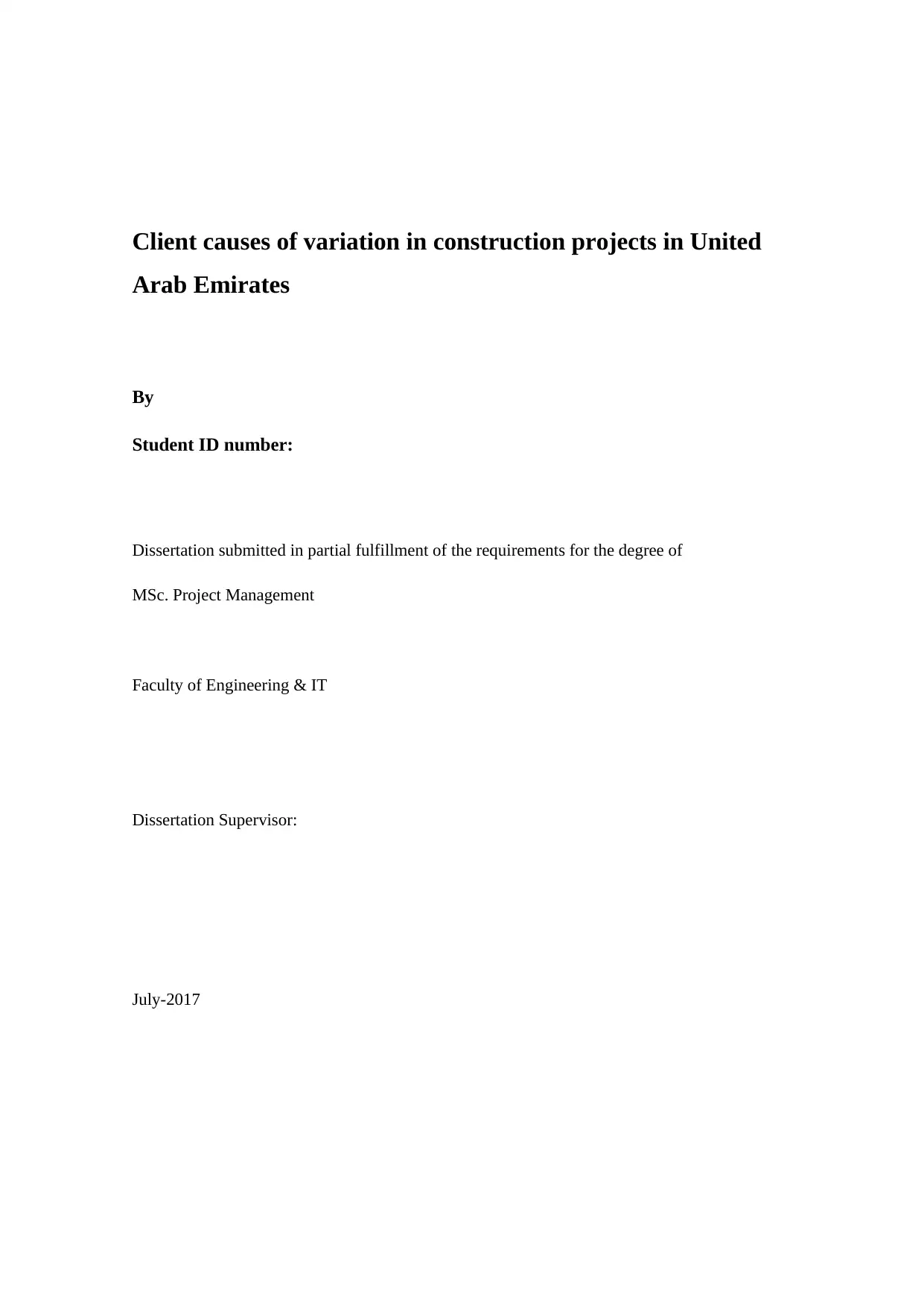
Client causes of variation in construction projects in United
Arab Emirates
By
Student ID number:
Dissertation submitted in partial fulfillment of the requirements for the degree of
MSc. Project Management
Faculty of Engineering & IT
Dissertation Supervisor:
July-2017
Arab Emirates
By
Student ID number:
Dissertation submitted in partial fulfillment of the requirements for the degree of
MSc. Project Management
Faculty of Engineering & IT
Dissertation Supervisor:
July-2017
Secure Best Marks with AI Grader
Need help grading? Try our AI Grader for instant feedback on your assignments.
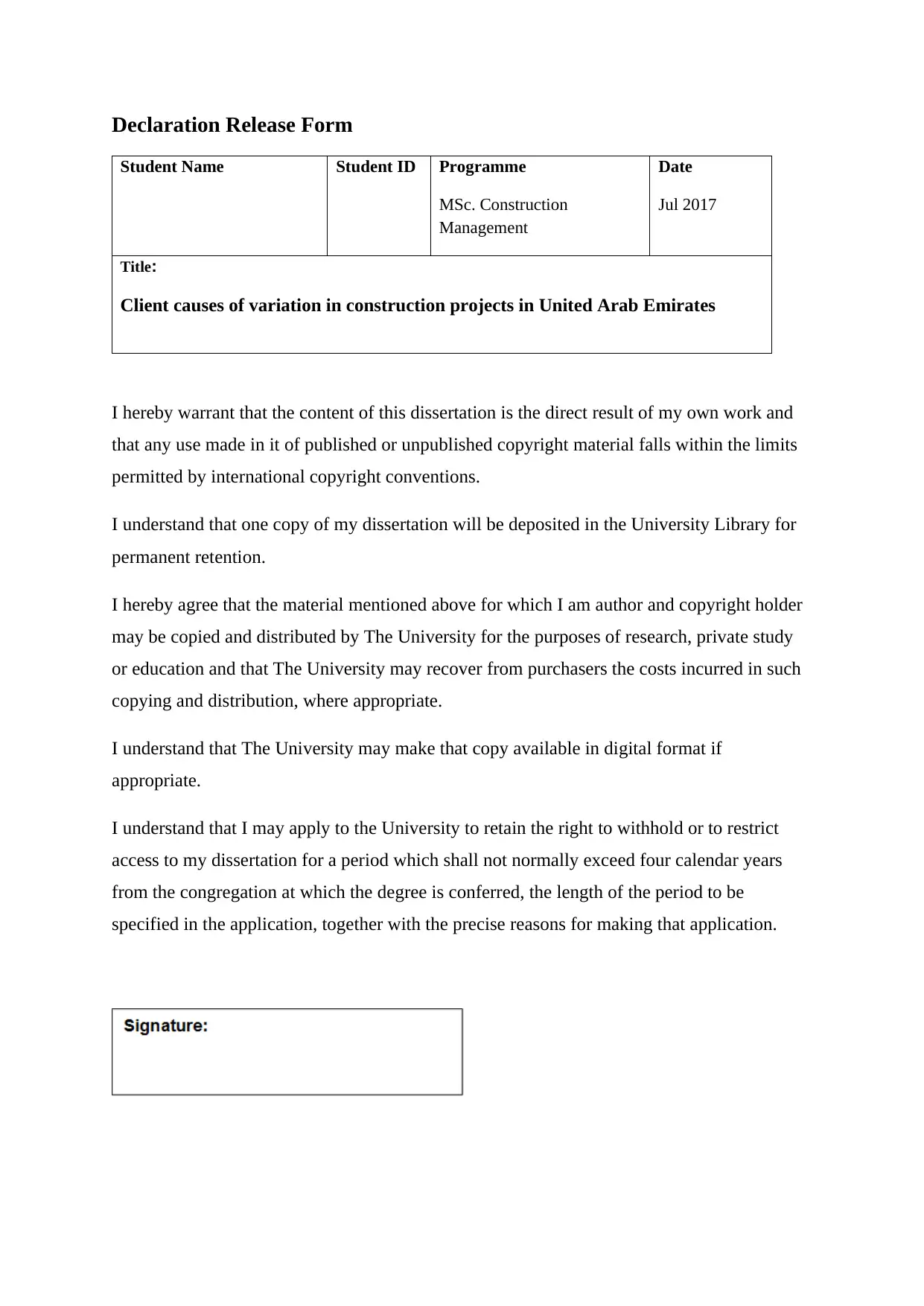
Declaration Release Form
Student Name Student ID Programme
MSc. Construction
Management
Date
Jul 2017
Title:
Client causes of variation in construction projects in United Arab Emirates
I hereby warrant that the content of this dissertation is the direct result of my own work and
that any use made in it of published or unpublished copyright material falls within the limits
permitted by international copyright conventions.
I understand that one copy of my dissertation will be deposited in the University Library for
permanent retention.
I hereby agree that the material mentioned above for which I am author and copyright holder
may be copied and distributed by The University for the purposes of research, private study
or education and that The University may recover from purchasers the costs incurred in such
copying and distribution, where appropriate.
I understand that The University may make that copy available in digital format if
appropriate.
I understand that I may apply to the University to retain the right to withhold or to restrict
access to my dissertation for a period which shall not normally exceed four calendar years
from the congregation at which the degree is conferred, the length of the period to be
specified in the application, together with the precise reasons for making that application.
Student Name Student ID Programme
MSc. Construction
Management
Date
Jul 2017
Title:
Client causes of variation in construction projects in United Arab Emirates
I hereby warrant that the content of this dissertation is the direct result of my own work and
that any use made in it of published or unpublished copyright material falls within the limits
permitted by international copyright conventions.
I understand that one copy of my dissertation will be deposited in the University Library for
permanent retention.
I hereby agree that the material mentioned above for which I am author and copyright holder
may be copied and distributed by The University for the purposes of research, private study
or education and that The University may recover from purchasers the costs incurred in such
copying and distribution, where appropriate.
I understand that The University may make that copy available in digital format if
appropriate.
I understand that I may apply to the University to retain the right to withhold or to restrict
access to my dissertation for a period which shall not normally exceed four calendar years
from the congregation at which the degree is conferred, the length of the period to be
specified in the application, together with the precise reasons for making that application.

1
Acknowledgement
Page 1
Student ID #:
Acknowledgement
Page 1
Student ID #:

2
Abstract
\
keywords:
Page 2
Student ID #:
Abstract
\
keywords:
Page 2
Student ID #:
Secure Best Marks with AI Grader
Need help grading? Try our AI Grader for instant feedback on your assignments.

3
Abbreviations
Page 3
Student ID #:
Abbreviations
Page 3
Student ID #:
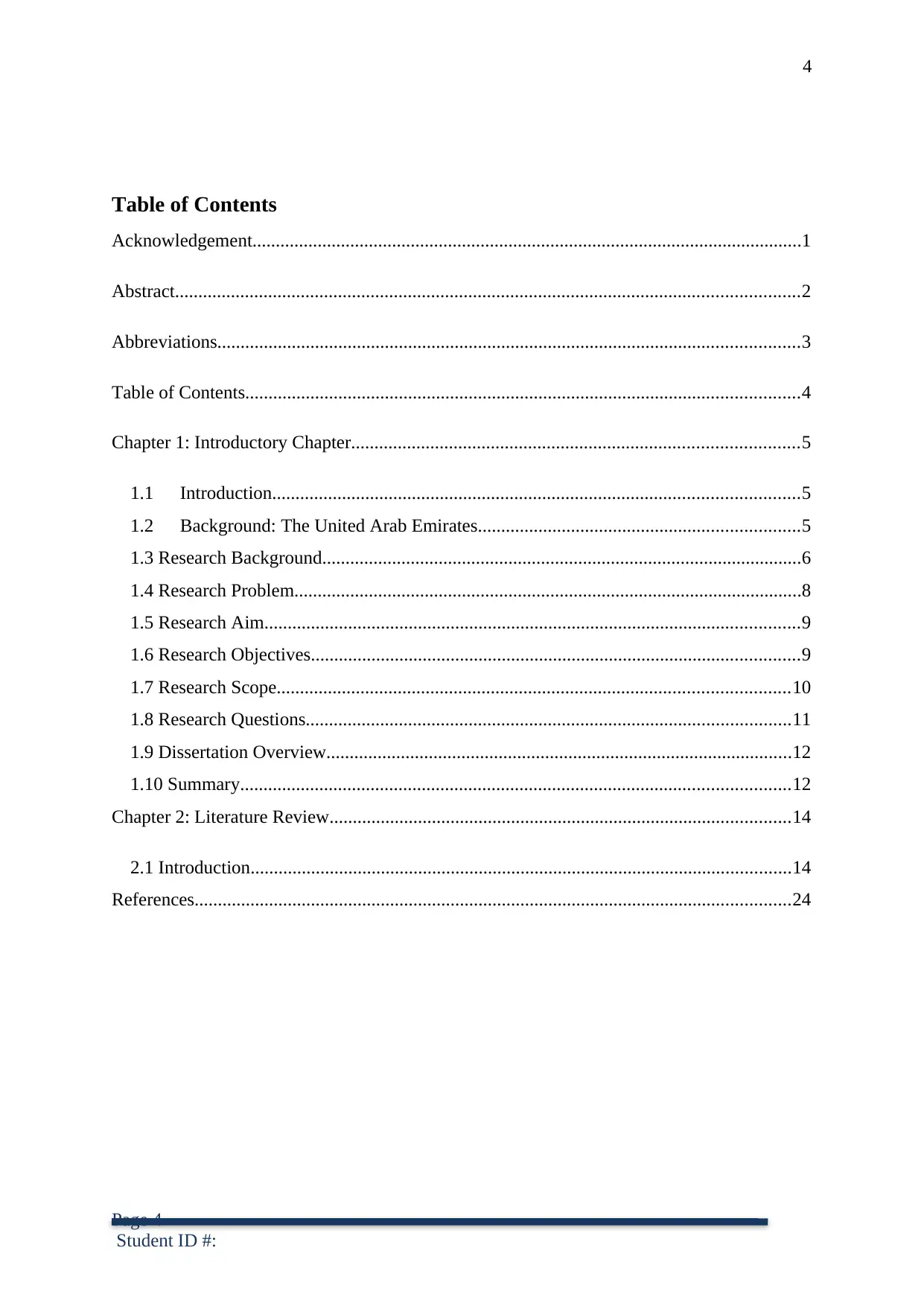
4
Table of Contents
Acknowledgement......................................................................................................................1
Abstract......................................................................................................................................2
Abbreviations.............................................................................................................................3
Table of Contents.......................................................................................................................4
Chapter 1: Introductory Chapter................................................................................................5
1.1 Introduction.................................................................................................................5
1.2 Background: The United Arab Emirates.....................................................................5
1.3 Research Background.......................................................................................................6
1.4 Research Problem.............................................................................................................8
1.5 Research Aim...................................................................................................................9
1.6 Research Objectives.........................................................................................................9
1.7 Research Scope..............................................................................................................10
1.8 Research Questions........................................................................................................11
1.9 Dissertation Overview....................................................................................................12
1.10 Summary......................................................................................................................12
Chapter 2: Literature Review...................................................................................................14
2.1 Introduction....................................................................................................................14
References................................................................................................................................24
Page 4
Student ID #:
Table of Contents
Acknowledgement......................................................................................................................1
Abstract......................................................................................................................................2
Abbreviations.............................................................................................................................3
Table of Contents.......................................................................................................................4
Chapter 1: Introductory Chapter................................................................................................5
1.1 Introduction.................................................................................................................5
1.2 Background: The United Arab Emirates.....................................................................5
1.3 Research Background.......................................................................................................6
1.4 Research Problem.............................................................................................................8
1.5 Research Aim...................................................................................................................9
1.6 Research Objectives.........................................................................................................9
1.7 Research Scope..............................................................................................................10
1.8 Research Questions........................................................................................................11
1.9 Dissertation Overview....................................................................................................12
1.10 Summary......................................................................................................................12
Chapter 2: Literature Review...................................................................................................14
2.1 Introduction....................................................................................................................14
References................................................................................................................................24
Page 4
Student ID #:
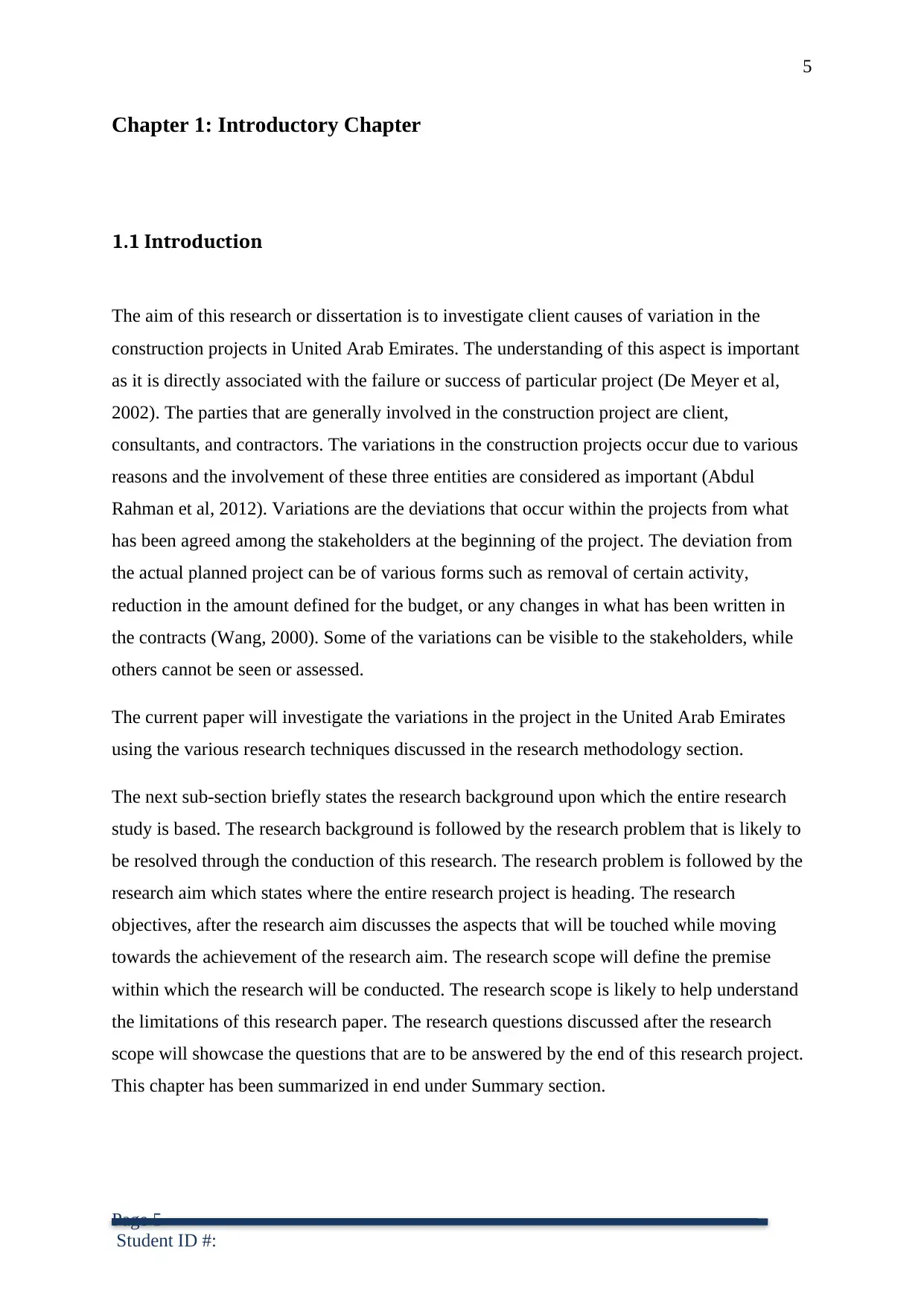
5
Chapter 1: Introductory Chapter
1.1 Introduction
The aim of this research or dissertation is to investigate client causes of variation in the
construction projects in United Arab Emirates. The understanding of this aspect is important
as it is directly associated with the failure or success of particular project (De Meyer et al,
2002). The parties that are generally involved in the construction project are client,
consultants, and contractors. The variations in the construction projects occur due to various
reasons and the involvement of these three entities are considered as important (Abdul
Rahman et al, 2012). Variations are the deviations that occur within the projects from what
has been agreed among the stakeholders at the beginning of the project. The deviation from
the actual planned project can be of various forms such as removal of certain activity,
reduction in the amount defined for the budget, or any changes in what has been written in
the contracts (Wang, 2000). Some of the variations can be visible to the stakeholders, while
others cannot be seen or assessed.
The current paper will investigate the variations in the project in the United Arab Emirates
using the various research techniques discussed in the research methodology section.
The next sub-section briefly states the research background upon which the entire research
study is based. The research background is followed by the research problem that is likely to
be resolved through the conduction of this research. The research problem is followed by the
research aim which states where the entire research project is heading. The research
objectives, after the research aim discusses the aspects that will be touched while moving
towards the achievement of the research aim. The research scope will define the premise
within which the research will be conducted. The research scope is likely to help understand
the limitations of this research paper. The research questions discussed after the research
scope will showcase the questions that are to be answered by the end of this research project.
This chapter has been summarized in end under Summary section.
Page 5
Student ID #:
Chapter 1: Introductory Chapter
1.1 Introduction
The aim of this research or dissertation is to investigate client causes of variation in the
construction projects in United Arab Emirates. The understanding of this aspect is important
as it is directly associated with the failure or success of particular project (De Meyer et al,
2002). The parties that are generally involved in the construction project are client,
consultants, and contractors. The variations in the construction projects occur due to various
reasons and the involvement of these three entities are considered as important (Abdul
Rahman et al, 2012). Variations are the deviations that occur within the projects from what
has been agreed among the stakeholders at the beginning of the project. The deviation from
the actual planned project can be of various forms such as removal of certain activity,
reduction in the amount defined for the budget, or any changes in what has been written in
the contracts (Wang, 2000). Some of the variations can be visible to the stakeholders, while
others cannot be seen or assessed.
The current paper will investigate the variations in the project in the United Arab Emirates
using the various research techniques discussed in the research methodology section.
The next sub-section briefly states the research background upon which the entire research
study is based. The research background is followed by the research problem that is likely to
be resolved through the conduction of this research. The research problem is followed by the
research aim which states where the entire research project is heading. The research
objectives, after the research aim discusses the aspects that will be touched while moving
towards the achievement of the research aim. The research scope will define the premise
within which the research will be conducted. The research scope is likely to help understand
the limitations of this research paper. The research questions discussed after the research
scope will showcase the questions that are to be answered by the end of this research project.
This chapter has been summarized in end under Summary section.
Page 5
Student ID #:
Paraphrase This Document
Need a fresh take? Get an instant paraphrase of this document with our AI Paraphraser
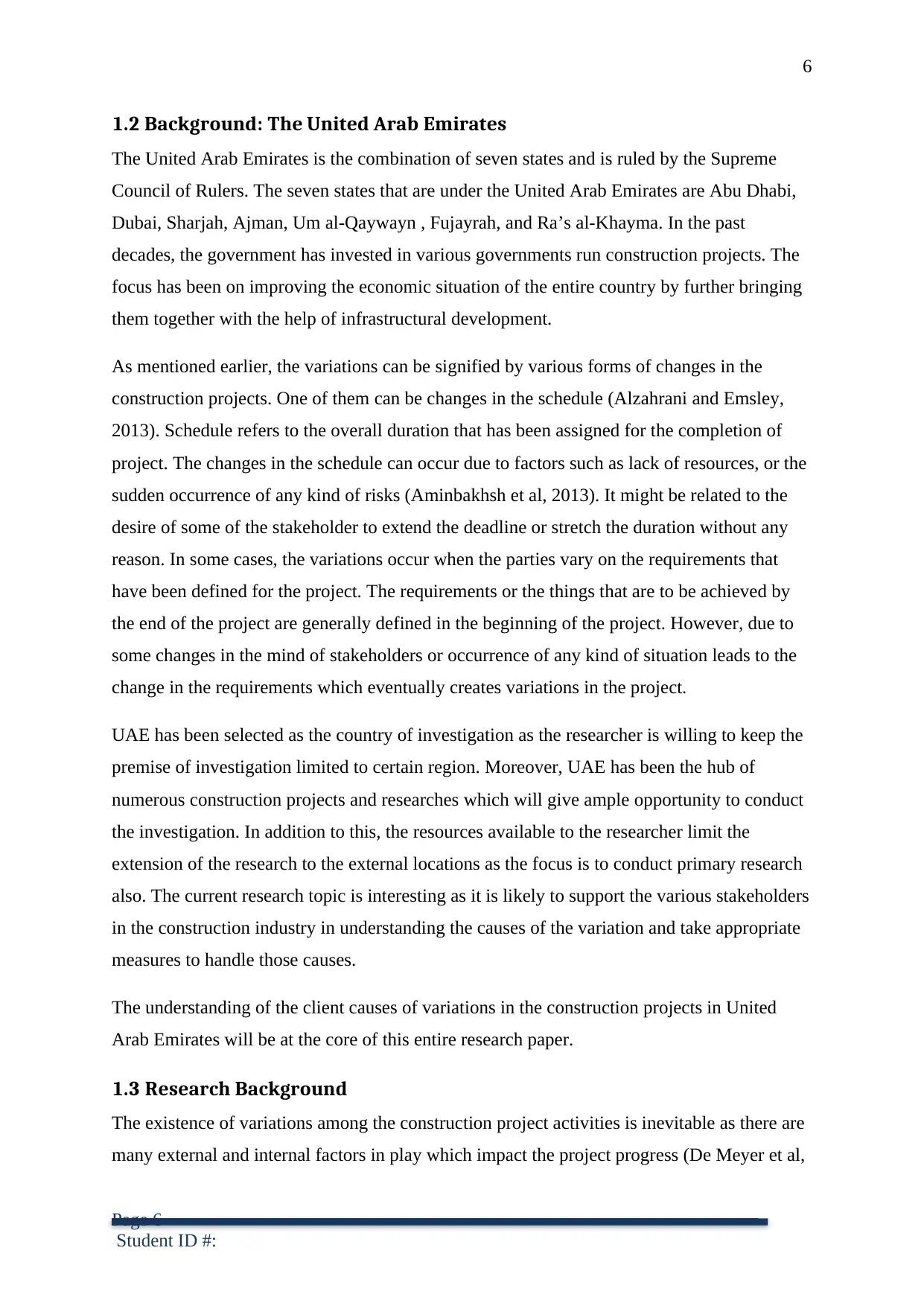
6
1.2 Background: The United Arab Emirates
The United Arab Emirates is the combination of seven states and is ruled by the Supreme
Council of Rulers. The seven states that are under the United Arab Emirates are Abu Dhabi,
Dubai, Sharjah, Ajman, Um al-Qaywayn , Fujayrah, and Ra’s al-Khayma. In the past
decades, the government has invested in various governments run construction projects. The
focus has been on improving the economic situation of the entire country by further bringing
them together with the help of infrastructural development.
As mentioned earlier, the variations can be signified by various forms of changes in the
construction projects. One of them can be changes in the schedule (Alzahrani and Emsley,
2013). Schedule refers to the overall duration that has been assigned for the completion of
project. The changes in the schedule can occur due to factors such as lack of resources, or the
sudden occurrence of any kind of risks (Aminbakhsh et al, 2013). It might be related to the
desire of some of the stakeholder to extend the deadline or stretch the duration without any
reason. In some cases, the variations occur when the parties vary on the requirements that
have been defined for the project. The requirements or the things that are to be achieved by
the end of the project are generally defined in the beginning of the project. However, due to
some changes in the mind of stakeholders or occurrence of any kind of situation leads to the
change in the requirements which eventually creates variations in the project.
UAE has been selected as the country of investigation as the researcher is willing to keep the
premise of investigation limited to certain region. Moreover, UAE has been the hub of
numerous construction projects and researches which will give ample opportunity to conduct
the investigation. In addition to this, the resources available to the researcher limit the
extension of the research to the external locations as the focus is to conduct primary research
also. The current research topic is interesting as it is likely to support the various stakeholders
in the construction industry in understanding the causes of the variation and take appropriate
measures to handle those causes.
The understanding of the client causes of variations in the construction projects in United
Arab Emirates will be at the core of this entire research paper.
1.3 Research Background
The existence of variations among the construction project activities is inevitable as there are
many external and internal factors in play which impact the project progress (De Meyer et al,
Page 6
Student ID #:
1.2 Background: The United Arab Emirates
The United Arab Emirates is the combination of seven states and is ruled by the Supreme
Council of Rulers. The seven states that are under the United Arab Emirates are Abu Dhabi,
Dubai, Sharjah, Ajman, Um al-Qaywayn , Fujayrah, and Ra’s al-Khayma. In the past
decades, the government has invested in various governments run construction projects. The
focus has been on improving the economic situation of the entire country by further bringing
them together with the help of infrastructural development.
As mentioned earlier, the variations can be signified by various forms of changes in the
construction projects. One of them can be changes in the schedule (Alzahrani and Emsley,
2013). Schedule refers to the overall duration that has been assigned for the completion of
project. The changes in the schedule can occur due to factors such as lack of resources, or the
sudden occurrence of any kind of risks (Aminbakhsh et al, 2013). It might be related to the
desire of some of the stakeholder to extend the deadline or stretch the duration without any
reason. In some cases, the variations occur when the parties vary on the requirements that
have been defined for the project. The requirements or the things that are to be achieved by
the end of the project are generally defined in the beginning of the project. However, due to
some changes in the mind of stakeholders or occurrence of any kind of situation leads to the
change in the requirements which eventually creates variations in the project.
UAE has been selected as the country of investigation as the researcher is willing to keep the
premise of investigation limited to certain region. Moreover, UAE has been the hub of
numerous construction projects and researches which will give ample opportunity to conduct
the investigation. In addition to this, the resources available to the researcher limit the
extension of the research to the external locations as the focus is to conduct primary research
also. The current research topic is interesting as it is likely to support the various stakeholders
in the construction industry in understanding the causes of the variation and take appropriate
measures to handle those causes.
The understanding of the client causes of variations in the construction projects in United
Arab Emirates will be at the core of this entire research paper.
1.3 Research Background
The existence of variations among the construction project activities is inevitable as there are
many external and internal factors in play which impact the project progress (De Meyer et al,
Page 6
Student ID #:
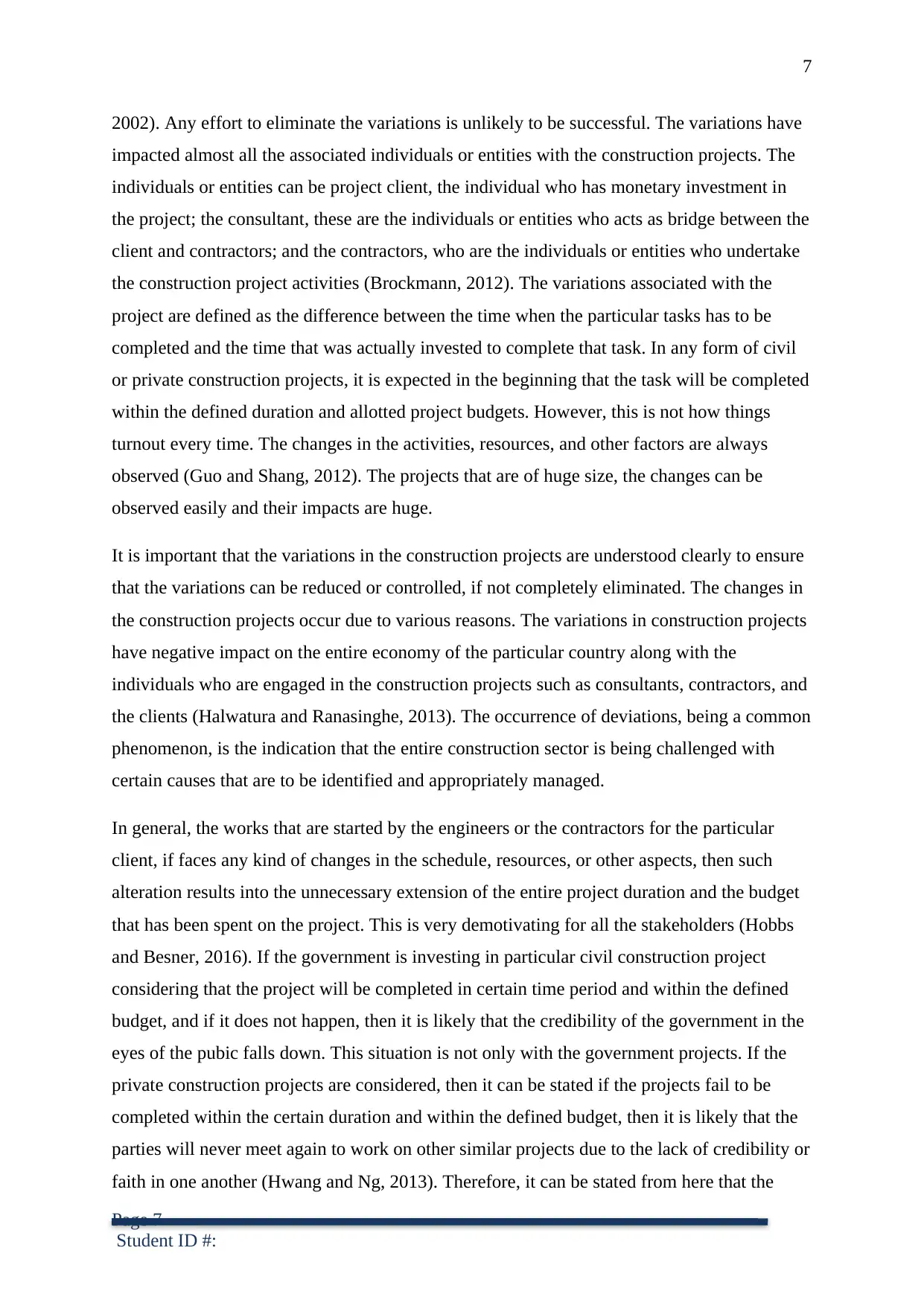
7
2002). Any effort to eliminate the variations is unlikely to be successful. The variations have
impacted almost all the associated individuals or entities with the construction projects. The
individuals or entities can be project client, the individual who has monetary investment in
the project; the consultant, these are the individuals or entities who acts as bridge between the
client and contractors; and the contractors, who are the individuals or entities who undertake
the construction project activities (Brockmann, 2012). The variations associated with the
project are defined as the difference between the time when the particular tasks has to be
completed and the time that was actually invested to complete that task. In any form of civil
or private construction projects, it is expected in the beginning that the task will be completed
within the defined duration and allotted project budgets. However, this is not how things
turnout every time. The changes in the activities, resources, and other factors are always
observed (Guo and Shang, 2012). The projects that are of huge size, the changes can be
observed easily and their impacts are huge.
It is important that the variations in the construction projects are understood clearly to ensure
that the variations can be reduced or controlled, if not completely eliminated. The changes in
the construction projects occur due to various reasons. The variations in construction projects
have negative impact on the entire economy of the particular country along with the
individuals who are engaged in the construction projects such as consultants, contractors, and
the clients (Halwatura and Ranasinghe, 2013). The occurrence of deviations, being a common
phenomenon, is the indication that the entire construction sector is being challenged with
certain causes that are to be identified and appropriately managed.
In general, the works that are started by the engineers or the contractors for the particular
client, if faces any kind of changes in the schedule, resources, or other aspects, then such
alteration results into the unnecessary extension of the entire project duration and the budget
that has been spent on the project. This is very demotivating for all the stakeholders (Hobbs
and Besner, 2016). If the government is investing in particular civil construction project
considering that the project will be completed in certain time period and within the defined
budget, and if it does not happen, then it is likely that the credibility of the government in the
eyes of the pubic falls down. This situation is not only with the government projects. If the
private construction projects are considered, then it can be stated if the projects fail to be
completed within the certain duration and within the defined budget, then it is likely that the
parties will never meet again to work on other similar projects due to the lack of credibility or
faith in one another (Hwang and Ng, 2013). Therefore, it can be stated from here that the
Page 7
Student ID #:
2002). Any effort to eliminate the variations is unlikely to be successful. The variations have
impacted almost all the associated individuals or entities with the construction projects. The
individuals or entities can be project client, the individual who has monetary investment in
the project; the consultant, these are the individuals or entities who acts as bridge between the
client and contractors; and the contractors, who are the individuals or entities who undertake
the construction project activities (Brockmann, 2012). The variations associated with the
project are defined as the difference between the time when the particular tasks has to be
completed and the time that was actually invested to complete that task. In any form of civil
or private construction projects, it is expected in the beginning that the task will be completed
within the defined duration and allotted project budgets. However, this is not how things
turnout every time. The changes in the activities, resources, and other factors are always
observed (Guo and Shang, 2012). The projects that are of huge size, the changes can be
observed easily and their impacts are huge.
It is important that the variations in the construction projects are understood clearly to ensure
that the variations can be reduced or controlled, if not completely eliminated. The changes in
the construction projects occur due to various reasons. The variations in construction projects
have negative impact on the entire economy of the particular country along with the
individuals who are engaged in the construction projects such as consultants, contractors, and
the clients (Halwatura and Ranasinghe, 2013). The occurrence of deviations, being a common
phenomenon, is the indication that the entire construction sector is being challenged with
certain causes that are to be identified and appropriately managed.
In general, the works that are started by the engineers or the contractors for the particular
client, if faces any kind of changes in the schedule, resources, or other aspects, then such
alteration results into the unnecessary extension of the entire project duration and the budget
that has been spent on the project. This is very demotivating for all the stakeholders (Hobbs
and Besner, 2016). If the government is investing in particular civil construction project
considering that the project will be completed in certain time period and within the defined
budget, and if it does not happen, then it is likely that the credibility of the government in the
eyes of the pubic falls down. This situation is not only with the government projects. If the
private construction projects are considered, then it can be stated if the projects fail to be
completed within the certain duration and within the defined budget, then it is likely that the
parties will never meet again to work on other similar projects due to the lack of credibility or
faith in one another (Hwang and Ng, 2013). Therefore, it can be stated from here that the
Page 7
Student ID #:
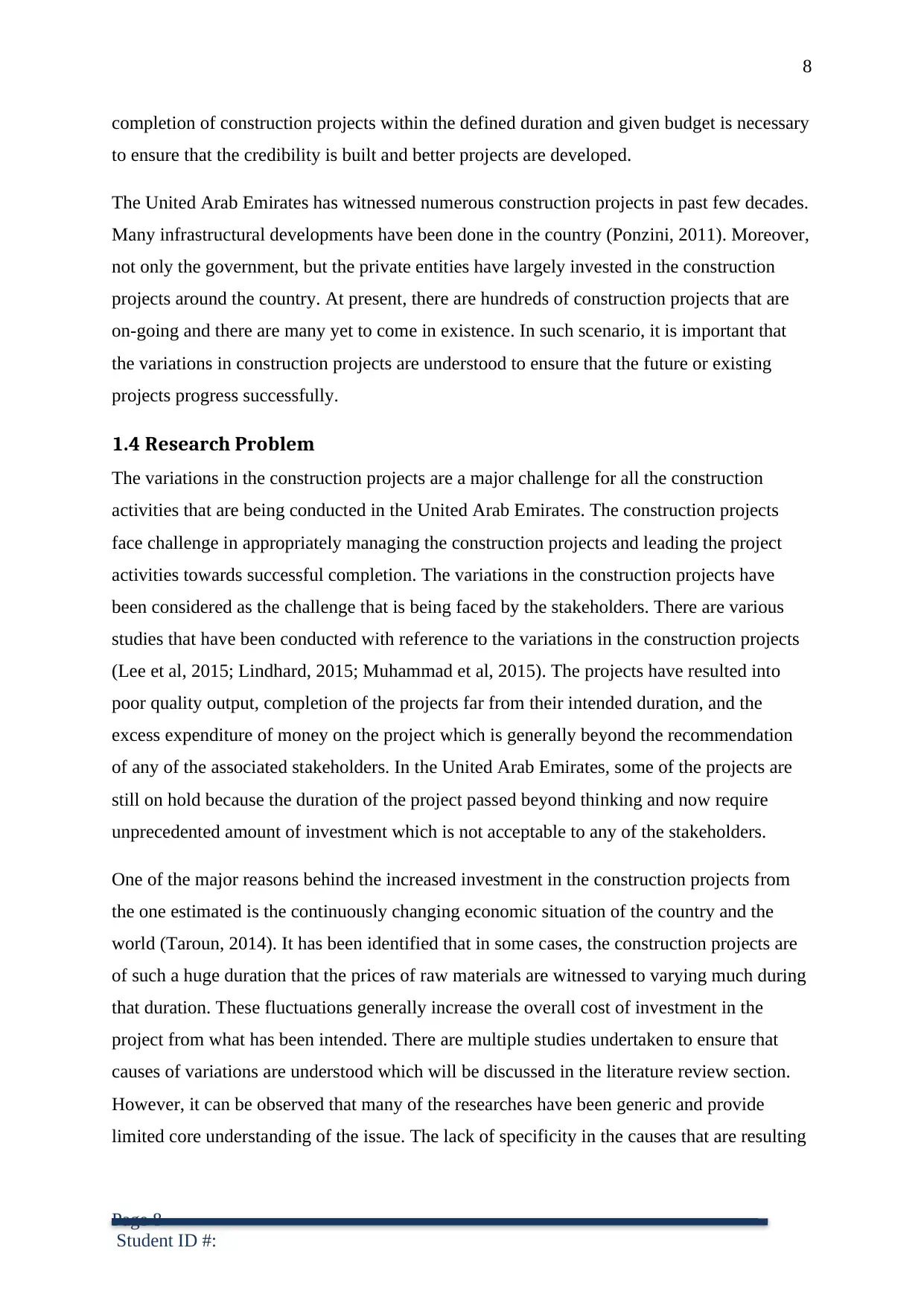
8
completion of construction projects within the defined duration and given budget is necessary
to ensure that the credibility is built and better projects are developed.
The United Arab Emirates has witnessed numerous construction projects in past few decades.
Many infrastructural developments have been done in the country (Ponzini, 2011). Moreover,
not only the government, but the private entities have largely invested in the construction
projects around the country. At present, there are hundreds of construction projects that are
on-going and there are many yet to come in existence. In such scenario, it is important that
the variations in construction projects are understood to ensure that the future or existing
projects progress successfully.
1.4 Research Problem
The variations in the construction projects are a major challenge for all the construction
activities that are being conducted in the United Arab Emirates. The construction projects
face challenge in appropriately managing the construction projects and leading the project
activities towards successful completion. The variations in the construction projects have
been considered as the challenge that is being faced by the stakeholders. There are various
studies that have been conducted with reference to the variations in the construction projects
(Lee et al, 2015; Lindhard, 2015; Muhammad et al, 2015). The projects have resulted into
poor quality output, completion of the projects far from their intended duration, and the
excess expenditure of money on the project which is generally beyond the recommendation
of any of the associated stakeholders. In the United Arab Emirates, some of the projects are
still on hold because the duration of the project passed beyond thinking and now require
unprecedented amount of investment which is not acceptable to any of the stakeholders.
One of the major reasons behind the increased investment in the construction projects from
the one estimated is the continuously changing economic situation of the country and the
world (Taroun, 2014). It has been identified that in some cases, the construction projects are
of such a huge duration that the prices of raw materials are witnessed to varying much during
that duration. These fluctuations generally increase the overall cost of investment in the
project from what has been intended. There are multiple studies undertaken to ensure that
causes of variations are understood which will be discussed in the literature review section.
However, it can be observed that many of the researches have been generic and provide
limited core understanding of the issue. The lack of specificity in the causes that are resulting
Page 8
Student ID #:
completion of construction projects within the defined duration and given budget is necessary
to ensure that the credibility is built and better projects are developed.
The United Arab Emirates has witnessed numerous construction projects in past few decades.
Many infrastructural developments have been done in the country (Ponzini, 2011). Moreover,
not only the government, but the private entities have largely invested in the construction
projects around the country. At present, there are hundreds of construction projects that are
on-going and there are many yet to come in existence. In such scenario, it is important that
the variations in construction projects are understood to ensure that the future or existing
projects progress successfully.
1.4 Research Problem
The variations in the construction projects are a major challenge for all the construction
activities that are being conducted in the United Arab Emirates. The construction projects
face challenge in appropriately managing the construction projects and leading the project
activities towards successful completion. The variations in the construction projects have
been considered as the challenge that is being faced by the stakeholders. There are various
studies that have been conducted with reference to the variations in the construction projects
(Lee et al, 2015; Lindhard, 2015; Muhammad et al, 2015). The projects have resulted into
poor quality output, completion of the projects far from their intended duration, and the
excess expenditure of money on the project which is generally beyond the recommendation
of any of the associated stakeholders. In the United Arab Emirates, some of the projects are
still on hold because the duration of the project passed beyond thinking and now require
unprecedented amount of investment which is not acceptable to any of the stakeholders.
One of the major reasons behind the increased investment in the construction projects from
the one estimated is the continuously changing economic situation of the country and the
world (Taroun, 2014). It has been identified that in some cases, the construction projects are
of such a huge duration that the prices of raw materials are witnessed to varying much during
that duration. These fluctuations generally increase the overall cost of investment in the
project from what has been intended. There are multiple studies undertaken to ensure that
causes of variations are understood which will be discussed in the literature review section.
However, it can be observed that many of the researches have been generic and provide
limited core understanding of the issue. The lack of specificity in the causes that are resulting
Page 8
Student ID #:
Secure Best Marks with AI Grader
Need help grading? Try our AI Grader for instant feedback on your assignments.
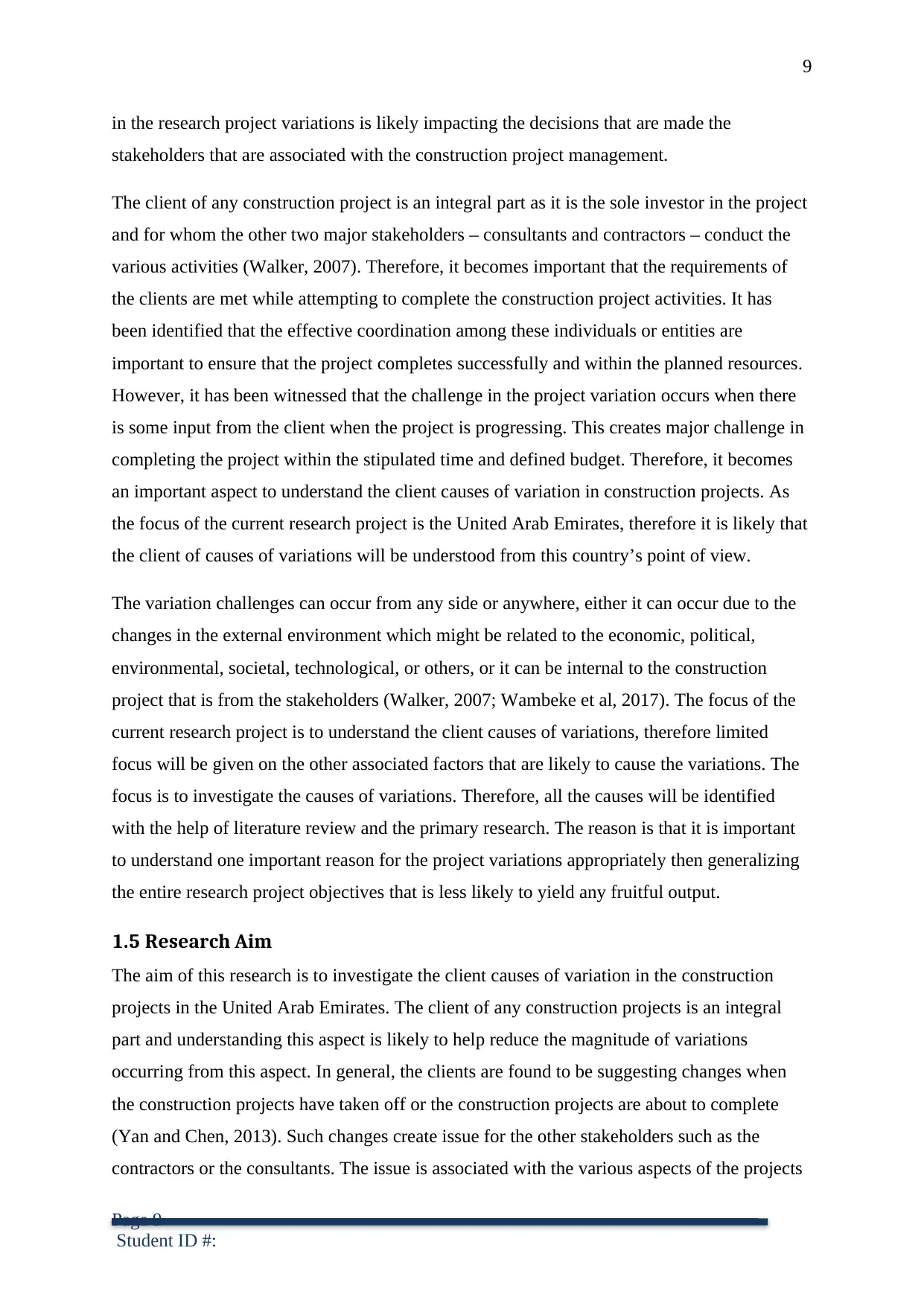
9
in the research project variations is likely impacting the decisions that are made the
stakeholders that are associated with the construction project management.
The client of any construction project is an integral part as it is the sole investor in the project
and for whom the other two major stakeholders – consultants and contractors – conduct the
various activities (Walker, 2007). Therefore, it becomes important that the requirements of
the clients are met while attempting to complete the construction project activities. It has
been identified that the effective coordination among these individuals or entities are
important to ensure that the project completes successfully and within the planned resources.
However, it has been witnessed that the challenge in the project variation occurs when there
is some input from the client when the project is progressing. This creates major challenge in
completing the project within the stipulated time and defined budget. Therefore, it becomes
an important aspect to understand the client causes of variation in construction projects. As
the focus of the current research project is the United Arab Emirates, therefore it is likely that
the client of causes of variations will be understood from this country’s point of view.
The variation challenges can occur from any side or anywhere, either it can occur due to the
changes in the external environment which might be related to the economic, political,
environmental, societal, technological, or others, or it can be internal to the construction
project that is from the stakeholders (Walker, 2007; Wambeke et al, 2017). The focus of the
current research project is to understand the client causes of variations, therefore limited
focus will be given on the other associated factors that are likely to cause the variations. The
focus is to investigate the causes of variations. Therefore, all the causes will be identified
with the help of literature review and the primary research. The reason is that it is important
to understand one important reason for the project variations appropriately then generalizing
the entire research project objectives that is less likely to yield any fruitful output.
1.5 Research Aim
The aim of this research is to investigate the client causes of variation in the construction
projects in the United Arab Emirates. The client of any construction projects is an integral
part and understanding this aspect is likely to help reduce the magnitude of variations
occurring from this aspect. In general, the clients are found to be suggesting changes when
the construction projects have taken off or the construction projects are about to complete
(Yan and Chen, 2013). Such changes create issue for the other stakeholders such as the
contractors or the consultants. The issue is associated with the various aspects of the projects
Page 9
Student ID #:
in the research project variations is likely impacting the decisions that are made the
stakeholders that are associated with the construction project management.
The client of any construction project is an integral part as it is the sole investor in the project
and for whom the other two major stakeholders – consultants and contractors – conduct the
various activities (Walker, 2007). Therefore, it becomes important that the requirements of
the clients are met while attempting to complete the construction project activities. It has
been identified that the effective coordination among these individuals or entities are
important to ensure that the project completes successfully and within the planned resources.
However, it has been witnessed that the challenge in the project variation occurs when there
is some input from the client when the project is progressing. This creates major challenge in
completing the project within the stipulated time and defined budget. Therefore, it becomes
an important aspect to understand the client causes of variation in construction projects. As
the focus of the current research project is the United Arab Emirates, therefore it is likely that
the client of causes of variations will be understood from this country’s point of view.
The variation challenges can occur from any side or anywhere, either it can occur due to the
changes in the external environment which might be related to the economic, political,
environmental, societal, technological, or others, or it can be internal to the construction
project that is from the stakeholders (Walker, 2007; Wambeke et al, 2017). The focus of the
current research project is to understand the client causes of variations, therefore limited
focus will be given on the other associated factors that are likely to cause the variations. The
focus is to investigate the causes of variations. Therefore, all the causes will be identified
with the help of literature review and the primary research. The reason is that it is important
to understand one important reason for the project variations appropriately then generalizing
the entire research project objectives that is less likely to yield any fruitful output.
1.5 Research Aim
The aim of this research is to investigate the client causes of variation in the construction
projects in the United Arab Emirates. The client of any construction projects is an integral
part and understanding this aspect is likely to help reduce the magnitude of variations
occurring from this aspect. In general, the clients are found to be suggesting changes when
the construction projects have taken off or the construction projects are about to complete
(Yan and Chen, 2013). Such changes create issue for the other stakeholders such as the
contractors or the consultants. The issue is associated with the various aspects of the projects
Page 9
Student ID #:
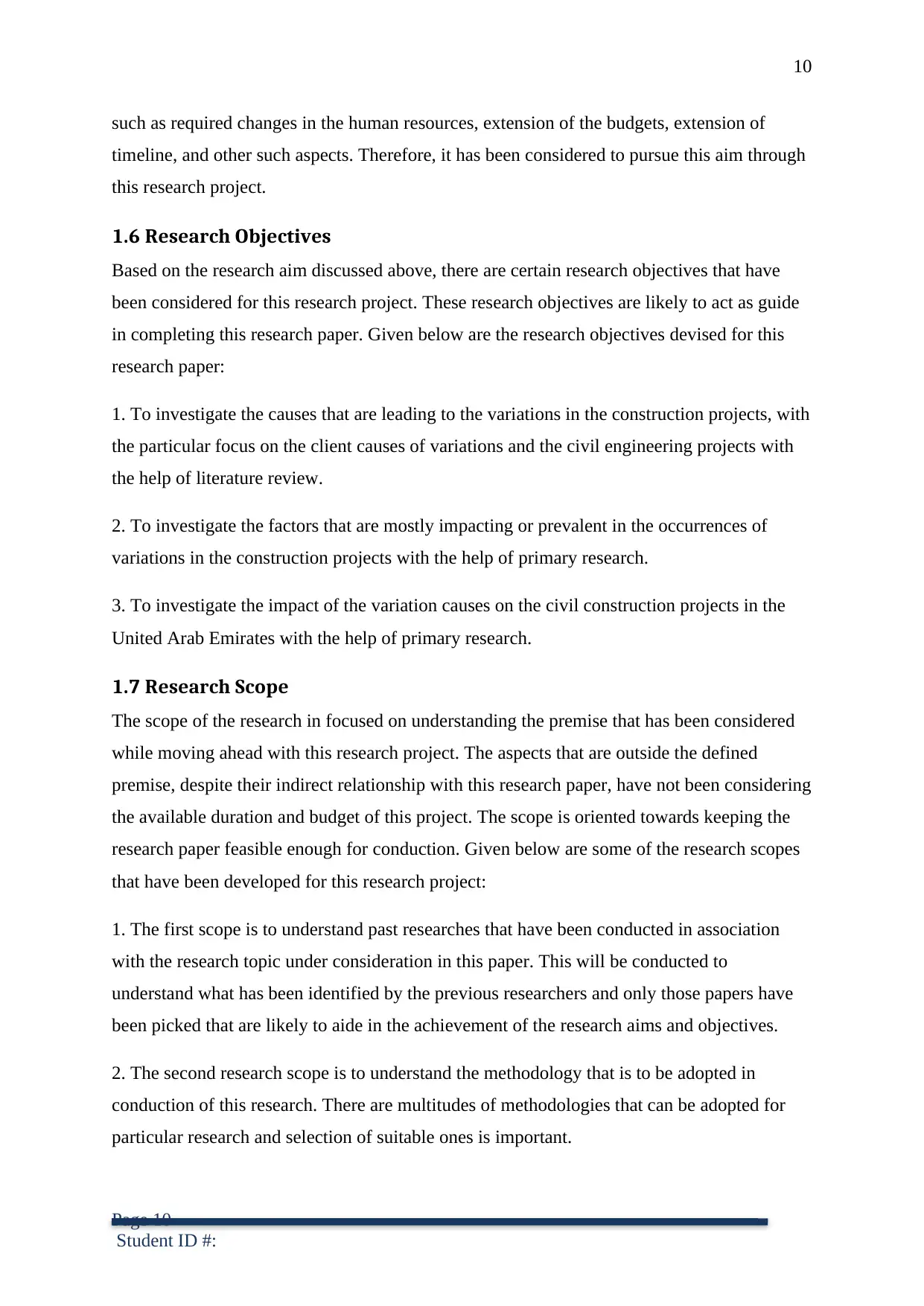
10
such as required changes in the human resources, extension of the budgets, extension of
timeline, and other such aspects. Therefore, it has been considered to pursue this aim through
this research project.
1.6 Research Objectives
Based on the research aim discussed above, there are certain research objectives that have
been considered for this research project. These research objectives are likely to act as guide
in completing this research paper. Given below are the research objectives devised for this
research paper:
1. To investigate the causes that are leading to the variations in the construction projects, with
the particular focus on the client causes of variations and the civil engineering projects with
the help of literature review.
2. To investigate the factors that are mostly impacting or prevalent in the occurrences of
variations in the construction projects with the help of primary research.
3. To investigate the impact of the variation causes on the civil construction projects in the
United Arab Emirates with the help of primary research.
1.7 Research Scope
The scope of the research in focused on understanding the premise that has been considered
while moving ahead with this research project. The aspects that are outside the defined
premise, despite their indirect relationship with this research paper, have not been considering
the available duration and budget of this project. The scope is oriented towards keeping the
research paper feasible enough for conduction. Given below are some of the research scopes
that have been developed for this research project:
1. The first scope is to understand past researches that have been conducted in association
with the research topic under consideration in this paper. This will be conducted to
understand what has been identified by the previous researchers and only those papers have
been picked that are likely to aide in the achievement of the research aims and objectives.
2. The second research scope is to understand the methodology that is to be adopted in
conduction of this research. There are multitudes of methodologies that can be adopted for
particular research and selection of suitable ones is important.
Page 10
Student ID #:
such as required changes in the human resources, extension of the budgets, extension of
timeline, and other such aspects. Therefore, it has been considered to pursue this aim through
this research project.
1.6 Research Objectives
Based on the research aim discussed above, there are certain research objectives that have
been considered for this research project. These research objectives are likely to act as guide
in completing this research paper. Given below are the research objectives devised for this
research paper:
1. To investigate the causes that are leading to the variations in the construction projects, with
the particular focus on the client causes of variations and the civil engineering projects with
the help of literature review.
2. To investigate the factors that are mostly impacting or prevalent in the occurrences of
variations in the construction projects with the help of primary research.
3. To investigate the impact of the variation causes on the civil construction projects in the
United Arab Emirates with the help of primary research.
1.7 Research Scope
The scope of the research in focused on understanding the premise that has been considered
while moving ahead with this research project. The aspects that are outside the defined
premise, despite their indirect relationship with this research paper, have not been considering
the available duration and budget of this project. The scope is oriented towards keeping the
research paper feasible enough for conduction. Given below are some of the research scopes
that have been developed for this research project:
1. The first scope is to understand past researches that have been conducted in association
with the research topic under consideration in this paper. This will be conducted to
understand what has been identified by the previous researchers and only those papers have
been picked that are likely to aide in the achievement of the research aims and objectives.
2. The second research scope is to understand the methodology that is to be adopted in
conduction of this research. There are multitudes of methodologies that can be adopted for
particular research and selection of suitable ones is important.
Page 10
Student ID #:
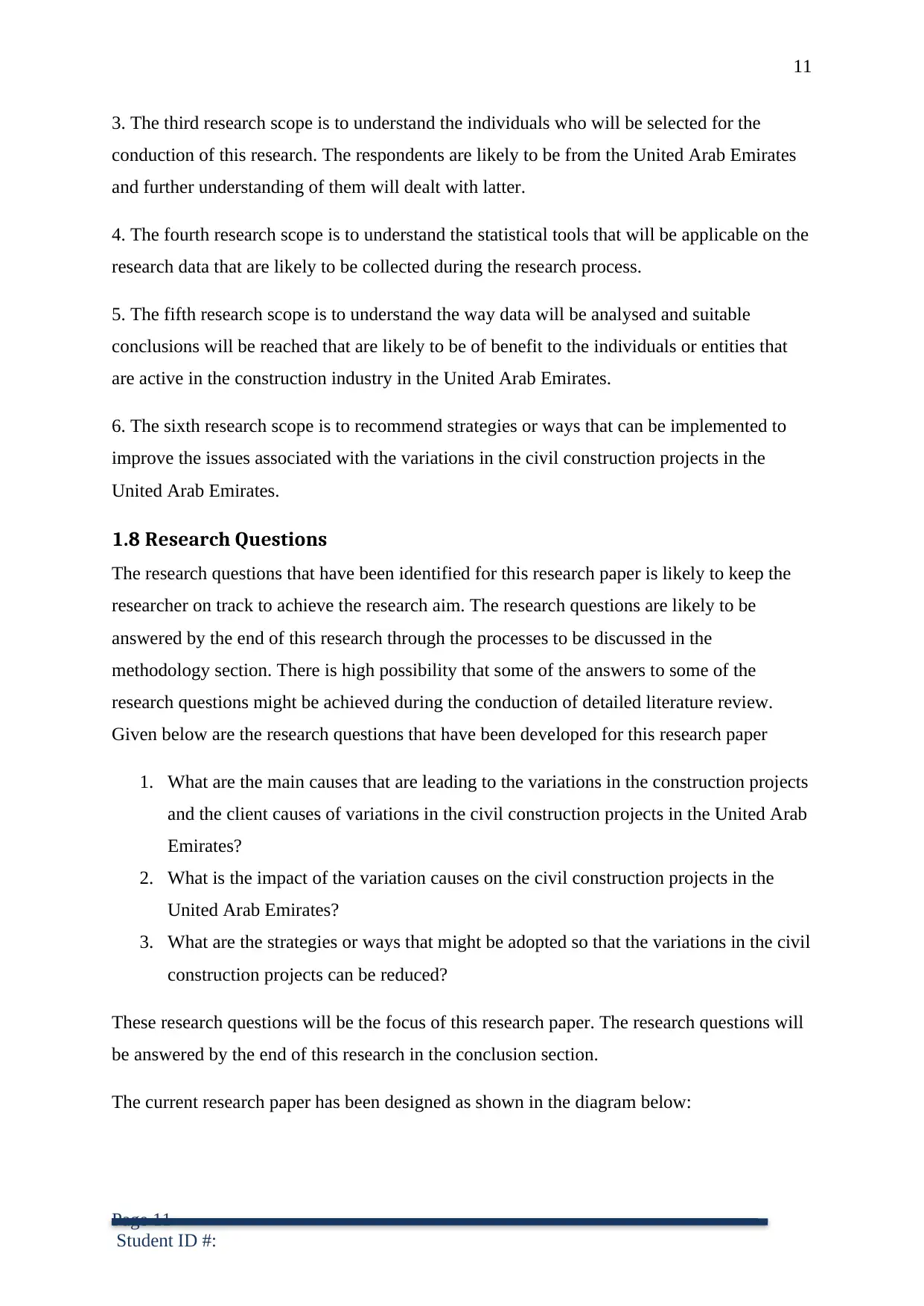
11
3. The third research scope is to understand the individuals who will be selected for the
conduction of this research. The respondents are likely to be from the United Arab Emirates
and further understanding of them will dealt with latter.
4. The fourth research scope is to understand the statistical tools that will be applicable on the
research data that are likely to be collected during the research process.
5. The fifth research scope is to understand the way data will be analysed and suitable
conclusions will be reached that are likely to be of benefit to the individuals or entities that
are active in the construction industry in the United Arab Emirates.
6. The sixth research scope is to recommend strategies or ways that can be implemented to
improve the issues associated with the variations in the civil construction projects in the
United Arab Emirates.
1.8 Research Questions
The research questions that have been identified for this research paper is likely to keep the
researcher on track to achieve the research aim. The research questions are likely to be
answered by the end of this research through the processes to be discussed in the
methodology section. There is high possibility that some of the answers to some of the
research questions might be achieved during the conduction of detailed literature review.
Given below are the research questions that have been developed for this research paper
1. What are the main causes that are leading to the variations in the construction projects
and the client causes of variations in the civil construction projects in the United Arab
Emirates?
2. What is the impact of the variation causes on the civil construction projects in the
United Arab Emirates?
3. What are the strategies or ways that might be adopted so that the variations in the civil
construction projects can be reduced?
These research questions will be the focus of this research paper. The research questions will
be answered by the end of this research in the conclusion section.
The current research paper has been designed as shown in the diagram below:
Page 11
Student ID #:
3. The third research scope is to understand the individuals who will be selected for the
conduction of this research. The respondents are likely to be from the United Arab Emirates
and further understanding of them will dealt with latter.
4. The fourth research scope is to understand the statistical tools that will be applicable on the
research data that are likely to be collected during the research process.
5. The fifth research scope is to understand the way data will be analysed and suitable
conclusions will be reached that are likely to be of benefit to the individuals or entities that
are active in the construction industry in the United Arab Emirates.
6. The sixth research scope is to recommend strategies or ways that can be implemented to
improve the issues associated with the variations in the civil construction projects in the
United Arab Emirates.
1.8 Research Questions
The research questions that have been identified for this research paper is likely to keep the
researcher on track to achieve the research aim. The research questions are likely to be
answered by the end of this research through the processes to be discussed in the
methodology section. There is high possibility that some of the answers to some of the
research questions might be achieved during the conduction of detailed literature review.
Given below are the research questions that have been developed for this research paper
1. What are the main causes that are leading to the variations in the construction projects
and the client causes of variations in the civil construction projects in the United Arab
Emirates?
2. What is the impact of the variation causes on the civil construction projects in the
United Arab Emirates?
3. What are the strategies or ways that might be adopted so that the variations in the civil
construction projects can be reduced?
These research questions will be the focus of this research paper. The research questions will
be answered by the end of this research in the conclusion section.
The current research paper has been designed as shown in the diagram below:
Page 11
Student ID #:
Paraphrase This Document
Need a fresh take? Get an instant paraphrase of this document with our AI Paraphraser
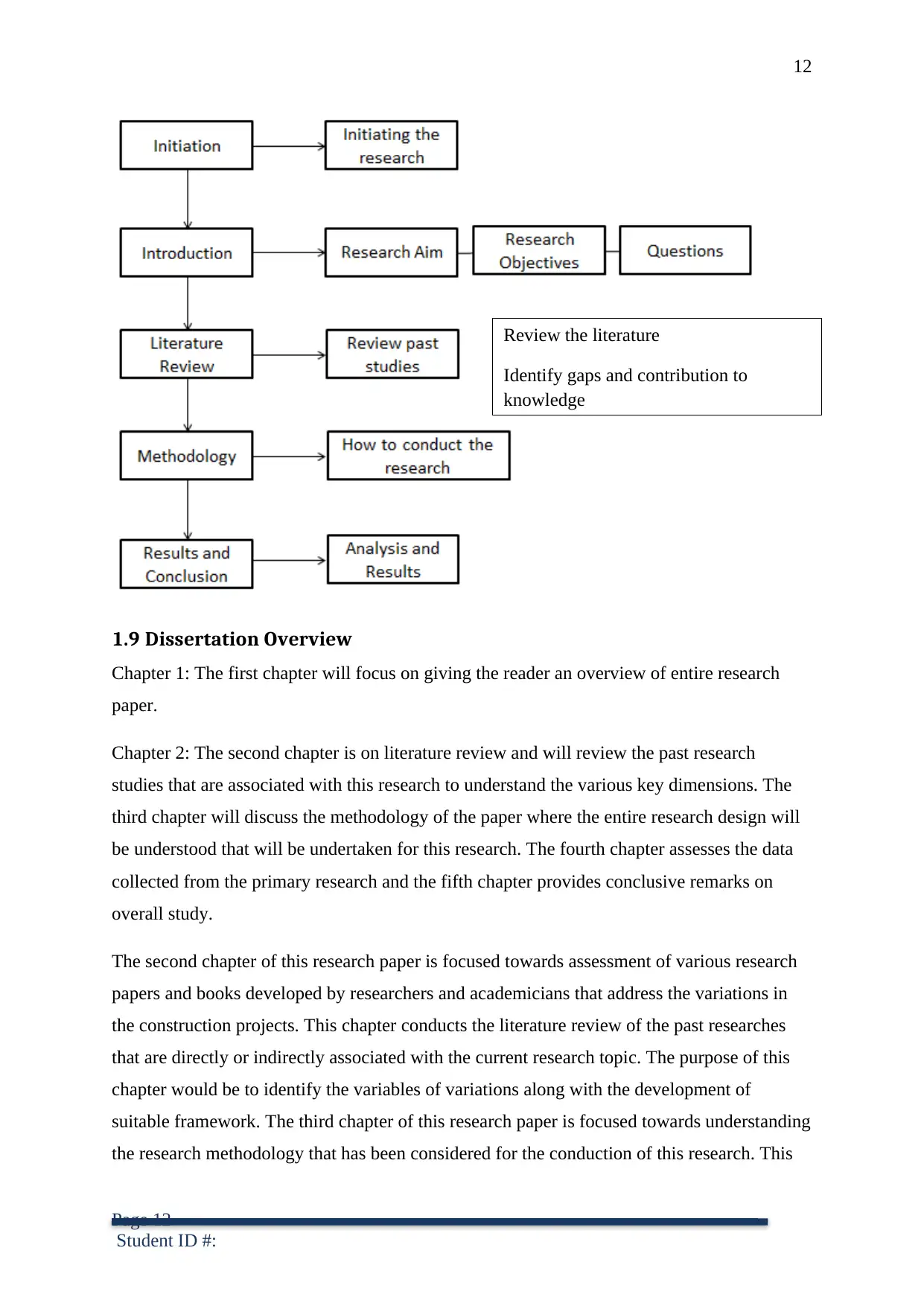
12
1.9 Dissertation Overview
Chapter 1: The first chapter will focus on giving the reader an overview of entire research
paper.
Chapter 2: The second chapter is on literature review and will review the past research
studies that are associated with this research to understand the various key dimensions. The
third chapter will discuss the methodology of the paper where the entire research design will
be understood that will be undertaken for this research. The fourth chapter assesses the data
collected from the primary research and the fifth chapter provides conclusive remarks on
overall study.
The second chapter of this research paper is focused towards assessment of various research
papers and books developed by researchers and academicians that address the variations in
the construction projects. This chapter conducts the literature review of the past researches
that are directly or indirectly associated with the current research topic. The purpose of this
chapter would be to identify the variables of variations along with the development of
suitable framework. The third chapter of this research paper is focused towards understanding
the research methodology that has been considered for the conduction of this research. This
Page 12
Student ID #:
Review the literature
Identify gaps and contribution to
knowledge
1.9 Dissertation Overview
Chapter 1: The first chapter will focus on giving the reader an overview of entire research
paper.
Chapter 2: The second chapter is on literature review and will review the past research
studies that are associated with this research to understand the various key dimensions. The
third chapter will discuss the methodology of the paper where the entire research design will
be understood that will be undertaken for this research. The fourth chapter assesses the data
collected from the primary research and the fifth chapter provides conclusive remarks on
overall study.
The second chapter of this research paper is focused towards assessment of various research
papers and books developed by researchers and academicians that address the variations in
the construction projects. This chapter conducts the literature review of the past researches
that are directly or indirectly associated with the current research topic. The purpose of this
chapter would be to identify the variables of variations along with the development of
suitable framework. The third chapter of this research paper is focused towards understanding
the research methodology that has been considered for the conduction of this research. This
Page 12
Student ID #:
Review the literature
Identify gaps and contribution to
knowledge
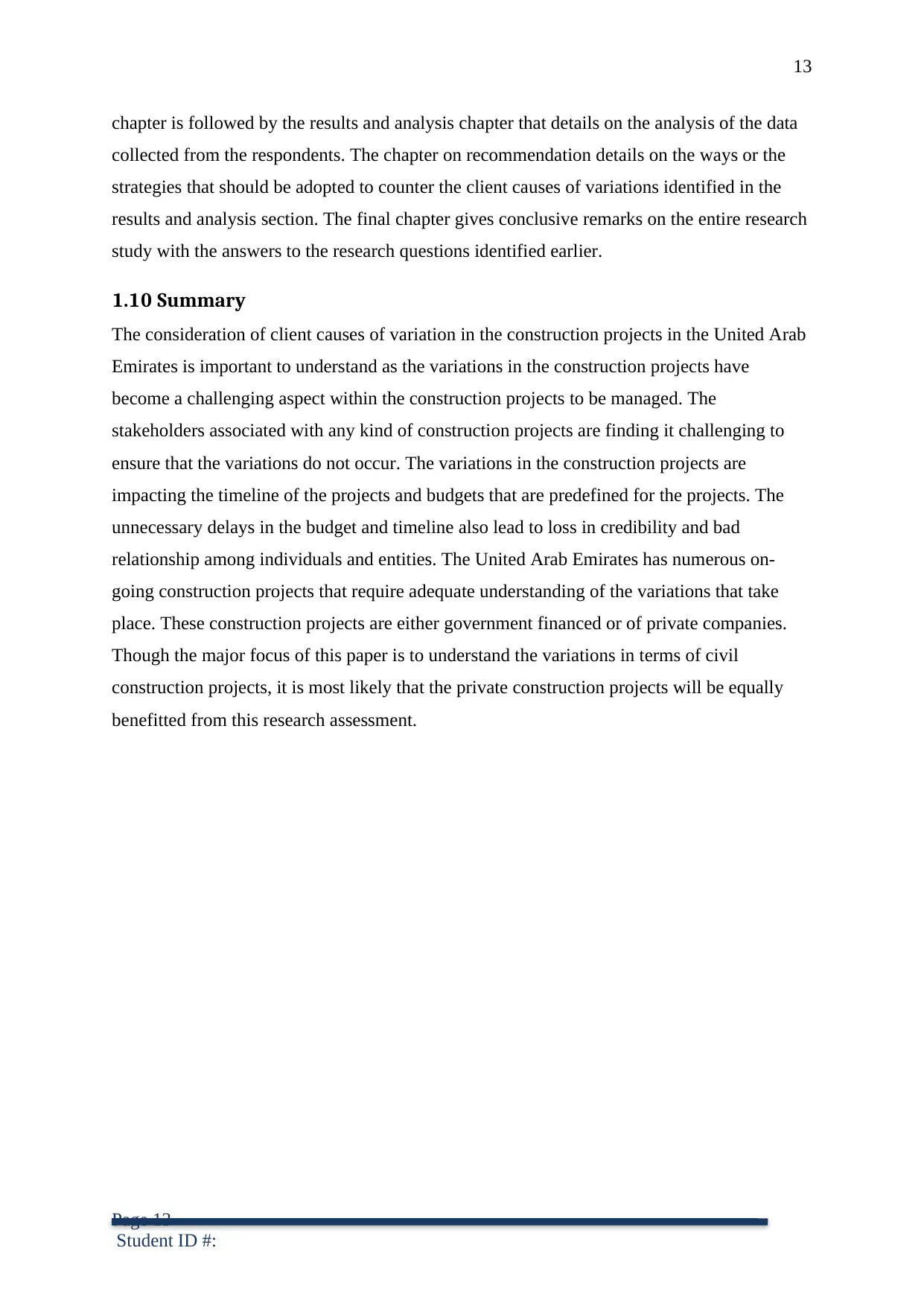
13
chapter is followed by the results and analysis chapter that details on the analysis of the data
collected from the respondents. The chapter on recommendation details on the ways or the
strategies that should be adopted to counter the client causes of variations identified in the
results and analysis section. The final chapter gives conclusive remarks on the entire research
study with the answers to the research questions identified earlier.
1.10 Summary
The consideration of client causes of variation in the construction projects in the United Arab
Emirates is important to understand as the variations in the construction projects have
become a challenging aspect within the construction projects to be managed. The
stakeholders associated with any kind of construction projects are finding it challenging to
ensure that the variations do not occur. The variations in the construction projects are
impacting the timeline of the projects and budgets that are predefined for the projects. The
unnecessary delays in the budget and timeline also lead to loss in credibility and bad
relationship among individuals and entities. The United Arab Emirates has numerous on-
going construction projects that require adequate understanding of the variations that take
place. These construction projects are either government financed or of private companies.
Though the major focus of this paper is to understand the variations in terms of civil
construction projects, it is most likely that the private construction projects will be equally
benefitted from this research assessment.
Page 13
Student ID #:
chapter is followed by the results and analysis chapter that details on the analysis of the data
collected from the respondents. The chapter on recommendation details on the ways or the
strategies that should be adopted to counter the client causes of variations identified in the
results and analysis section. The final chapter gives conclusive remarks on the entire research
study with the answers to the research questions identified earlier.
1.10 Summary
The consideration of client causes of variation in the construction projects in the United Arab
Emirates is important to understand as the variations in the construction projects have
become a challenging aspect within the construction projects to be managed. The
stakeholders associated with any kind of construction projects are finding it challenging to
ensure that the variations do not occur. The variations in the construction projects are
impacting the timeline of the projects and budgets that are predefined for the projects. The
unnecessary delays in the budget and timeline also lead to loss in credibility and bad
relationship among individuals and entities. The United Arab Emirates has numerous on-
going construction projects that require adequate understanding of the variations that take
place. These construction projects are either government financed or of private companies.
Though the major focus of this paper is to understand the variations in terms of civil
construction projects, it is most likely that the private construction projects will be equally
benefitted from this research assessment.
Page 13
Student ID #:
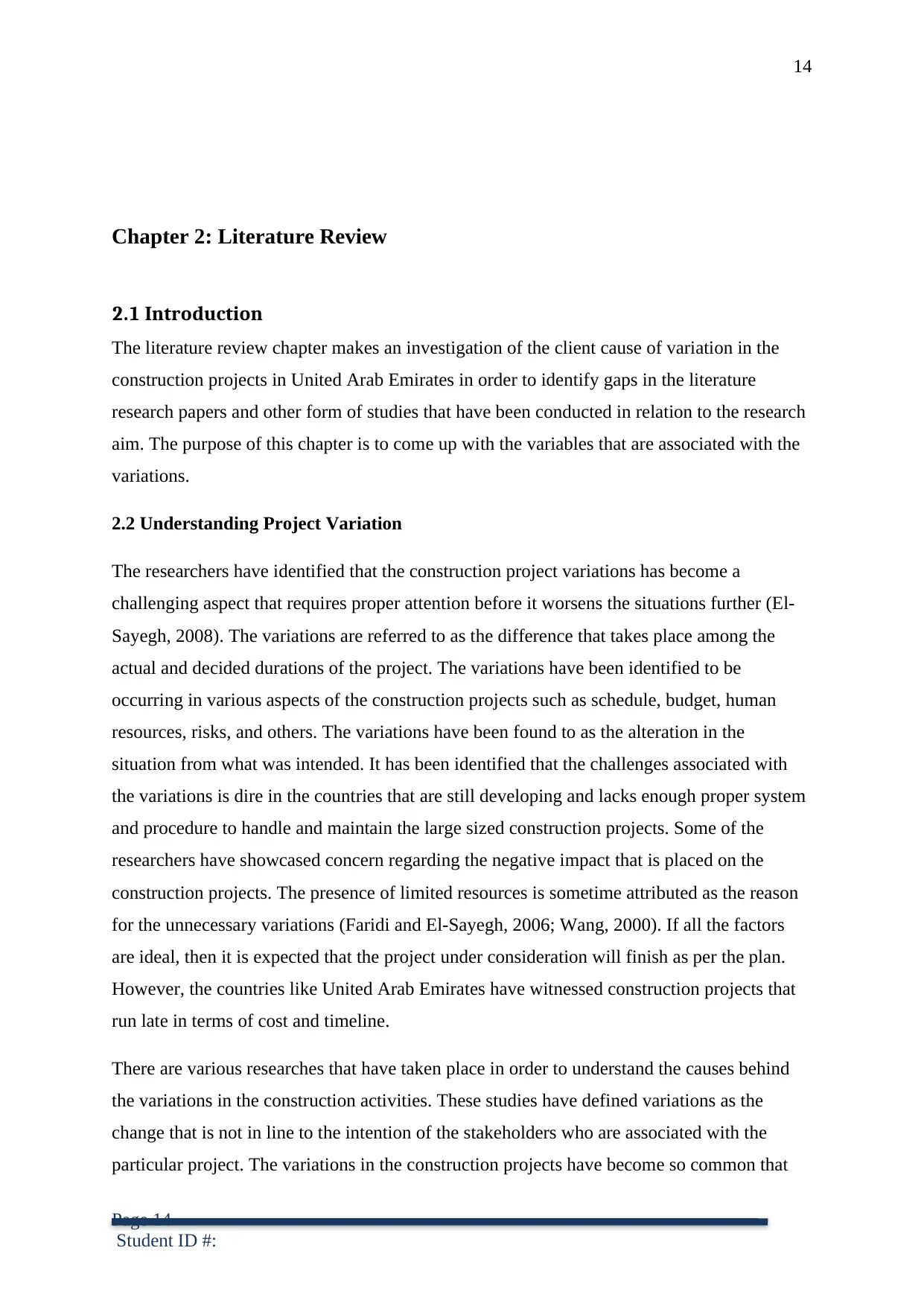
14
Chapter 2: Literature Review
2.1 Introduction
The literature review chapter makes an investigation of the client cause of variation in the
construction projects in United Arab Emirates in order to identify gaps in the literature
research papers and other form of studies that have been conducted in relation to the research
aim. The purpose of this chapter is to come up with the variables that are associated with the
variations.
2.2 Understanding Project Variation
The researchers have identified that the construction project variations has become a
challenging aspect that requires proper attention before it worsens the situations further (El-
Sayegh, 2008). The variations are referred to as the difference that takes place among the
actual and decided durations of the project. The variations have been identified to be
occurring in various aspects of the construction projects such as schedule, budget, human
resources, risks, and others. The variations have been found to as the alteration in the
situation from what was intended. It has been identified that the challenges associated with
the variations is dire in the countries that are still developing and lacks enough proper system
and procedure to handle and maintain the large sized construction projects. Some of the
researchers have showcased concern regarding the negative impact that is placed on the
construction projects. The presence of limited resources is sometime attributed as the reason
for the unnecessary variations (Faridi and El-Sayegh, 2006; Wang, 2000). If all the factors
are ideal, then it is expected that the project under consideration will finish as per the plan.
However, the countries like United Arab Emirates have witnessed construction projects that
run late in terms of cost and timeline.
There are various researches that have taken place in order to understand the causes behind
the variations in the construction activities. These studies have defined variations as the
change that is not in line to the intention of the stakeholders who are associated with the
particular project. The variations in the construction projects have become so common that
Page 14
Student ID #:
Chapter 2: Literature Review
2.1 Introduction
The literature review chapter makes an investigation of the client cause of variation in the
construction projects in United Arab Emirates in order to identify gaps in the literature
research papers and other form of studies that have been conducted in relation to the research
aim. The purpose of this chapter is to come up with the variables that are associated with the
variations.
2.2 Understanding Project Variation
The researchers have identified that the construction project variations has become a
challenging aspect that requires proper attention before it worsens the situations further (El-
Sayegh, 2008). The variations are referred to as the difference that takes place among the
actual and decided durations of the project. The variations have been identified to be
occurring in various aspects of the construction projects such as schedule, budget, human
resources, risks, and others. The variations have been found to as the alteration in the
situation from what was intended. It has been identified that the challenges associated with
the variations is dire in the countries that are still developing and lacks enough proper system
and procedure to handle and maintain the large sized construction projects. Some of the
researchers have showcased concern regarding the negative impact that is placed on the
construction projects. The presence of limited resources is sometime attributed as the reason
for the unnecessary variations (Faridi and El-Sayegh, 2006; Wang, 2000). If all the factors
are ideal, then it is expected that the project under consideration will finish as per the plan.
However, the countries like United Arab Emirates have witnessed construction projects that
run late in terms of cost and timeline.
There are various researches that have taken place in order to understand the causes behind
the variations in the construction activities. These studies have defined variations as the
change that is not in line to the intention of the stakeholders who are associated with the
particular project. The variations in the construction projects have become so common that
Page 14
Student ID #:
Secure Best Marks with AI Grader
Need help grading? Try our AI Grader for instant feedback on your assignments.
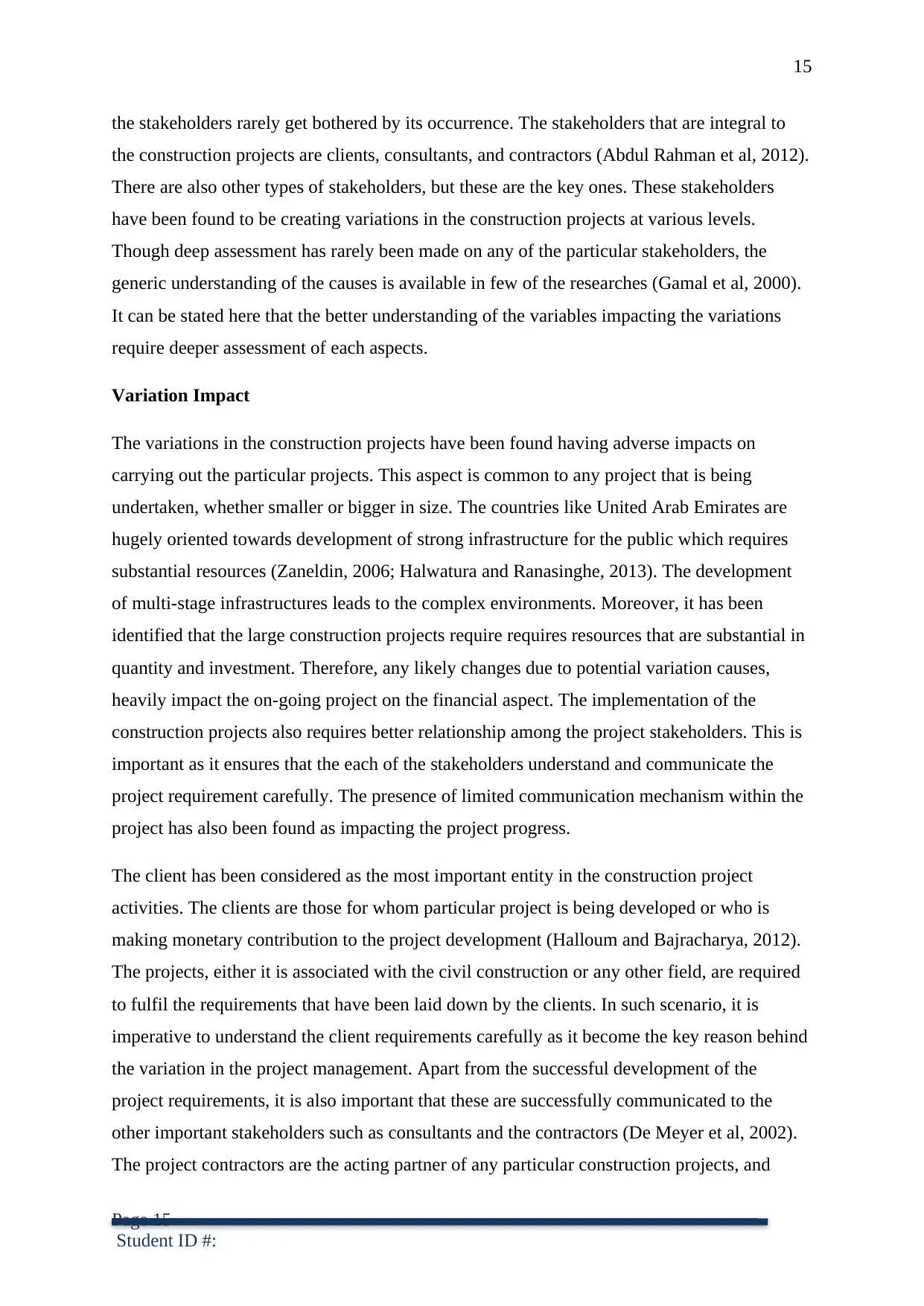
15
the stakeholders rarely get bothered by its occurrence. The stakeholders that are integral to
the construction projects are clients, consultants, and contractors (Abdul Rahman et al, 2012).
There are also other types of stakeholders, but these are the key ones. These stakeholders
have been found to be creating variations in the construction projects at various levels.
Though deep assessment has rarely been made on any of the particular stakeholders, the
generic understanding of the causes is available in few of the researches (Gamal et al, 2000).
It can be stated here that the better understanding of the variables impacting the variations
require deeper assessment of each aspects.
Variation Impact
The variations in the construction projects have been found having adverse impacts on
carrying out the particular projects. This aspect is common to any project that is being
undertaken, whether smaller or bigger in size. The countries like United Arab Emirates are
hugely oriented towards development of strong infrastructure for the public which requires
substantial resources (Zaneldin, 2006; Halwatura and Ranasinghe, 2013). The development
of multi-stage infrastructures leads to the complex environments. Moreover, it has been
identified that the large construction projects require requires resources that are substantial in
quantity and investment. Therefore, any likely changes due to potential variation causes,
heavily impact the on-going project on the financial aspect. The implementation of the
construction projects also requires better relationship among the project stakeholders. This is
important as it ensures that the each of the stakeholders understand and communicate the
project requirement carefully. The presence of limited communication mechanism within the
project has also been found as impacting the project progress.
The client has been considered as the most important entity in the construction project
activities. The clients are those for whom particular project is being developed or who is
making monetary contribution to the project development (Halloum and Bajracharya, 2012).
The projects, either it is associated with the civil construction or any other field, are required
to fulfil the requirements that have been laid down by the clients. In such scenario, it is
imperative to understand the client requirements carefully as it become the key reason behind
the variation in the project management. Apart from the successful development of the
project requirements, it is also important that these are successfully communicated to the
other important stakeholders such as consultants and the contractors (De Meyer et al, 2002).
The project contractors are the acting partner of any particular construction projects, and
Page 15
Student ID #:
the stakeholders rarely get bothered by its occurrence. The stakeholders that are integral to
the construction projects are clients, consultants, and contractors (Abdul Rahman et al, 2012).
There are also other types of stakeholders, but these are the key ones. These stakeholders
have been found to be creating variations in the construction projects at various levels.
Though deep assessment has rarely been made on any of the particular stakeholders, the
generic understanding of the causes is available in few of the researches (Gamal et al, 2000).
It can be stated here that the better understanding of the variables impacting the variations
require deeper assessment of each aspects.
Variation Impact
The variations in the construction projects have been found having adverse impacts on
carrying out the particular projects. This aspect is common to any project that is being
undertaken, whether smaller or bigger in size. The countries like United Arab Emirates are
hugely oriented towards development of strong infrastructure for the public which requires
substantial resources (Zaneldin, 2006; Halwatura and Ranasinghe, 2013). The development
of multi-stage infrastructures leads to the complex environments. Moreover, it has been
identified that the large construction projects require requires resources that are substantial in
quantity and investment. Therefore, any likely changes due to potential variation causes,
heavily impact the on-going project on the financial aspect. The implementation of the
construction projects also requires better relationship among the project stakeholders. This is
important as it ensures that the each of the stakeholders understand and communicate the
project requirement carefully. The presence of limited communication mechanism within the
project has also been found as impacting the project progress.
The client has been considered as the most important entity in the construction project
activities. The clients are those for whom particular project is being developed or who is
making monetary contribution to the project development (Halloum and Bajracharya, 2012).
The projects, either it is associated with the civil construction or any other field, are required
to fulfil the requirements that have been laid down by the clients. In such scenario, it is
imperative to understand the client requirements carefully as it become the key reason behind
the variation in the project management. Apart from the successful development of the
project requirements, it is also important that these are successfully communicated to the
other important stakeholders such as consultants and the contractors (De Meyer et al, 2002).
The project contractors are the acting partner of any particular construction projects, and
Page 15
Student ID #:
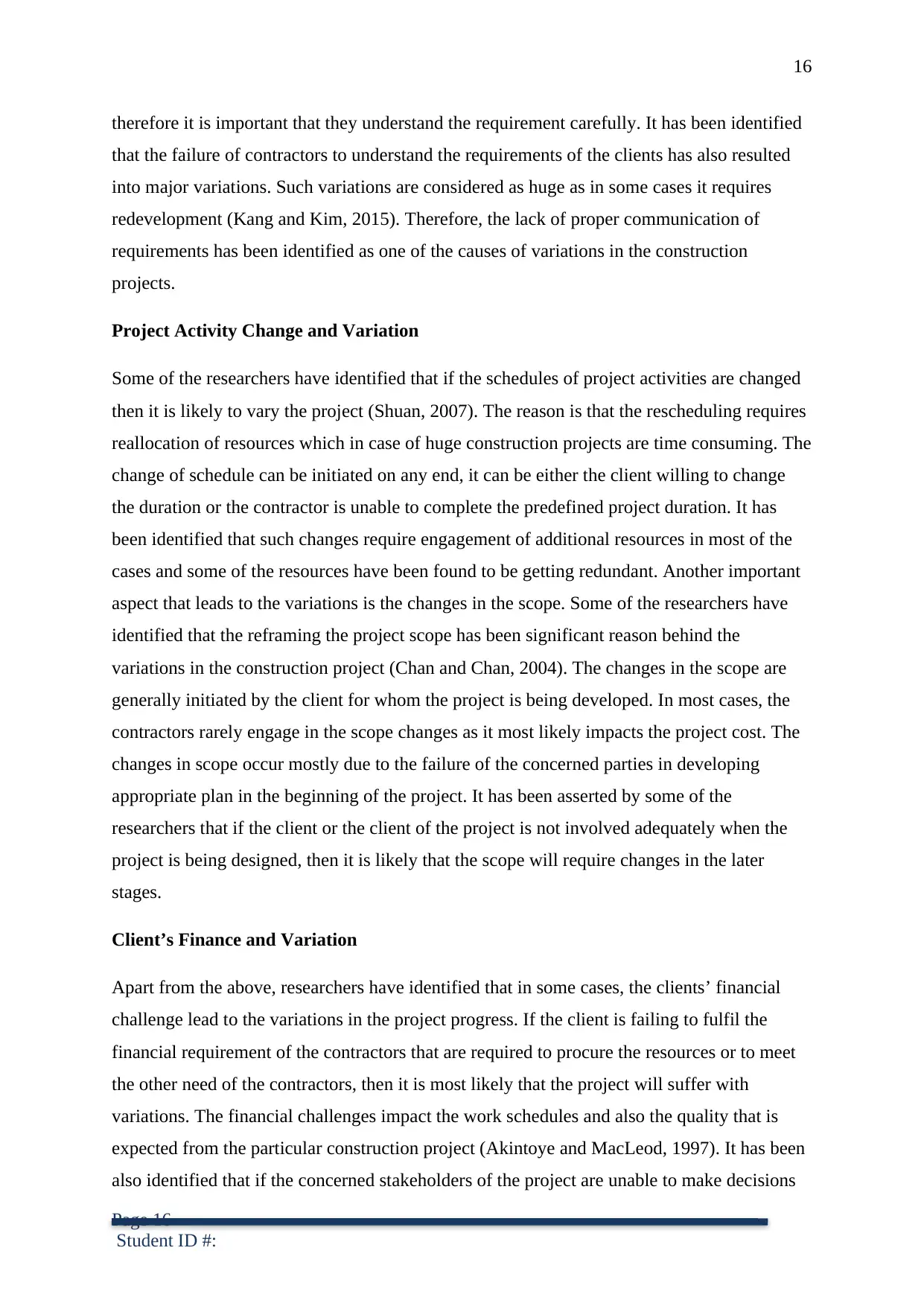
16
therefore it is important that they understand the requirement carefully. It has been identified
that the failure of contractors to understand the requirements of the clients has also resulted
into major variations. Such variations are considered as huge as in some cases it requires
redevelopment (Kang and Kim, 2015). Therefore, the lack of proper communication of
requirements has been identified as one of the causes of variations in the construction
projects.
Project Activity Change and Variation
Some of the researchers have identified that if the schedules of project activities are changed
then it is likely to vary the project (Shuan, 2007). The reason is that the rescheduling requires
reallocation of resources which in case of huge construction projects are time consuming. The
change of schedule can be initiated on any end, it can be either the client willing to change
the duration or the contractor is unable to complete the predefined project duration. It has
been identified that such changes require engagement of additional resources in most of the
cases and some of the resources have been found to be getting redundant. Another important
aspect that leads to the variations is the changes in the scope. Some of the researchers have
identified that the reframing the project scope has been significant reason behind the
variations in the construction project (Chan and Chan, 2004). The changes in the scope are
generally initiated by the client for whom the project is being developed. In most cases, the
contractors rarely engage in the scope changes as it most likely impacts the project cost. The
changes in scope occur mostly due to the failure of the concerned parties in developing
appropriate plan in the beginning of the project. It has been asserted by some of the
researchers that if the client or the client of the project is not involved adequately when the
project is being designed, then it is likely that the scope will require changes in the later
stages.
Client’s Finance and Variation
Apart from the above, researchers have identified that in some cases, the clients’ financial
challenge lead to the variations in the project progress. If the client is failing to fulfil the
financial requirement of the contractors that are required to procure the resources or to meet
the other need of the contractors, then it is most likely that the project will suffer with
variations. The financial challenges impact the work schedules and also the quality that is
expected from the particular construction project (Akintoye and MacLeod, 1997). It has been
also identified that if the concerned stakeholders of the project are unable to make decisions
Page 16
Student ID #:
therefore it is important that they understand the requirement carefully. It has been identified
that the failure of contractors to understand the requirements of the clients has also resulted
into major variations. Such variations are considered as huge as in some cases it requires
redevelopment (Kang and Kim, 2015). Therefore, the lack of proper communication of
requirements has been identified as one of the causes of variations in the construction
projects.
Project Activity Change and Variation
Some of the researchers have identified that if the schedules of project activities are changed
then it is likely to vary the project (Shuan, 2007). The reason is that the rescheduling requires
reallocation of resources which in case of huge construction projects are time consuming. The
change of schedule can be initiated on any end, it can be either the client willing to change
the duration or the contractor is unable to complete the predefined project duration. It has
been identified that such changes require engagement of additional resources in most of the
cases and some of the resources have been found to be getting redundant. Another important
aspect that leads to the variations is the changes in the scope. Some of the researchers have
identified that the reframing the project scope has been significant reason behind the
variations in the construction project (Chan and Chan, 2004). The changes in the scope are
generally initiated by the client for whom the project is being developed. In most cases, the
contractors rarely engage in the scope changes as it most likely impacts the project cost. The
changes in scope occur mostly due to the failure of the concerned parties in developing
appropriate plan in the beginning of the project. It has been asserted by some of the
researchers that if the client or the client of the project is not involved adequately when the
project is being designed, then it is likely that the scope will require changes in the later
stages.
Client’s Finance and Variation
Apart from the above, researchers have identified that in some cases, the clients’ financial
challenge lead to the variations in the project progress. If the client is failing to fulfil the
financial requirement of the contractors that are required to procure the resources or to meet
the other need of the contractors, then it is most likely that the project will suffer with
variations. The financial challenges impact the work schedules and also the quality that is
expected from the particular construction project (Akintoye and MacLeod, 1997). It has been
also identified that if the concerned stakeholders of the project are unable to make decisions
Page 16
Student ID #:
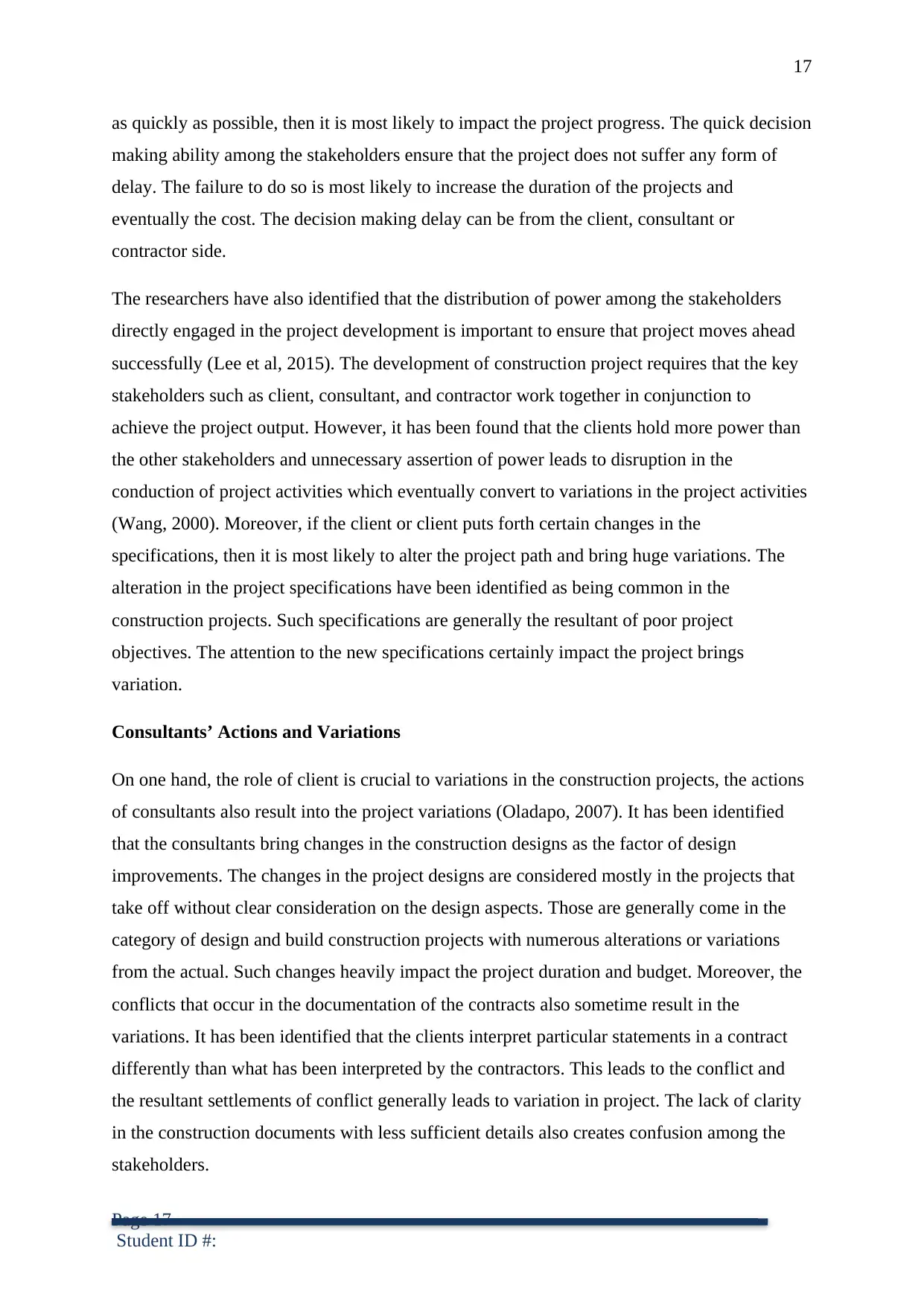
17
as quickly as possible, then it is most likely to impact the project progress. The quick decision
making ability among the stakeholders ensure that the project does not suffer any form of
delay. The failure to do so is most likely to increase the duration of the projects and
eventually the cost. The decision making delay can be from the client, consultant or
contractor side.
The researchers have also identified that the distribution of power among the stakeholders
directly engaged in the project development is important to ensure that project moves ahead
successfully (Lee et al, 2015). The development of construction project requires that the key
stakeholders such as client, consultant, and contractor work together in conjunction to
achieve the project output. However, it has been found that the clients hold more power than
the other stakeholders and unnecessary assertion of power leads to disruption in the
conduction of project activities which eventually convert to variations in the project activities
(Wang, 2000). Moreover, if the client or client puts forth certain changes in the
specifications, then it is most likely to alter the project path and bring huge variations. The
alteration in the project specifications have been identified as being common in the
construction projects. Such specifications are generally the resultant of poor project
objectives. The attention to the new specifications certainly impact the project brings
variation.
Consultants’ Actions and Variations
On one hand, the role of client is crucial to variations in the construction projects, the actions
of consultants also result into the project variations (Oladapo, 2007). It has been identified
that the consultants bring changes in the construction designs as the factor of design
improvements. The changes in the project designs are considered mostly in the projects that
take off without clear consideration on the design aspects. Those are generally come in the
category of design and build construction projects with numerous alterations or variations
from the actual. Such changes heavily impact the project duration and budget. Moreover, the
conflicts that occur in the documentation of the contracts also sometime result in the
variations. It has been identified that the clients interpret particular statements in a contract
differently than what has been interpreted by the contractors. This leads to the conflict and
the resultant settlements of conflict generally leads to variation in project. The lack of clarity
in the construction documents with less sufficient details also creates confusion among the
stakeholders.
Page 17
Student ID #:
as quickly as possible, then it is most likely to impact the project progress. The quick decision
making ability among the stakeholders ensure that the project does not suffer any form of
delay. The failure to do so is most likely to increase the duration of the projects and
eventually the cost. The decision making delay can be from the client, consultant or
contractor side.
The researchers have also identified that the distribution of power among the stakeholders
directly engaged in the project development is important to ensure that project moves ahead
successfully (Lee et al, 2015). The development of construction project requires that the key
stakeholders such as client, consultant, and contractor work together in conjunction to
achieve the project output. However, it has been found that the clients hold more power than
the other stakeholders and unnecessary assertion of power leads to disruption in the
conduction of project activities which eventually convert to variations in the project activities
(Wang, 2000). Moreover, if the client or client puts forth certain changes in the
specifications, then it is most likely to alter the project path and bring huge variations. The
alteration in the project specifications have been identified as being common in the
construction projects. Such specifications are generally the resultant of poor project
objectives. The attention to the new specifications certainly impact the project brings
variation.
Consultants’ Actions and Variations
On one hand, the role of client is crucial to variations in the construction projects, the actions
of consultants also result into the project variations (Oladapo, 2007). It has been identified
that the consultants bring changes in the construction designs as the factor of design
improvements. The changes in the project designs are considered mostly in the projects that
take off without clear consideration on the design aspects. Those are generally come in the
category of design and build construction projects with numerous alterations or variations
from the actual. Such changes heavily impact the project duration and budget. Moreover, the
conflicts that occur in the documentation of the contracts also sometime result in the
variations. It has been identified that the clients interpret particular statements in a contract
differently than what has been interpreted by the contractors. This leads to the conflict and
the resultant settlements of conflict generally leads to variation in project. The lack of clarity
in the construction documents with less sufficient details also creates confusion among the
stakeholders.
Page 17
Student ID #:
Paraphrase This Document
Need a fresh take? Get an instant paraphrase of this document with our AI Paraphraser
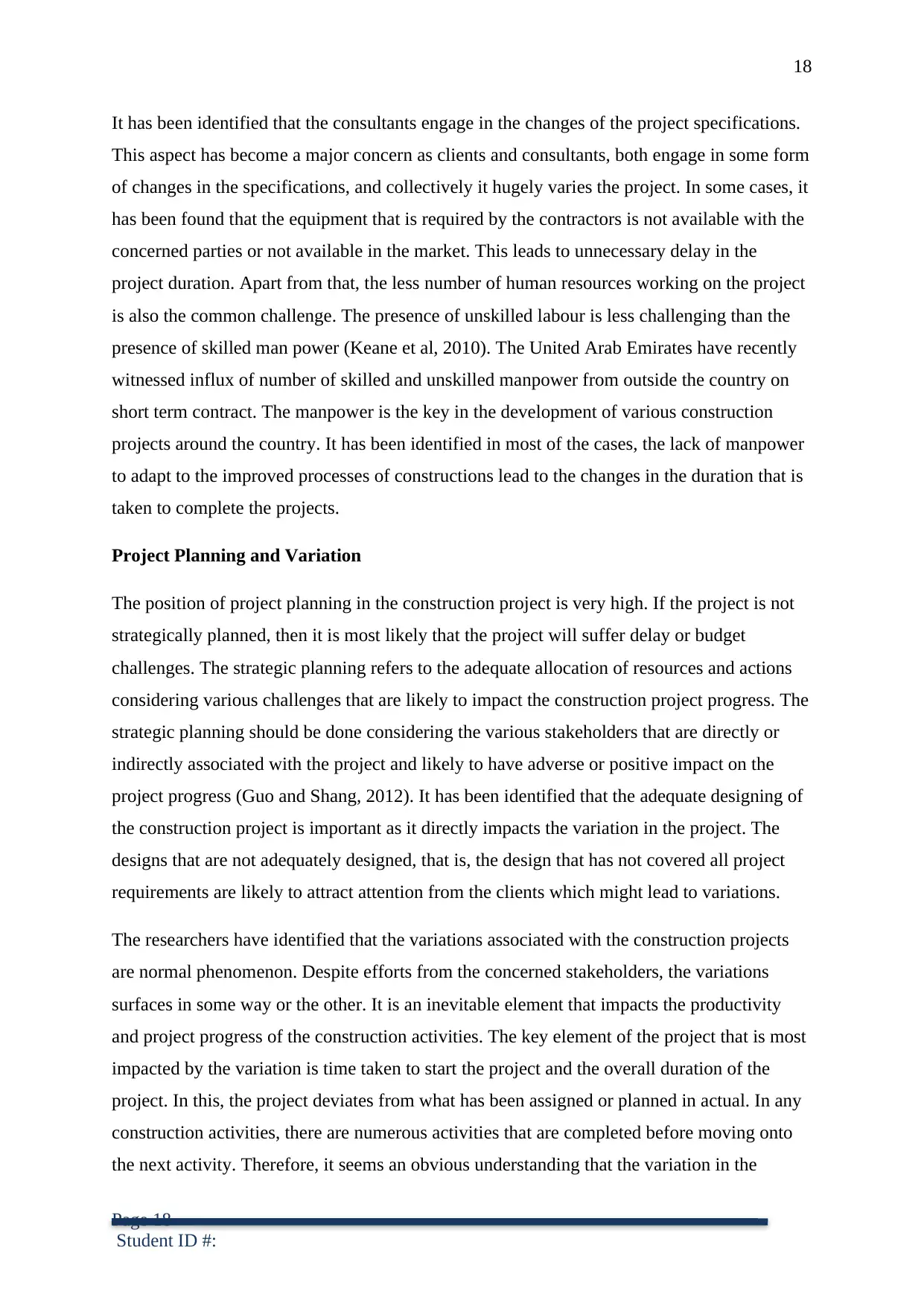
18
It has been identified that the consultants engage in the changes of the project specifications.
This aspect has become a major concern as clients and consultants, both engage in some form
of changes in the specifications, and collectively it hugely varies the project. In some cases, it
has been found that the equipment that is required by the contractors is not available with the
concerned parties or not available in the market. This leads to unnecessary delay in the
project duration. Apart from that, the less number of human resources working on the project
is also the common challenge. The presence of unskilled labour is less challenging than the
presence of skilled man power (Keane et al, 2010). The United Arab Emirates have recently
witnessed influx of number of skilled and unskilled manpower from outside the country on
short term contract. The manpower is the key in the development of various construction
projects around the country. It has been identified in most of the cases, the lack of manpower
to adapt to the improved processes of constructions lead to the changes in the duration that is
taken to complete the projects.
Project Planning and Variation
The position of project planning in the construction project is very high. If the project is not
strategically planned, then it is most likely that the project will suffer delay or budget
challenges. The strategic planning refers to the adequate allocation of resources and actions
considering various challenges that are likely to impact the construction project progress. The
strategic planning should be done considering the various stakeholders that are directly or
indirectly associated with the project and likely to have adverse or positive impact on the
project progress (Guo and Shang, 2012). It has been identified that the adequate designing of
the construction project is important as it directly impacts the variation in the project. The
designs that are not adequately designed, that is, the design that has not covered all project
requirements are likely to attract attention from the clients which might lead to variations.
The researchers have identified that the variations associated with the construction projects
are normal phenomenon. Despite efforts from the concerned stakeholders, the variations
surfaces in some way or the other. It is an inevitable element that impacts the productivity
and project progress of the construction activities. The key element of the project that is most
impacted by the variation is time taken to start the project and the overall duration of the
project. In this, the project deviates from what has been assigned or planned in actual. In any
construction activities, there are numerous activities that are completed before moving onto
the next activity. Therefore, it seems an obvious understanding that the variation in the
Page 18
Student ID #:
It has been identified that the consultants engage in the changes of the project specifications.
This aspect has become a major concern as clients and consultants, both engage in some form
of changes in the specifications, and collectively it hugely varies the project. In some cases, it
has been found that the equipment that is required by the contractors is not available with the
concerned parties or not available in the market. This leads to unnecessary delay in the
project duration. Apart from that, the less number of human resources working on the project
is also the common challenge. The presence of unskilled labour is less challenging than the
presence of skilled man power (Keane et al, 2010). The United Arab Emirates have recently
witnessed influx of number of skilled and unskilled manpower from outside the country on
short term contract. The manpower is the key in the development of various construction
projects around the country. It has been identified in most of the cases, the lack of manpower
to adapt to the improved processes of constructions lead to the changes in the duration that is
taken to complete the projects.
Project Planning and Variation
The position of project planning in the construction project is very high. If the project is not
strategically planned, then it is most likely that the project will suffer delay or budget
challenges. The strategic planning refers to the adequate allocation of resources and actions
considering various challenges that are likely to impact the construction project progress. The
strategic planning should be done considering the various stakeholders that are directly or
indirectly associated with the project and likely to have adverse or positive impact on the
project progress (Guo and Shang, 2012). It has been identified that the adequate designing of
the construction project is important as it directly impacts the variation in the project. The
designs that are not adequately designed, that is, the design that has not covered all project
requirements are likely to attract attention from the clients which might lead to variations.
The researchers have identified that the variations associated with the construction projects
are normal phenomenon. Despite efforts from the concerned stakeholders, the variations
surfaces in some way or the other. It is an inevitable element that impacts the productivity
and project progress of the construction activities. The key element of the project that is most
impacted by the variation is time taken to start the project and the overall duration of the
project. In this, the project deviates from what has been assigned or planned in actual. In any
construction activities, there are numerous activities that are completed before moving onto
the next activity. Therefore, it seems an obvious understanding that the variation in the
Page 18
Student ID #:
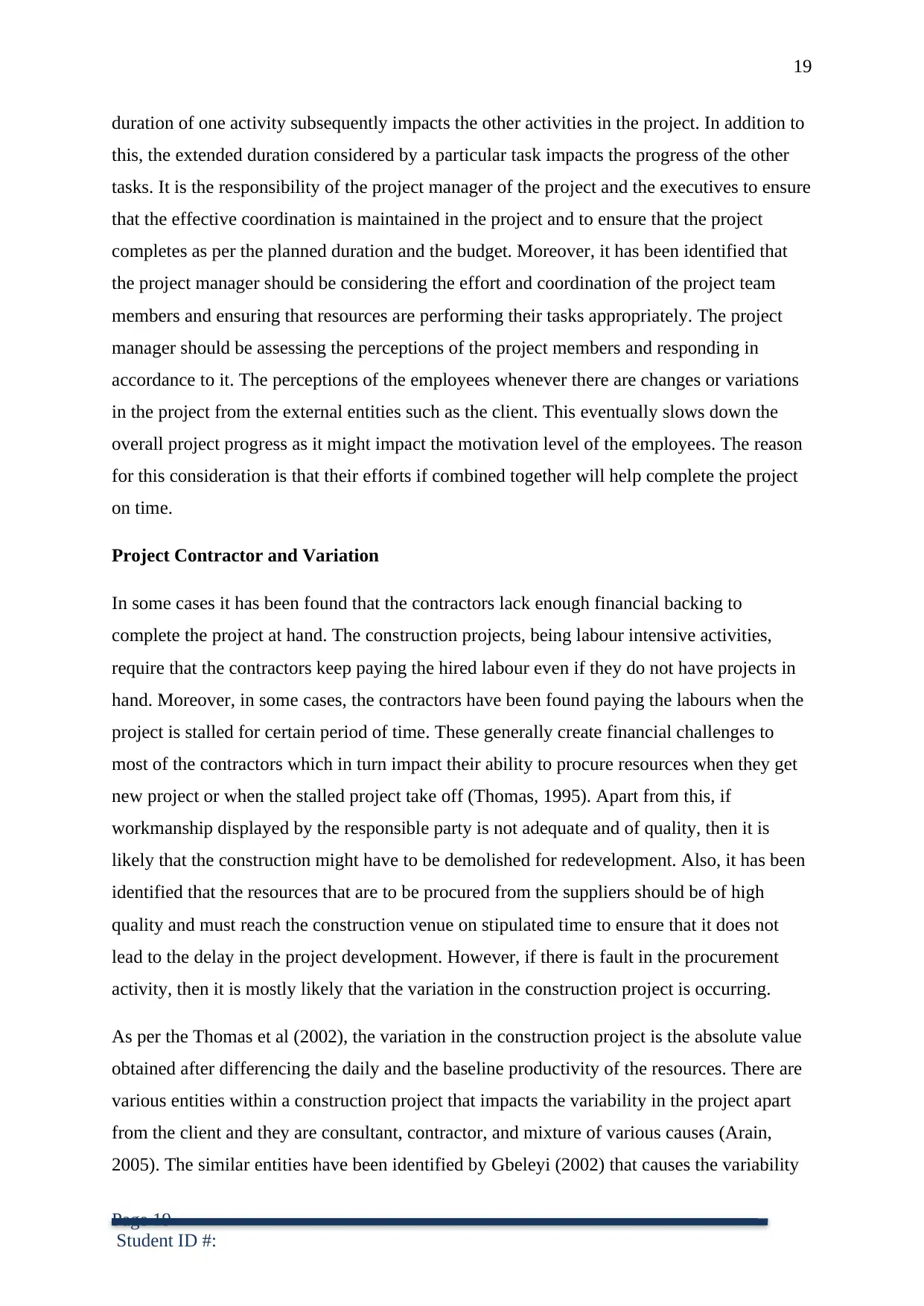
19
duration of one activity subsequently impacts the other activities in the project. In addition to
this, the extended duration considered by a particular task impacts the progress of the other
tasks. It is the responsibility of the project manager of the project and the executives to ensure
that the effective coordination is maintained in the project and to ensure that the project
completes as per the planned duration and the budget. Moreover, it has been identified that
the project manager should be considering the effort and coordination of the project team
members and ensuring that resources are performing their tasks appropriately. The project
manager should be assessing the perceptions of the project members and responding in
accordance to it. The perceptions of the employees whenever there are changes or variations
in the project from the external entities such as the client. This eventually slows down the
overall project progress as it might impact the motivation level of the employees. The reason
for this consideration is that their efforts if combined together will help complete the project
on time.
Project Contractor and Variation
In some cases it has been found that the contractors lack enough financial backing to
complete the project at hand. The construction projects, being labour intensive activities,
require that the contractors keep paying the hired labour even if they do not have projects in
hand. Moreover, in some cases, the contractors have been found paying the labours when the
project is stalled for certain period of time. These generally create financial challenges to
most of the contractors which in turn impact their ability to procure resources when they get
new project or when the stalled project take off (Thomas, 1995). Apart from this, if
workmanship displayed by the responsible party is not adequate and of quality, then it is
likely that the construction might have to be demolished for redevelopment. Also, it has been
identified that the resources that are to be procured from the suppliers should be of high
quality and must reach the construction venue on stipulated time to ensure that it does not
lead to the delay in the project development. However, if there is fault in the procurement
activity, then it is mostly likely that the variation in the construction project is occurring.
As per the Thomas et al (2002), the variation in the construction project is the absolute value
obtained after differencing the daily and the baseline productivity of the resources. There are
various entities within a construction project that impacts the variability in the project apart
from the client and they are consultant, contractor, and mixture of various causes (Arain,
2005). The similar entities have been identified by Gbeleyi (2002) that causes the variability
Page 19
Student ID #:
duration of one activity subsequently impacts the other activities in the project. In addition to
this, the extended duration considered by a particular task impacts the progress of the other
tasks. It is the responsibility of the project manager of the project and the executives to ensure
that the effective coordination is maintained in the project and to ensure that the project
completes as per the planned duration and the budget. Moreover, it has been identified that
the project manager should be considering the effort and coordination of the project team
members and ensuring that resources are performing their tasks appropriately. The project
manager should be assessing the perceptions of the project members and responding in
accordance to it. The perceptions of the employees whenever there are changes or variations
in the project from the external entities such as the client. This eventually slows down the
overall project progress as it might impact the motivation level of the employees. The reason
for this consideration is that their efforts if combined together will help complete the project
on time.
Project Contractor and Variation
In some cases it has been found that the contractors lack enough financial backing to
complete the project at hand. The construction projects, being labour intensive activities,
require that the contractors keep paying the hired labour even if they do not have projects in
hand. Moreover, in some cases, the contractors have been found paying the labours when the
project is stalled for certain period of time. These generally create financial challenges to
most of the contractors which in turn impact their ability to procure resources when they get
new project or when the stalled project take off (Thomas, 1995). Apart from this, if
workmanship displayed by the responsible party is not adequate and of quality, then it is
likely that the construction might have to be demolished for redevelopment. Also, it has been
identified that the resources that are to be procured from the suppliers should be of high
quality and must reach the construction venue on stipulated time to ensure that it does not
lead to the delay in the project development. However, if there is fault in the procurement
activity, then it is mostly likely that the variation in the construction project is occurring.
As per the Thomas et al (2002), the variation in the construction project is the absolute value
obtained after differencing the daily and the baseline productivity of the resources. There are
various entities within a construction project that impacts the variability in the project apart
from the client and they are consultant, contractor, and mixture of various causes (Arain,
2005). The similar entities have been identified by Gbeleyi (2002) that causes the variability
Page 19
Student ID #:
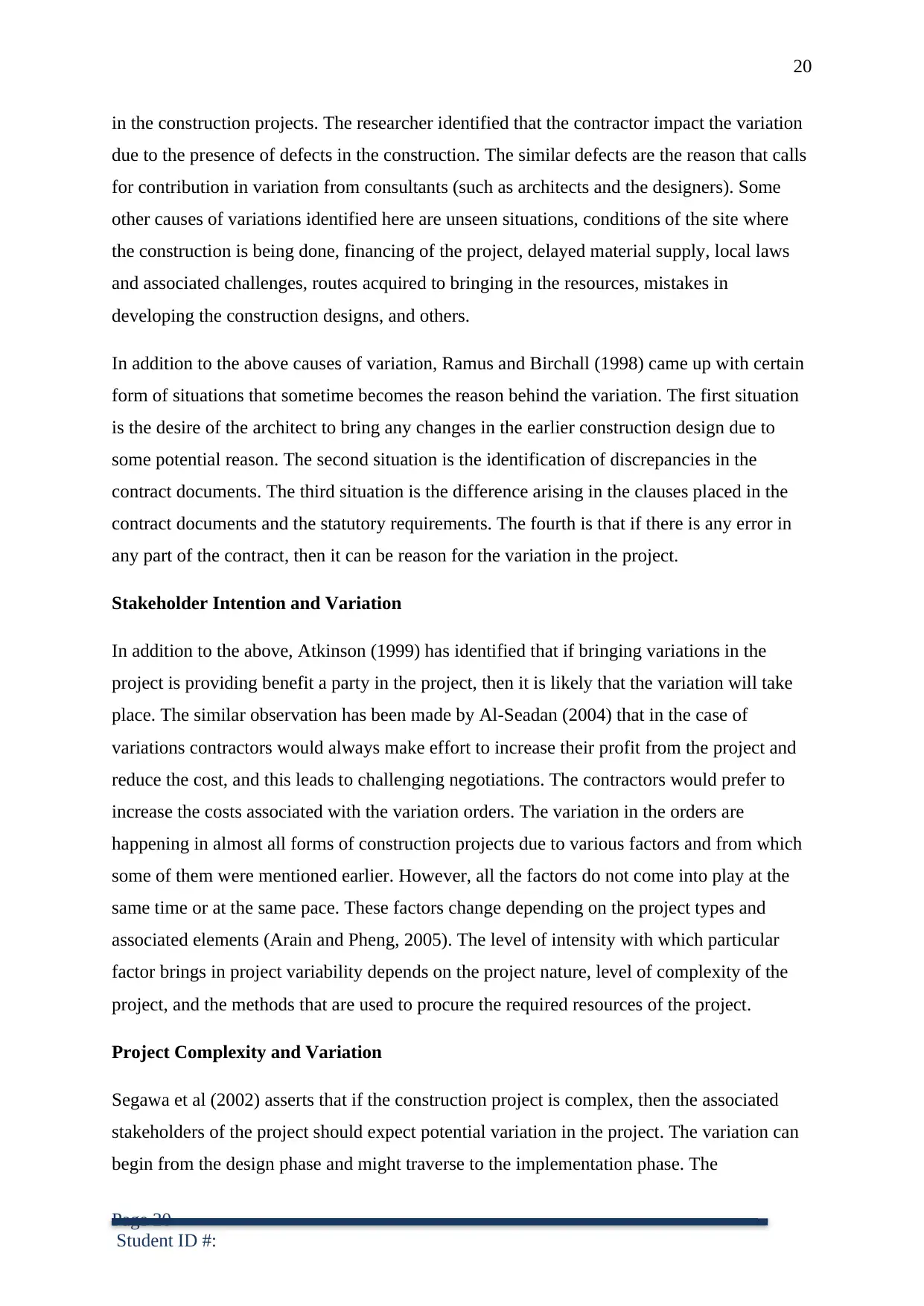
20
in the construction projects. The researcher identified that the contractor impact the variation
due to the presence of defects in the construction. The similar defects are the reason that calls
for contribution in variation from consultants (such as architects and the designers). Some
other causes of variations identified here are unseen situations, conditions of the site where
the construction is being done, financing of the project, delayed material supply, local laws
and associated challenges, routes acquired to bringing in the resources, mistakes in
developing the construction designs, and others.
In addition to the above causes of variation, Ramus and Birchall (1998) came up with certain
form of situations that sometime becomes the reason behind the variation. The first situation
is the desire of the architect to bring any changes in the earlier construction design due to
some potential reason. The second situation is the identification of discrepancies in the
contract documents. The third situation is the difference arising in the clauses placed in the
contract documents and the statutory requirements. The fourth is that if there is any error in
any part of the contract, then it can be reason for the variation in the project.
Stakeholder Intention and Variation
In addition to the above, Atkinson (1999) has identified that if bringing variations in the
project is providing benefit a party in the project, then it is likely that the variation will take
place. The similar observation has been made by Al-Seadan (2004) that in the case of
variations contractors would always make effort to increase their profit from the project and
reduce the cost, and this leads to challenging negotiations. The contractors would prefer to
increase the costs associated with the variation orders. The variation in the orders are
happening in almost all forms of construction projects due to various factors and from which
some of them were mentioned earlier. However, all the factors do not come into play at the
same time or at the same pace. These factors change depending on the project types and
associated elements (Arain and Pheng, 2005). The level of intensity with which particular
factor brings in project variability depends on the project nature, level of complexity of the
project, and the methods that are used to procure the required resources of the project.
Project Complexity and Variation
Segawa et al (2002) asserts that if the construction project is complex, then the associated
stakeholders of the project should expect potential variation in the project. The variation can
begin from the design phase and might traverse to the implementation phase. The
Page 20
Student ID #:
in the construction projects. The researcher identified that the contractor impact the variation
due to the presence of defects in the construction. The similar defects are the reason that calls
for contribution in variation from consultants (such as architects and the designers). Some
other causes of variations identified here are unseen situations, conditions of the site where
the construction is being done, financing of the project, delayed material supply, local laws
and associated challenges, routes acquired to bringing in the resources, mistakes in
developing the construction designs, and others.
In addition to the above causes of variation, Ramus and Birchall (1998) came up with certain
form of situations that sometime becomes the reason behind the variation. The first situation
is the desire of the architect to bring any changes in the earlier construction design due to
some potential reason. The second situation is the identification of discrepancies in the
contract documents. The third situation is the difference arising in the clauses placed in the
contract documents and the statutory requirements. The fourth is that if there is any error in
any part of the contract, then it can be reason for the variation in the project.
Stakeholder Intention and Variation
In addition to the above, Atkinson (1999) has identified that if bringing variations in the
project is providing benefit a party in the project, then it is likely that the variation will take
place. The similar observation has been made by Al-Seadan (2004) that in the case of
variations contractors would always make effort to increase their profit from the project and
reduce the cost, and this leads to challenging negotiations. The contractors would prefer to
increase the costs associated with the variation orders. The variation in the orders are
happening in almost all forms of construction projects due to various factors and from which
some of them were mentioned earlier. However, all the factors do not come into play at the
same time or at the same pace. These factors change depending on the project types and
associated elements (Arain and Pheng, 2005). The level of intensity with which particular
factor brings in project variability depends on the project nature, level of complexity of the
project, and the methods that are used to procure the required resources of the project.
Project Complexity and Variation
Segawa et al (2002) asserts that if the construction project is complex, then the associated
stakeholders of the project should expect potential variation in the project. The variation can
begin from the design phase and might traverse to the implementation phase. The
Page 20
Student ID #:
Secure Best Marks with AI Grader
Need help grading? Try our AI Grader for instant feedback on your assignments.
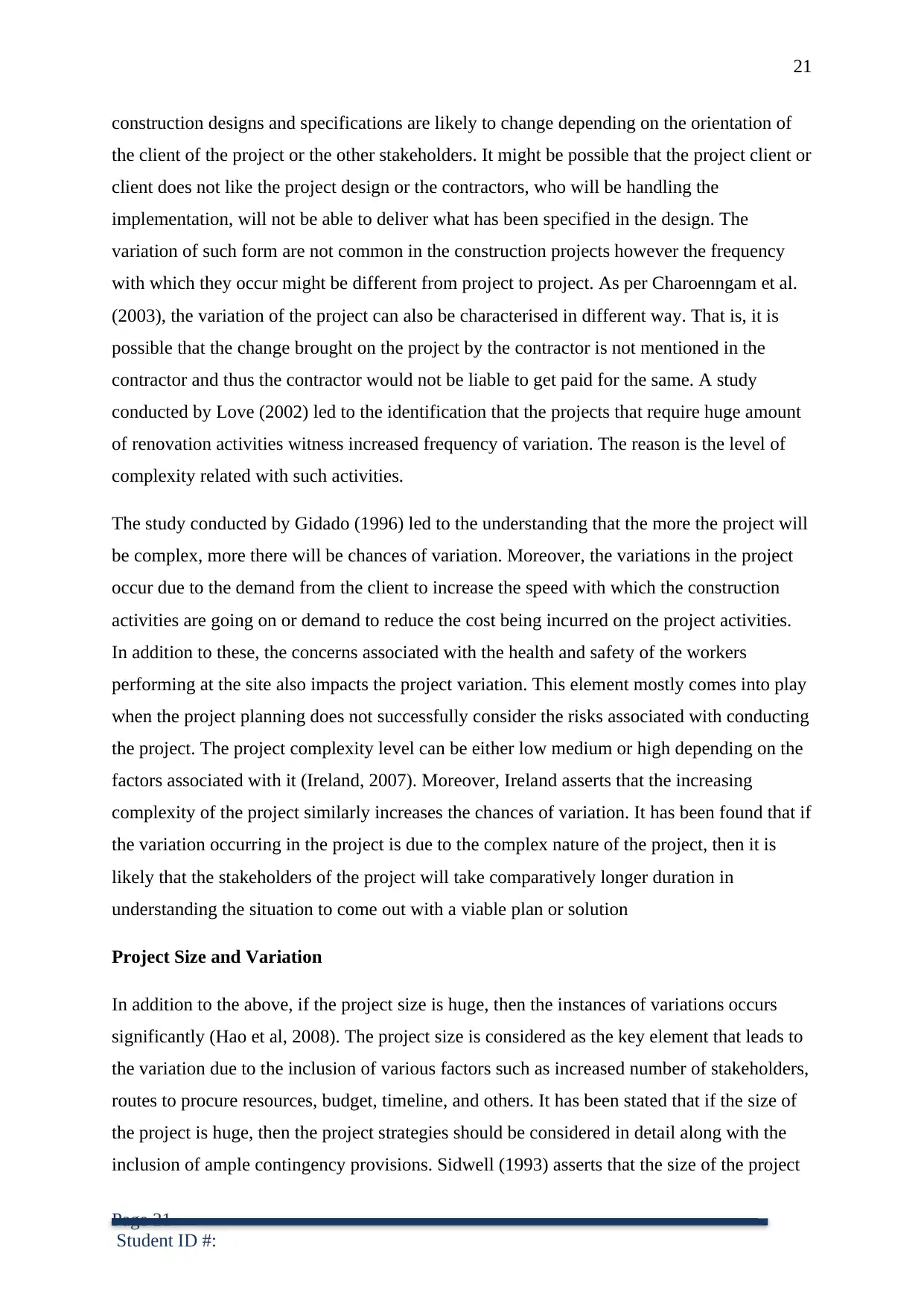
21
construction designs and specifications are likely to change depending on the orientation of
the client of the project or the other stakeholders. It might be possible that the project client or
client does not like the project design or the contractors, who will be handling the
implementation, will not be able to deliver what has been specified in the design. The
variation of such form are not common in the construction projects however the frequency
with which they occur might be different from project to project. As per Charoenngam et al.
(2003), the variation of the project can also be characterised in different way. That is, it is
possible that the change brought on the project by the contractor is not mentioned in the
contractor and thus the contractor would not be liable to get paid for the same. A study
conducted by Love (2002) led to the identification that the projects that require huge amount
of renovation activities witness increased frequency of variation. The reason is the level of
complexity related with such activities.
The study conducted by Gidado (1996) led to the understanding that the more the project will
be complex, more there will be chances of variation. Moreover, the variations in the project
occur due to the demand from the client to increase the speed with which the construction
activities are going on or demand to reduce the cost being incurred on the project activities.
In addition to these, the concerns associated with the health and safety of the workers
performing at the site also impacts the project variation. This element mostly comes into play
when the project planning does not successfully consider the risks associated with conducting
the project. The project complexity level can be either low medium or high depending on the
factors associated with it (Ireland, 2007). Moreover, Ireland asserts that the increasing
complexity of the project similarly increases the chances of variation. It has been found that if
the variation occurring in the project is due to the complex nature of the project, then it is
likely that the stakeholders of the project will take comparatively longer duration in
understanding the situation to come out with a viable plan or solution
Project Size and Variation
In addition to the above, if the project size is huge, then the instances of variations occurs
significantly (Hao et al, 2008). The project size is considered as the key element that leads to
the variation due to the inclusion of various factors such as increased number of stakeholders,
routes to procure resources, budget, timeline, and others. It has been stated that if the size of
the project is huge, then the project strategies should be considered in detail along with the
inclusion of ample contingency provisions. Sidwell (1993) asserts that the size of the project
Page 21
Student ID #:
construction designs and specifications are likely to change depending on the orientation of
the client of the project or the other stakeholders. It might be possible that the project client or
client does not like the project design or the contractors, who will be handling the
implementation, will not be able to deliver what has been specified in the design. The
variation of such form are not common in the construction projects however the frequency
with which they occur might be different from project to project. As per Charoenngam et al.
(2003), the variation of the project can also be characterised in different way. That is, it is
possible that the change brought on the project by the contractor is not mentioned in the
contractor and thus the contractor would not be liable to get paid for the same. A study
conducted by Love (2002) led to the identification that the projects that require huge amount
of renovation activities witness increased frequency of variation. The reason is the level of
complexity related with such activities.
The study conducted by Gidado (1996) led to the understanding that the more the project will
be complex, more there will be chances of variation. Moreover, the variations in the project
occur due to the demand from the client to increase the speed with which the construction
activities are going on or demand to reduce the cost being incurred on the project activities.
In addition to these, the concerns associated with the health and safety of the workers
performing at the site also impacts the project variation. This element mostly comes into play
when the project planning does not successfully consider the risks associated with conducting
the project. The project complexity level can be either low medium or high depending on the
factors associated with it (Ireland, 2007). Moreover, Ireland asserts that the increasing
complexity of the project similarly increases the chances of variation. It has been found that if
the variation occurring in the project is due to the complex nature of the project, then it is
likely that the stakeholders of the project will take comparatively longer duration in
understanding the situation to come out with a viable plan or solution
Project Size and Variation
In addition to the above, if the project size is huge, then the instances of variations occurs
significantly (Hao et al, 2008). The project size is considered as the key element that leads to
the variation due to the inclusion of various factors such as increased number of stakeholders,
routes to procure resources, budget, timeline, and others. It has been stated that if the size of
the project is huge, then the project strategies should be considered in detail along with the
inclusion of ample contingency provisions. Sidwell (1993) asserts that the size of the project
Page 21
Student ID #:
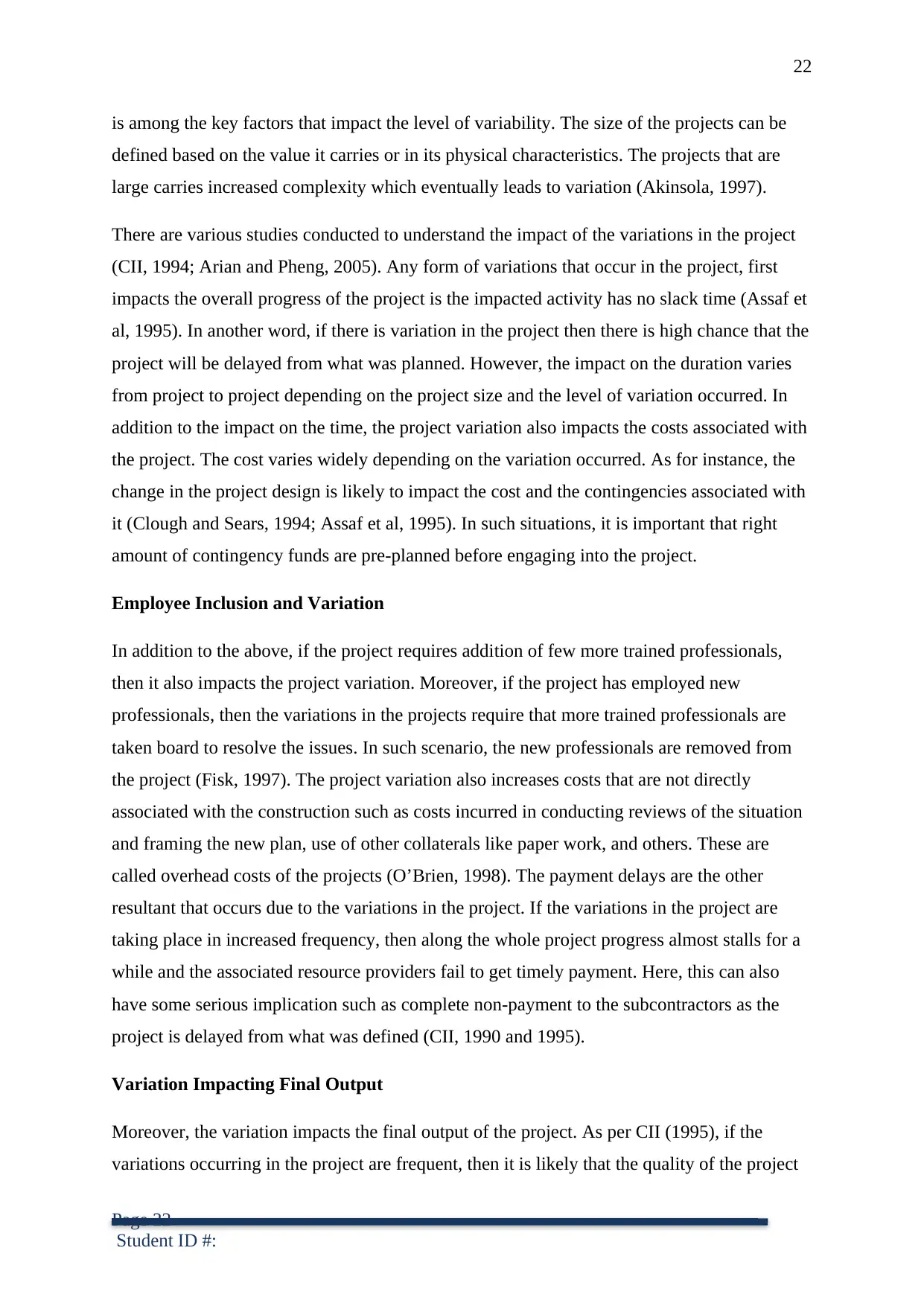
22
is among the key factors that impact the level of variability. The size of the projects can be
defined based on the value it carries or in its physical characteristics. The projects that are
large carries increased complexity which eventually leads to variation (Akinsola, 1997).
There are various studies conducted to understand the impact of the variations in the project
(CII, 1994; Arian and Pheng, 2005). Any form of variations that occur in the project, first
impacts the overall progress of the project is the impacted activity has no slack time (Assaf et
al, 1995). In another word, if there is variation in the project then there is high chance that the
project will be delayed from what was planned. However, the impact on the duration varies
from project to project depending on the project size and the level of variation occurred. In
addition to the impact on the time, the project variation also impacts the costs associated with
the project. The cost varies widely depending on the variation occurred. As for instance, the
change in the project design is likely to impact the cost and the contingencies associated with
it (Clough and Sears, 1994; Assaf et al, 1995). In such situations, it is important that right
amount of contingency funds are pre-planned before engaging into the project.
Employee Inclusion and Variation
In addition to the above, if the project requires addition of few more trained professionals,
then it also impacts the project variation. Moreover, if the project has employed new
professionals, then the variations in the projects require that more trained professionals are
taken board to resolve the issues. In such scenario, the new professionals are removed from
the project (Fisk, 1997). The project variation also increases costs that are not directly
associated with the construction such as costs incurred in conducting reviews of the situation
and framing the new plan, use of other collaterals like paper work, and others. These are
called overhead costs of the projects (O’Brien, 1998). The payment delays are the other
resultant that occurs due to the variations in the project. If the variations in the project are
taking place in increased frequency, then along the whole project progress almost stalls for a
while and the associated resource providers fail to get timely payment. Here, this can also
have some serious implication such as complete non-payment to the subcontractors as the
project is delayed from what was defined (CII, 1990 and 1995).
Variation Impacting Final Output
Moreover, the variation impacts the final output of the project. As per CII (1995), if the
variations occurring in the project are frequent, then it is likely that the quality of the project
Page 22
Student ID #:
is among the key factors that impact the level of variability. The size of the projects can be
defined based on the value it carries or in its physical characteristics. The projects that are
large carries increased complexity which eventually leads to variation (Akinsola, 1997).
There are various studies conducted to understand the impact of the variations in the project
(CII, 1994; Arian and Pheng, 2005). Any form of variations that occur in the project, first
impacts the overall progress of the project is the impacted activity has no slack time (Assaf et
al, 1995). In another word, if there is variation in the project then there is high chance that the
project will be delayed from what was planned. However, the impact on the duration varies
from project to project depending on the project size and the level of variation occurred. In
addition to the impact on the time, the project variation also impacts the costs associated with
the project. The cost varies widely depending on the variation occurred. As for instance, the
change in the project design is likely to impact the cost and the contingencies associated with
it (Clough and Sears, 1994; Assaf et al, 1995). In such situations, it is important that right
amount of contingency funds are pre-planned before engaging into the project.
Employee Inclusion and Variation
In addition to the above, if the project requires addition of few more trained professionals,
then it also impacts the project variation. Moreover, if the project has employed new
professionals, then the variations in the projects require that more trained professionals are
taken board to resolve the issues. In such scenario, the new professionals are removed from
the project (Fisk, 1997). The project variation also increases costs that are not directly
associated with the construction such as costs incurred in conducting reviews of the situation
and framing the new plan, use of other collaterals like paper work, and others. These are
called overhead costs of the projects (O’Brien, 1998). The payment delays are the other
resultant that occurs due to the variations in the project. If the variations in the project are
taking place in increased frequency, then along the whole project progress almost stalls for a
while and the associated resource providers fail to get timely payment. Here, this can also
have some serious implication such as complete non-payment to the subcontractors as the
project is delayed from what was defined (CII, 1990 and 1995).
Variation Impacting Final Output
Moreover, the variation impacts the final output of the project. As per CII (1995), if the
variations occurring in the project are frequent, then it is likely that the quality of the project
Page 22
Student ID #:
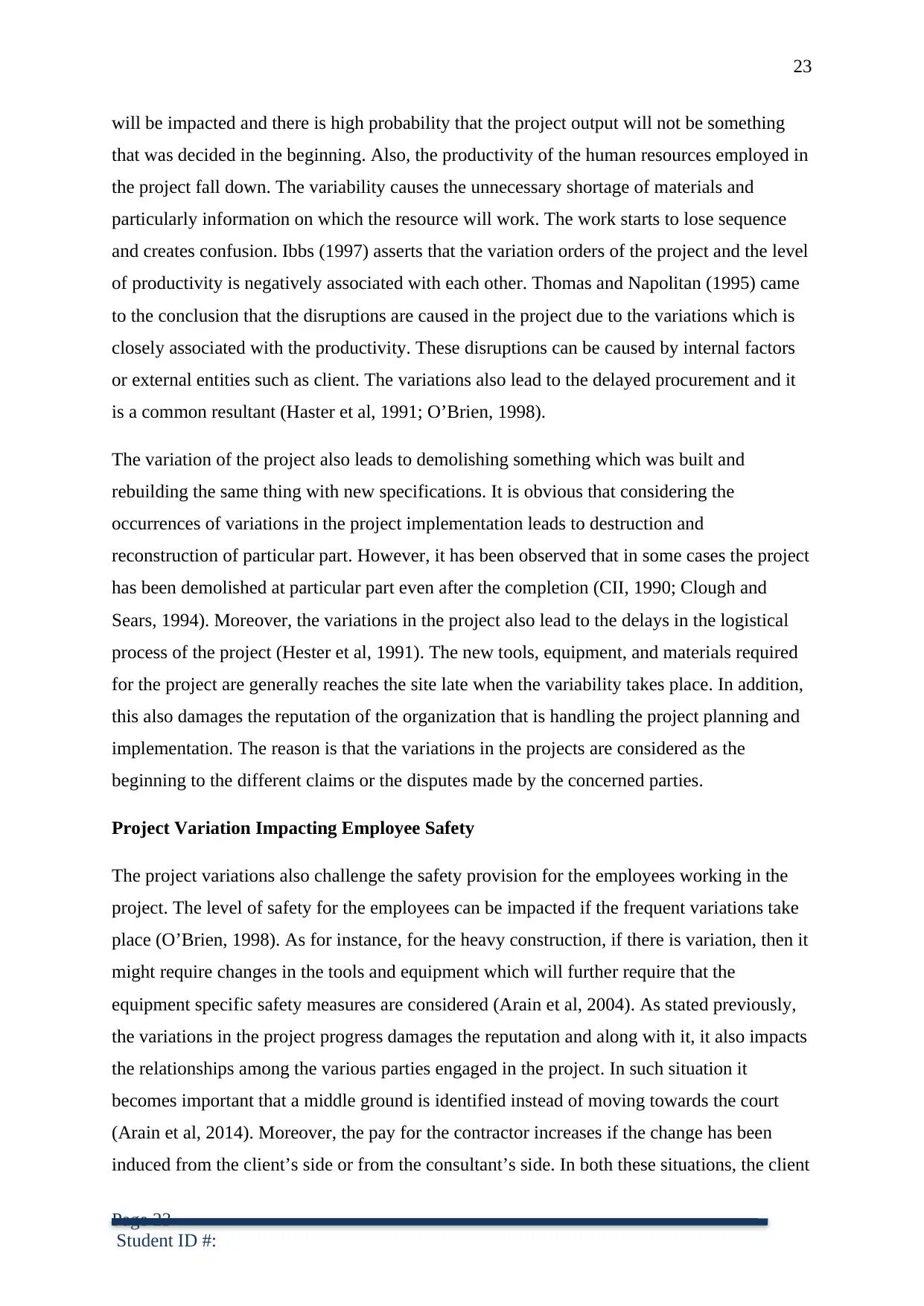
23
will be impacted and there is high probability that the project output will not be something
that was decided in the beginning. Also, the productivity of the human resources employed in
the project fall down. The variability causes the unnecessary shortage of materials and
particularly information on which the resource will work. The work starts to lose sequence
and creates confusion. Ibbs (1997) asserts that the variation orders of the project and the level
of productivity is negatively associated with each other. Thomas and Napolitan (1995) came
to the conclusion that the disruptions are caused in the project due to the variations which is
closely associated with the productivity. These disruptions can be caused by internal factors
or external entities such as client. The variations also lead to the delayed procurement and it
is a common resultant (Haster et al, 1991; O’Brien, 1998).
The variation of the project also leads to demolishing something which was built and
rebuilding the same thing with new specifications. It is obvious that considering the
occurrences of variations in the project implementation leads to destruction and
reconstruction of particular part. However, it has been observed that in some cases the project
has been demolished at particular part even after the completion (CII, 1990; Clough and
Sears, 1994). Moreover, the variations in the project also lead to the delays in the logistical
process of the project (Hester et al, 1991). The new tools, equipment, and materials required
for the project are generally reaches the site late when the variability takes place. In addition,
this also damages the reputation of the organization that is handling the project planning and
implementation. The reason is that the variations in the projects are considered as the
beginning to the different claims or the disputes made by the concerned parties.
Project Variation Impacting Employee Safety
The project variations also challenge the safety provision for the employees working in the
project. The level of safety for the employees can be impacted if the frequent variations take
place (O’Brien, 1998). As for instance, for the heavy construction, if there is variation, then it
might require changes in the tools and equipment which will further require that the
equipment specific safety measures are considered (Arain et al, 2004). As stated previously,
the variations in the project progress damages the reputation and along with it, it also impacts
the relationships among the various parties engaged in the project. In such situation it
becomes important that a middle ground is identified instead of moving towards the court
(Arain et al, 2014). Moreover, the pay for the contractor increases if the change has been
induced from the client’s side or from the consultant’s side. In both these situations, the client
Page 23
Student ID #:
will be impacted and there is high probability that the project output will not be something
that was decided in the beginning. Also, the productivity of the human resources employed in
the project fall down. The variability causes the unnecessary shortage of materials and
particularly information on which the resource will work. The work starts to lose sequence
and creates confusion. Ibbs (1997) asserts that the variation orders of the project and the level
of productivity is negatively associated with each other. Thomas and Napolitan (1995) came
to the conclusion that the disruptions are caused in the project due to the variations which is
closely associated with the productivity. These disruptions can be caused by internal factors
or external entities such as client. The variations also lead to the delayed procurement and it
is a common resultant (Haster et al, 1991; O’Brien, 1998).
The variation of the project also leads to demolishing something which was built and
rebuilding the same thing with new specifications. It is obvious that considering the
occurrences of variations in the project implementation leads to destruction and
reconstruction of particular part. However, it has been observed that in some cases the project
has been demolished at particular part even after the completion (CII, 1990; Clough and
Sears, 1994). Moreover, the variations in the project also lead to the delays in the logistical
process of the project (Hester et al, 1991). The new tools, equipment, and materials required
for the project are generally reaches the site late when the variability takes place. In addition,
this also damages the reputation of the organization that is handling the project planning and
implementation. The reason is that the variations in the projects are considered as the
beginning to the different claims or the disputes made by the concerned parties.
Project Variation Impacting Employee Safety
The project variations also challenge the safety provision for the employees working in the
project. The level of safety for the employees can be impacted if the frequent variations take
place (O’Brien, 1998). As for instance, for the heavy construction, if there is variation, then it
might require changes in the tools and equipment which will further require that the
equipment specific safety measures are considered (Arain et al, 2004). As stated previously,
the variations in the project progress damages the reputation and along with it, it also impacts
the relationships among the various parties engaged in the project. In such situation it
becomes important that a middle ground is identified instead of moving towards the court
(Arain et al, 2014). Moreover, the pay for the contractor increases if the change has been
induced from the client’s side or from the consultant’s side. In both these situations, the client
Page 23
Student ID #:
Paraphrase This Document
Need a fresh take? Get an instant paraphrase of this document with our AI Paraphraser
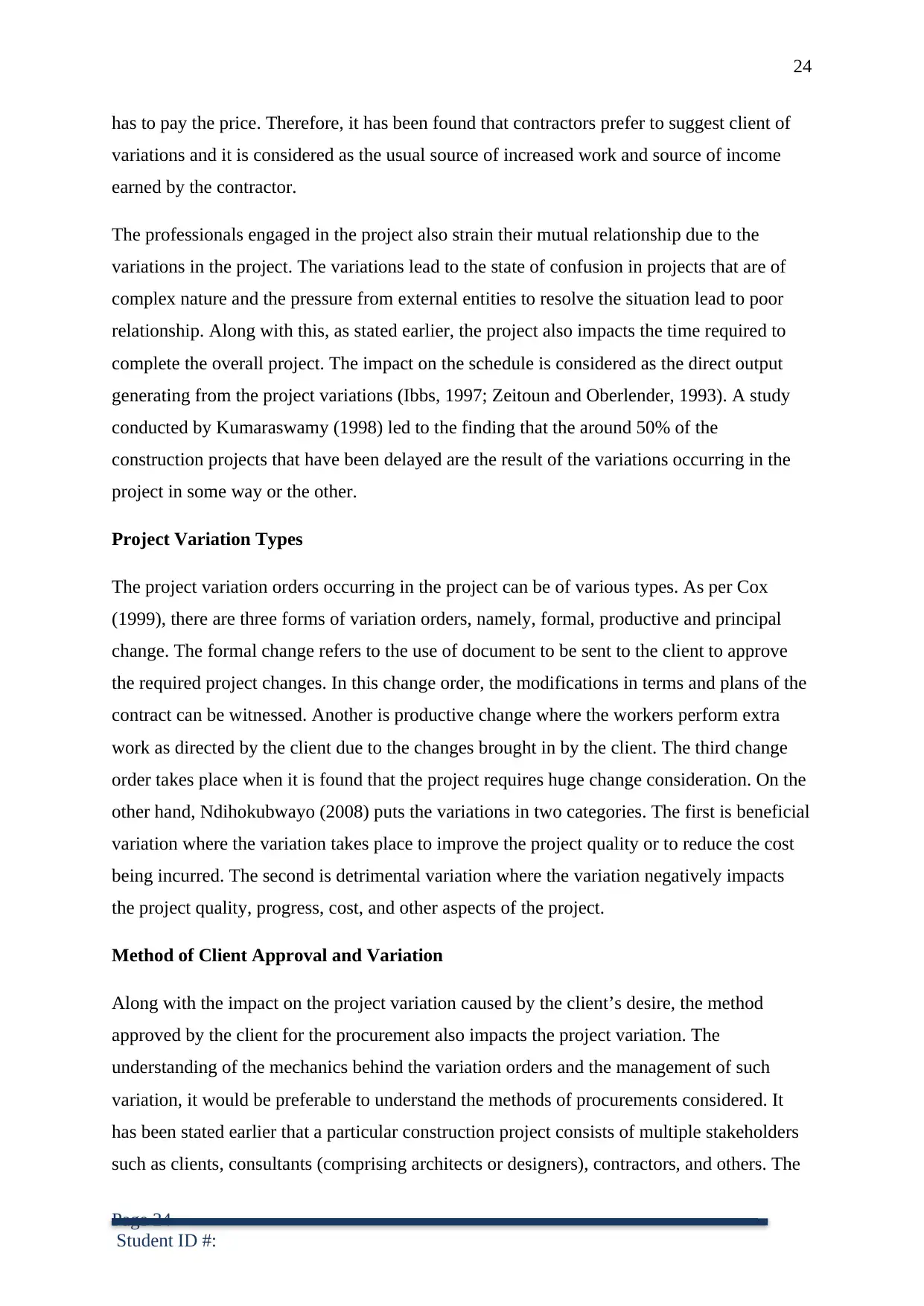
24
has to pay the price. Therefore, it has been found that contractors prefer to suggest client of
variations and it is considered as the usual source of increased work and source of income
earned by the contractor.
The professionals engaged in the project also strain their mutual relationship due to the
variations in the project. The variations lead to the state of confusion in projects that are of
complex nature and the pressure from external entities to resolve the situation lead to poor
relationship. Along with this, as stated earlier, the project also impacts the time required to
complete the overall project. The impact on the schedule is considered as the direct output
generating from the project variations (Ibbs, 1997; Zeitoun and Oberlender, 1993). A study
conducted by Kumaraswamy (1998) led to the finding that the around 50% of the
construction projects that have been delayed are the result of the variations occurring in the
project in some way or the other.
Project Variation Types
The project variation orders occurring in the project can be of various types. As per Cox
(1999), there are three forms of variation orders, namely, formal, productive and principal
change. The formal change refers to the use of document to be sent to the client to approve
the required project changes. In this change order, the modifications in terms and plans of the
contract can be witnessed. Another is productive change where the workers perform extra
work as directed by the client due to the changes brought in by the client. The third change
order takes place when it is found that the project requires huge change consideration. On the
other hand, Ndihokubwayo (2008) puts the variations in two categories. The first is beneficial
variation where the variation takes place to improve the project quality or to reduce the cost
being incurred. The second is detrimental variation where the variation negatively impacts
the project quality, progress, cost, and other aspects of the project.
Method of Client Approval and Variation
Along with the impact on the project variation caused by the client’s desire, the method
approved by the client for the procurement also impacts the project variation. The
understanding of the mechanics behind the variation orders and the management of such
variation, it would be preferable to understand the methods of procurements considered. It
has been stated earlier that a particular construction project consists of multiple stakeholders
such as clients, consultants (comprising architects or designers), contractors, and others. The
Page 24
Student ID #:
has to pay the price. Therefore, it has been found that contractors prefer to suggest client of
variations and it is considered as the usual source of increased work and source of income
earned by the contractor.
The professionals engaged in the project also strain their mutual relationship due to the
variations in the project. The variations lead to the state of confusion in projects that are of
complex nature and the pressure from external entities to resolve the situation lead to poor
relationship. Along with this, as stated earlier, the project also impacts the time required to
complete the overall project. The impact on the schedule is considered as the direct output
generating from the project variations (Ibbs, 1997; Zeitoun and Oberlender, 1993). A study
conducted by Kumaraswamy (1998) led to the finding that the around 50% of the
construction projects that have been delayed are the result of the variations occurring in the
project in some way or the other.
Project Variation Types
The project variation orders occurring in the project can be of various types. As per Cox
(1999), there are three forms of variation orders, namely, formal, productive and principal
change. The formal change refers to the use of document to be sent to the client to approve
the required project changes. In this change order, the modifications in terms and plans of the
contract can be witnessed. Another is productive change where the workers perform extra
work as directed by the client due to the changes brought in by the client. The third change
order takes place when it is found that the project requires huge change consideration. On the
other hand, Ndihokubwayo (2008) puts the variations in two categories. The first is beneficial
variation where the variation takes place to improve the project quality or to reduce the cost
being incurred. The second is detrimental variation where the variation negatively impacts
the project quality, progress, cost, and other aspects of the project.
Method of Client Approval and Variation
Along with the impact on the project variation caused by the client’s desire, the method
approved by the client for the procurement also impacts the project variation. The
understanding of the mechanics behind the variation orders and the management of such
variation, it would be preferable to understand the methods of procurements considered. It
has been stated earlier that a particular construction project consists of multiple stakeholders
such as clients, consultants (comprising architects or designers), contractors, and others. The
Page 24
Student ID #:
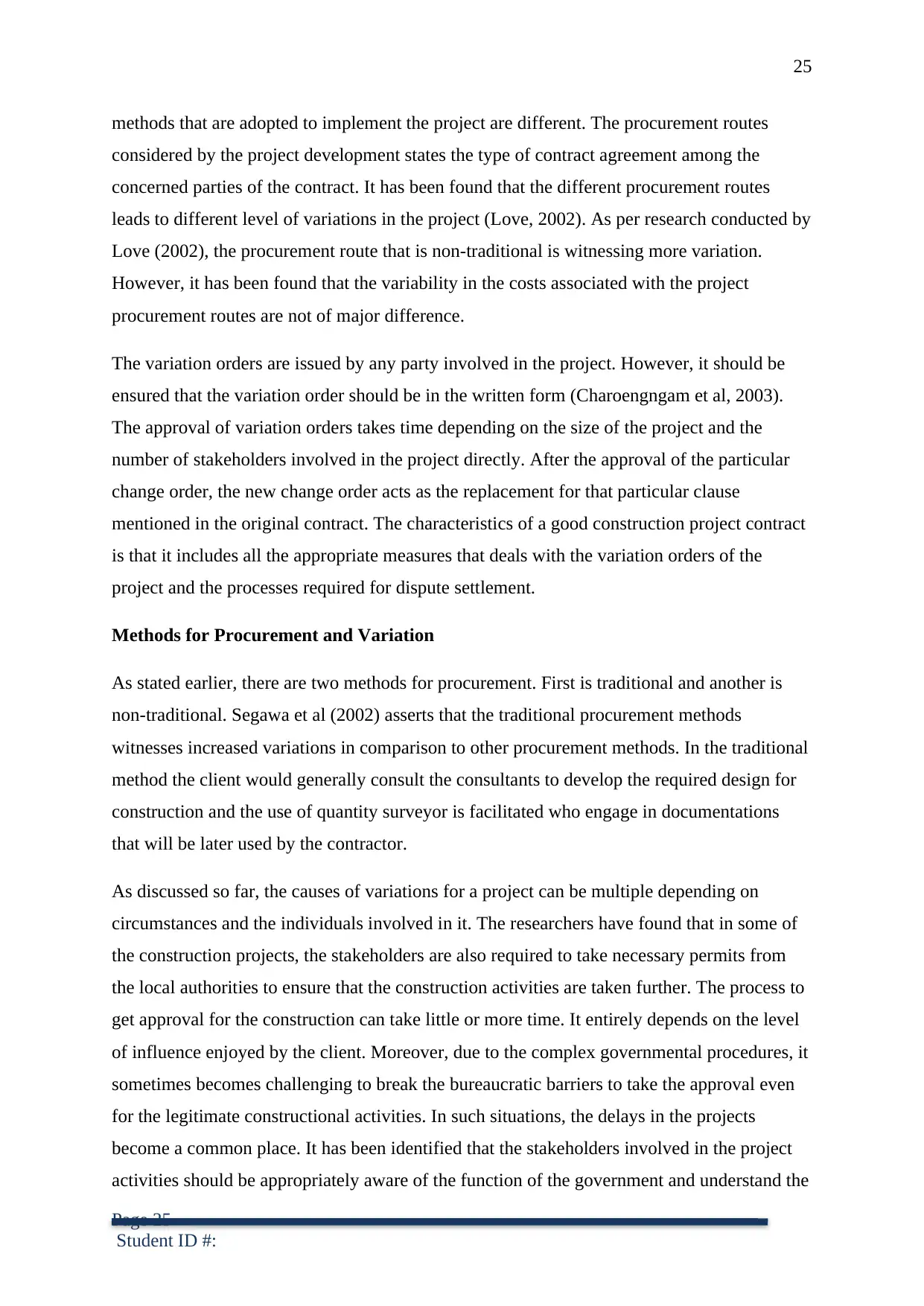
25
methods that are adopted to implement the project are different. The procurement routes
considered by the project development states the type of contract agreement among the
concerned parties of the contract. It has been found that the different procurement routes
leads to different level of variations in the project (Love, 2002). As per research conducted by
Love (2002), the procurement route that is non-traditional is witnessing more variation.
However, it has been found that the variability in the costs associated with the project
procurement routes are not of major difference.
The variation orders are issued by any party involved in the project. However, it should be
ensured that the variation order should be in the written form (Charoengngam et al, 2003).
The approval of variation orders takes time depending on the size of the project and the
number of stakeholders involved in the project directly. After the approval of the particular
change order, the new change order acts as the replacement for that particular clause
mentioned in the original contract. The characteristics of a good construction project contract
is that it includes all the appropriate measures that deals with the variation orders of the
project and the processes required for dispute settlement.
Methods for Procurement and Variation
As stated earlier, there are two methods for procurement. First is traditional and another is
non-traditional. Segawa et al (2002) asserts that the traditional procurement methods
witnesses increased variations in comparison to other procurement methods. In the traditional
method the client would generally consult the consultants to develop the required design for
construction and the use of quantity surveyor is facilitated who engage in documentations
that will be later used by the contractor.
As discussed so far, the causes of variations for a project can be multiple depending on
circumstances and the individuals involved in it. The researchers have found that in some of
the construction projects, the stakeholders are also required to take necessary permits from
the local authorities to ensure that the construction activities are taken further. The process to
get approval for the construction can take little or more time. It entirely depends on the level
of influence enjoyed by the client. Moreover, due to the complex governmental procedures, it
sometimes becomes challenging to break the bureaucratic barriers to take the approval even
for the legitimate constructional activities. In such situations, the delays in the projects
become a common place. It has been identified that the stakeholders involved in the project
activities should be appropriately aware of the function of the government and understand the
Page 25
Student ID #:
methods that are adopted to implement the project are different. The procurement routes
considered by the project development states the type of contract agreement among the
concerned parties of the contract. It has been found that the different procurement routes
leads to different level of variations in the project (Love, 2002). As per research conducted by
Love (2002), the procurement route that is non-traditional is witnessing more variation.
However, it has been found that the variability in the costs associated with the project
procurement routes are not of major difference.
The variation orders are issued by any party involved in the project. However, it should be
ensured that the variation order should be in the written form (Charoengngam et al, 2003).
The approval of variation orders takes time depending on the size of the project and the
number of stakeholders involved in the project directly. After the approval of the particular
change order, the new change order acts as the replacement for that particular clause
mentioned in the original contract. The characteristics of a good construction project contract
is that it includes all the appropriate measures that deals with the variation orders of the
project and the processes required for dispute settlement.
Methods for Procurement and Variation
As stated earlier, there are two methods for procurement. First is traditional and another is
non-traditional. Segawa et al (2002) asserts that the traditional procurement methods
witnesses increased variations in comparison to other procurement methods. In the traditional
method the client would generally consult the consultants to develop the required design for
construction and the use of quantity surveyor is facilitated who engage in documentations
that will be later used by the contractor.
As discussed so far, the causes of variations for a project can be multiple depending on
circumstances and the individuals involved in it. The researchers have found that in some of
the construction projects, the stakeholders are also required to take necessary permits from
the local authorities to ensure that the construction activities are taken further. The process to
get approval for the construction can take little or more time. It entirely depends on the level
of influence enjoyed by the client. Moreover, due to the complex governmental procedures, it
sometimes becomes challenging to break the bureaucratic barriers to take the approval even
for the legitimate constructional activities. In such situations, the delays in the projects
become a common place. It has been identified that the stakeholders involved in the project
activities should be appropriately aware of the function of the government and understand the
Page 25
Student ID #:
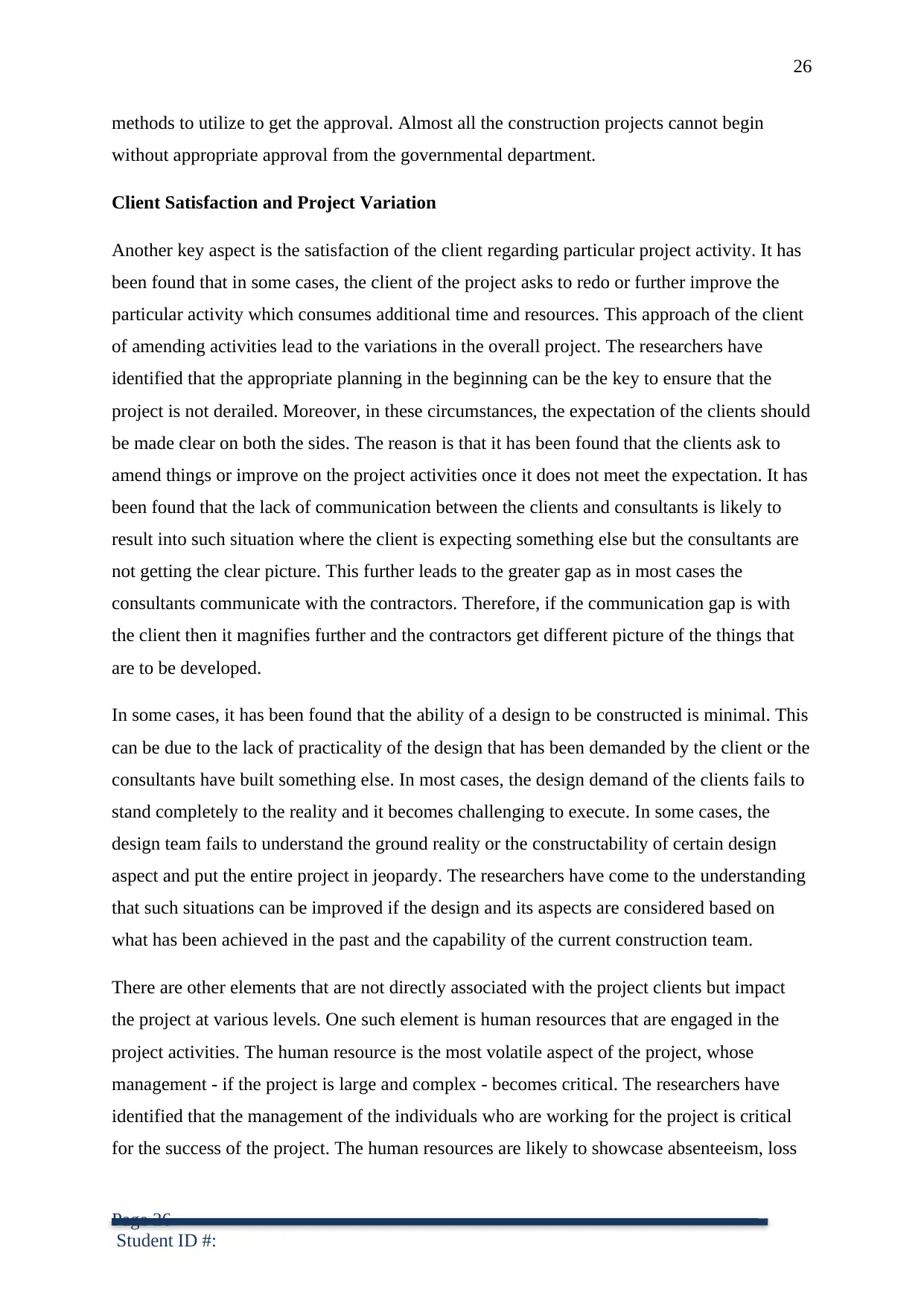
26
methods to utilize to get the approval. Almost all the construction projects cannot begin
without appropriate approval from the governmental department.
Client Satisfaction and Project Variation
Another key aspect is the satisfaction of the client regarding particular project activity. It has
been found that in some cases, the client of the project asks to redo or further improve the
particular activity which consumes additional time and resources. This approach of the client
of amending activities lead to the variations in the overall project. The researchers have
identified that the appropriate planning in the beginning can be the key to ensure that the
project is not derailed. Moreover, in these circumstances, the expectation of the clients should
be made clear on both the sides. The reason is that it has been found that the clients ask to
amend things or improve on the project activities once it does not meet the expectation. It has
been found that the lack of communication between the clients and consultants is likely to
result into such situation where the client is expecting something else but the consultants are
not getting the clear picture. This further leads to the greater gap as in most cases the
consultants communicate with the contractors. Therefore, if the communication gap is with
the client then it magnifies further and the contractors get different picture of the things that
are to be developed.
In some cases, it has been found that the ability of a design to be constructed is minimal. This
can be due to the lack of practicality of the design that has been demanded by the client or the
consultants have built something else. In most cases, the design demand of the clients fails to
stand completely to the reality and it becomes challenging to execute. In some cases, the
design team fails to understand the ground reality or the constructability of certain design
aspect and put the entire project in jeopardy. The researchers have come to the understanding
that such situations can be improved if the design and its aspects are considered based on
what has been achieved in the past and the capability of the current construction team.
There are other elements that are not directly associated with the project clients but impact
the project at various levels. One such element is human resources that are engaged in the
project activities. The human resource is the most volatile aspect of the project, whose
management - if the project is large and complex - becomes critical. The researchers have
identified that the management of the individuals who are working for the project is critical
for the success of the project. The human resources are likely to showcase absenteeism, loss
Page 26
Student ID #:
methods to utilize to get the approval. Almost all the construction projects cannot begin
without appropriate approval from the governmental department.
Client Satisfaction and Project Variation
Another key aspect is the satisfaction of the client regarding particular project activity. It has
been found that in some cases, the client of the project asks to redo or further improve the
particular activity which consumes additional time and resources. This approach of the client
of amending activities lead to the variations in the overall project. The researchers have
identified that the appropriate planning in the beginning can be the key to ensure that the
project is not derailed. Moreover, in these circumstances, the expectation of the clients should
be made clear on both the sides. The reason is that it has been found that the clients ask to
amend things or improve on the project activities once it does not meet the expectation. It has
been found that the lack of communication between the clients and consultants is likely to
result into such situation where the client is expecting something else but the consultants are
not getting the clear picture. This further leads to the greater gap as in most cases the
consultants communicate with the contractors. Therefore, if the communication gap is with
the client then it magnifies further and the contractors get different picture of the things that
are to be developed.
In some cases, it has been found that the ability of a design to be constructed is minimal. This
can be due to the lack of practicality of the design that has been demanded by the client or the
consultants have built something else. In most cases, the design demand of the clients fails to
stand completely to the reality and it becomes challenging to execute. In some cases, the
design team fails to understand the ground reality or the constructability of certain design
aspect and put the entire project in jeopardy. The researchers have come to the understanding
that such situations can be improved if the design and its aspects are considered based on
what has been achieved in the past and the capability of the current construction team.
There are other elements that are not directly associated with the project clients but impact
the project at various levels. One such element is human resources that are engaged in the
project activities. The human resource is the most volatile aspect of the project, whose
management - if the project is large and complex - becomes critical. The researchers have
identified that the management of the individuals who are working for the project is critical
for the success of the project. The human resources are likely to showcase absenteeism, loss
Page 26
Student ID #:
Secure Best Marks with AI Grader
Need help grading? Try our AI Grader for instant feedback on your assignments.
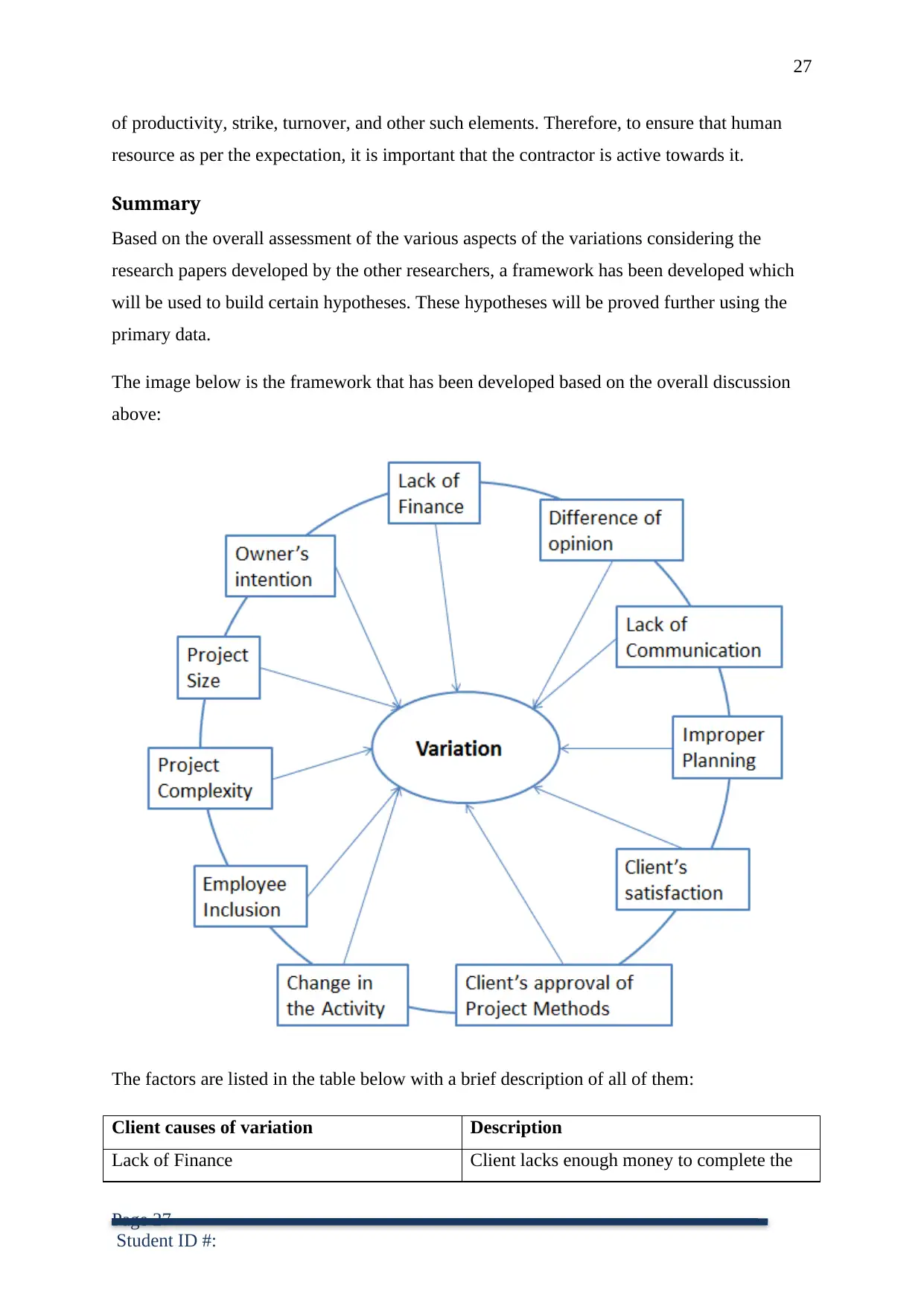
27
of productivity, strike, turnover, and other such elements. Therefore, to ensure that human
resource as per the expectation, it is important that the contractor is active towards it.
Summary
Based on the overall assessment of the various aspects of the variations considering the
research papers developed by the other researchers, a framework has been developed which
will be used to build certain hypotheses. These hypotheses will be proved further using the
primary data.
The image below is the framework that has been developed based on the overall discussion
above:
The factors are listed in the table below with a brief description of all of them:
Client causes of variation Description
Lack of Finance Client lacks enough money to complete the
Page 27
Student ID #:
of productivity, strike, turnover, and other such elements. Therefore, to ensure that human
resource as per the expectation, it is important that the contractor is active towards it.
Summary
Based on the overall assessment of the various aspects of the variations considering the
research papers developed by the other researchers, a framework has been developed which
will be used to build certain hypotheses. These hypotheses will be proved further using the
primary data.
The image below is the framework that has been developed based on the overall discussion
above:
The factors are listed in the table below with a brief description of all of them:
Client causes of variation Description
Lack of Finance Client lacks enough money to complete the
Page 27
Student ID #:
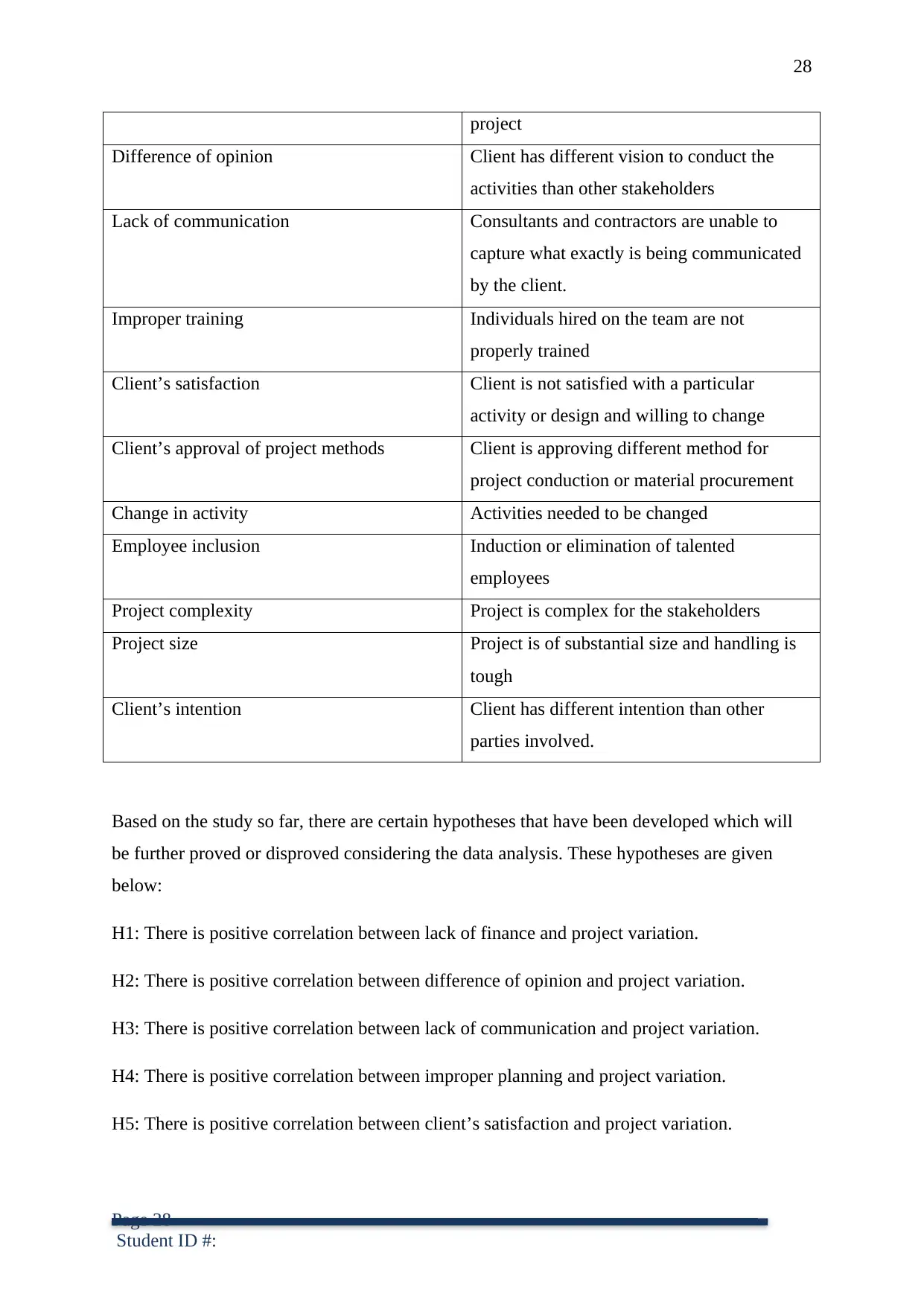
28
project
Difference of opinion Client has different vision to conduct the
activities than other stakeholders
Lack of communication Consultants and contractors are unable to
capture what exactly is being communicated
by the client.
Improper training Individuals hired on the team are not
properly trained
Client’s satisfaction Client is not satisfied with a particular
activity or design and willing to change
Client’s approval of project methods Client is approving different method for
project conduction or material procurement
Change in activity Activities needed to be changed
Employee inclusion Induction or elimination of talented
employees
Project complexity Project is complex for the stakeholders
Project size Project is of substantial size and handling is
tough
Client’s intention Client has different intention than other
parties involved.
Based on the study so far, there are certain hypotheses that have been developed which will
be further proved or disproved considering the data analysis. These hypotheses are given
below:
H1: There is positive correlation between lack of finance and project variation.
H2: There is positive correlation between difference of opinion and project variation.
H3: There is positive correlation between lack of communication and project variation.
H4: There is positive correlation between improper planning and project variation.
H5: There is positive correlation between client’s satisfaction and project variation.
Page 28
Student ID #:
project
Difference of opinion Client has different vision to conduct the
activities than other stakeholders
Lack of communication Consultants and contractors are unable to
capture what exactly is being communicated
by the client.
Improper training Individuals hired on the team are not
properly trained
Client’s satisfaction Client is not satisfied with a particular
activity or design and willing to change
Client’s approval of project methods Client is approving different method for
project conduction or material procurement
Change in activity Activities needed to be changed
Employee inclusion Induction or elimination of talented
employees
Project complexity Project is complex for the stakeholders
Project size Project is of substantial size and handling is
tough
Client’s intention Client has different intention than other
parties involved.
Based on the study so far, there are certain hypotheses that have been developed which will
be further proved or disproved considering the data analysis. These hypotheses are given
below:
H1: There is positive correlation between lack of finance and project variation.
H2: There is positive correlation between difference of opinion and project variation.
H3: There is positive correlation between lack of communication and project variation.
H4: There is positive correlation between improper planning and project variation.
H5: There is positive correlation between client’s satisfaction and project variation.
Page 28
Student ID #:
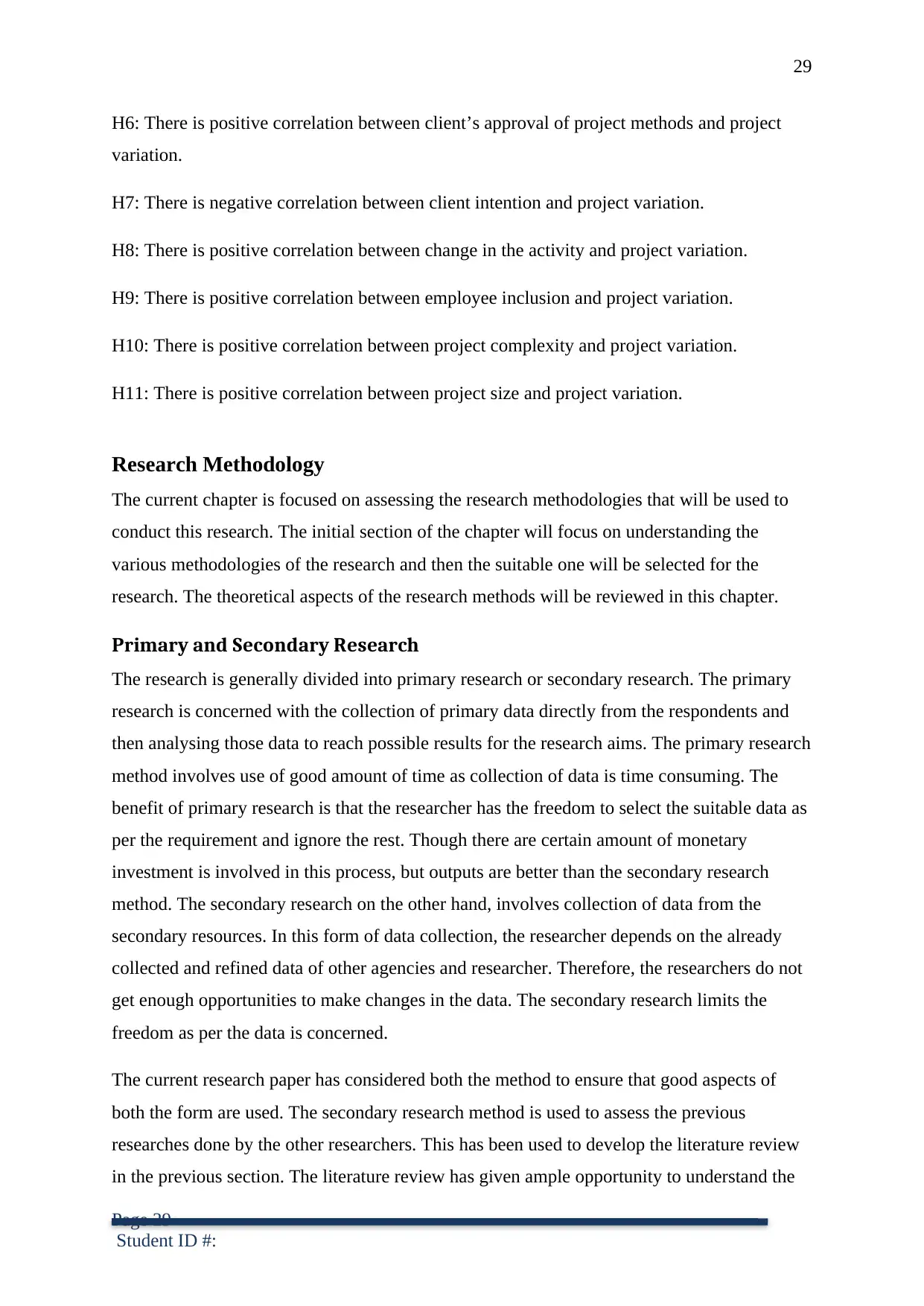
29
H6: There is positive correlation between client’s approval of project methods and project
variation.
H7: There is negative correlation between client intention and project variation.
H8: There is positive correlation between change in the activity and project variation.
H9: There is positive correlation between employee inclusion and project variation.
H10: There is positive correlation between project complexity and project variation.
H11: There is positive correlation between project size and project variation.
Research Methodology
The current chapter is focused on assessing the research methodologies that will be used to
conduct this research. The initial section of the chapter will focus on understanding the
various methodologies of the research and then the suitable one will be selected for the
research. The theoretical aspects of the research methods will be reviewed in this chapter.
Primary and Secondary Research
The research is generally divided into primary research or secondary research. The primary
research is concerned with the collection of primary data directly from the respondents and
then analysing those data to reach possible results for the research aims. The primary research
method involves use of good amount of time as collection of data is time consuming. The
benefit of primary research is that the researcher has the freedom to select the suitable data as
per the requirement and ignore the rest. Though there are certain amount of monetary
investment is involved in this process, but outputs are better than the secondary research
method. The secondary research on the other hand, involves collection of data from the
secondary resources. In this form of data collection, the researcher depends on the already
collected and refined data of other agencies and researcher. Therefore, the researchers do not
get enough opportunities to make changes in the data. The secondary research limits the
freedom as per the data is concerned.
The current research paper has considered both the method to ensure that good aspects of
both the form are used. The secondary research method is used to assess the previous
researches done by the other researchers. This has been used to develop the literature review
in the previous section. The literature review has given ample opportunity to understand the
Page 29
Student ID #:
H6: There is positive correlation between client’s approval of project methods and project
variation.
H7: There is negative correlation between client intention and project variation.
H8: There is positive correlation between change in the activity and project variation.
H9: There is positive correlation between employee inclusion and project variation.
H10: There is positive correlation between project complexity and project variation.
H11: There is positive correlation between project size and project variation.
Research Methodology
The current chapter is focused on assessing the research methodologies that will be used to
conduct this research. The initial section of the chapter will focus on understanding the
various methodologies of the research and then the suitable one will be selected for the
research. The theoretical aspects of the research methods will be reviewed in this chapter.
Primary and Secondary Research
The research is generally divided into primary research or secondary research. The primary
research is concerned with the collection of primary data directly from the respondents and
then analysing those data to reach possible results for the research aims. The primary research
method involves use of good amount of time as collection of data is time consuming. The
benefit of primary research is that the researcher has the freedom to select the suitable data as
per the requirement and ignore the rest. Though there are certain amount of monetary
investment is involved in this process, but outputs are better than the secondary research
method. The secondary research on the other hand, involves collection of data from the
secondary resources. In this form of data collection, the researcher depends on the already
collected and refined data of other agencies and researcher. Therefore, the researchers do not
get enough opportunities to make changes in the data. The secondary research limits the
freedom as per the data is concerned.
The current research paper has considered both the method to ensure that good aspects of
both the form are used. The secondary research method is used to assess the previous
researches done by the other researchers. This has been used to develop the literature review
in the previous section. The literature review has given ample opportunity to understand the
Page 29
Student ID #:
Paraphrase This Document
Need a fresh take? Get an instant paraphrase of this document with our AI Paraphraser
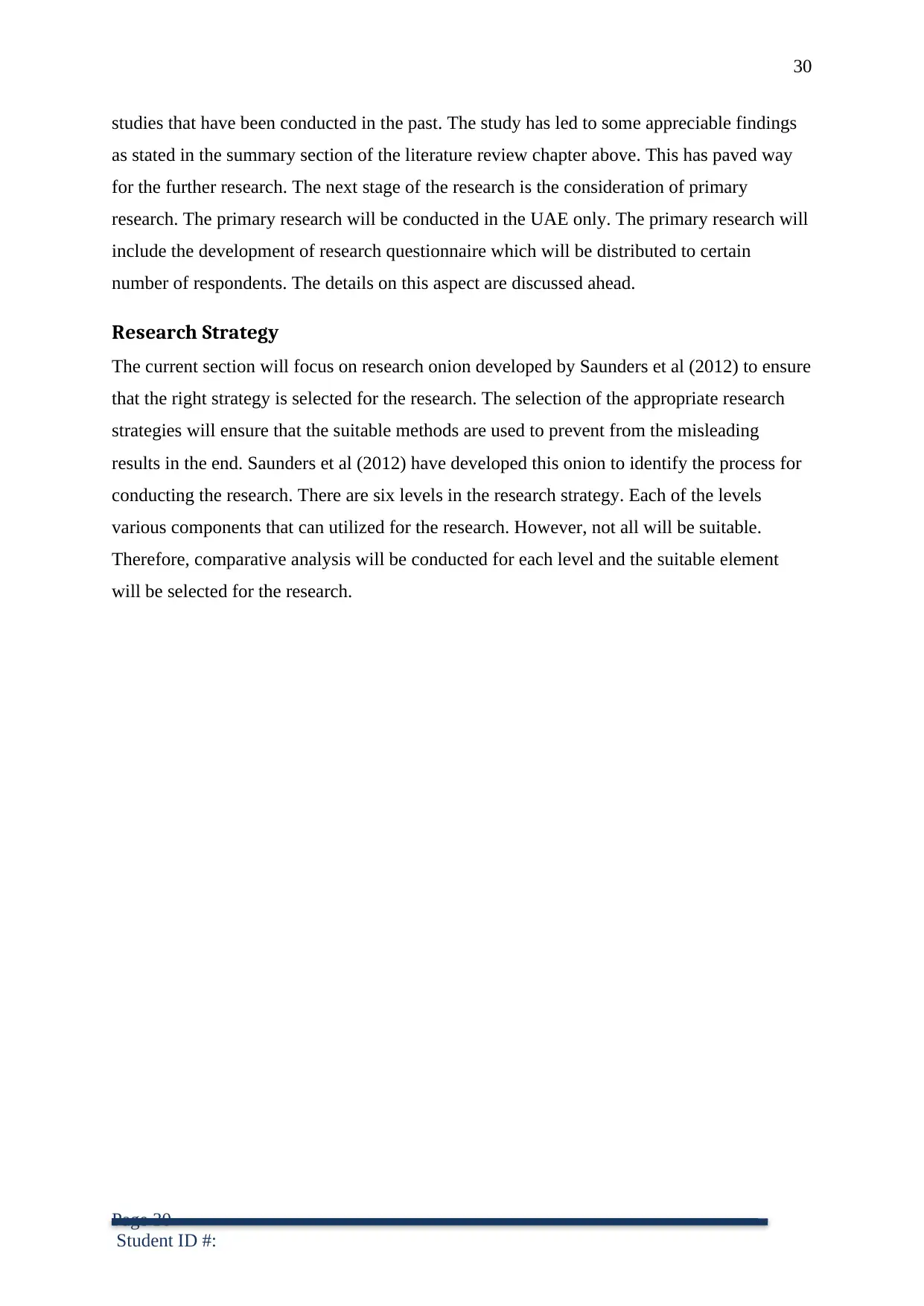
30
studies that have been conducted in the past. The study has led to some appreciable findings
as stated in the summary section of the literature review chapter above. This has paved way
for the further research. The next stage of the research is the consideration of primary
research. The primary research will be conducted in the UAE only. The primary research will
include the development of research questionnaire which will be distributed to certain
number of respondents. The details on this aspect are discussed ahead.
Research Strategy
The current section will focus on research onion developed by Saunders et al (2012) to ensure
that the right strategy is selected for the research. The selection of the appropriate research
strategies will ensure that the suitable methods are used to prevent from the misleading
results in the end. Saunders et al (2012) have developed this onion to identify the process for
conducting the research. There are six levels in the research strategy. Each of the levels
various components that can utilized for the research. However, not all will be suitable.
Therefore, comparative analysis will be conducted for each level and the suitable element
will be selected for the research.
Page 30
Student ID #:
studies that have been conducted in the past. The study has led to some appreciable findings
as stated in the summary section of the literature review chapter above. This has paved way
for the further research. The next stage of the research is the consideration of primary
research. The primary research will be conducted in the UAE only. The primary research will
include the development of research questionnaire which will be distributed to certain
number of respondents. The details on this aspect are discussed ahead.
Research Strategy
The current section will focus on research onion developed by Saunders et al (2012) to ensure
that the right strategy is selected for the research. The selection of the appropriate research
strategies will ensure that the suitable methods are used to prevent from the misleading
results in the end. Saunders et al (2012) have developed this onion to identify the process for
conducting the research. There are six levels in the research strategy. Each of the levels
various components that can utilized for the research. However, not all will be suitable.
Therefore, comparative analysis will be conducted for each level and the suitable element
will be selected for the research.
Page 30
Student ID #:
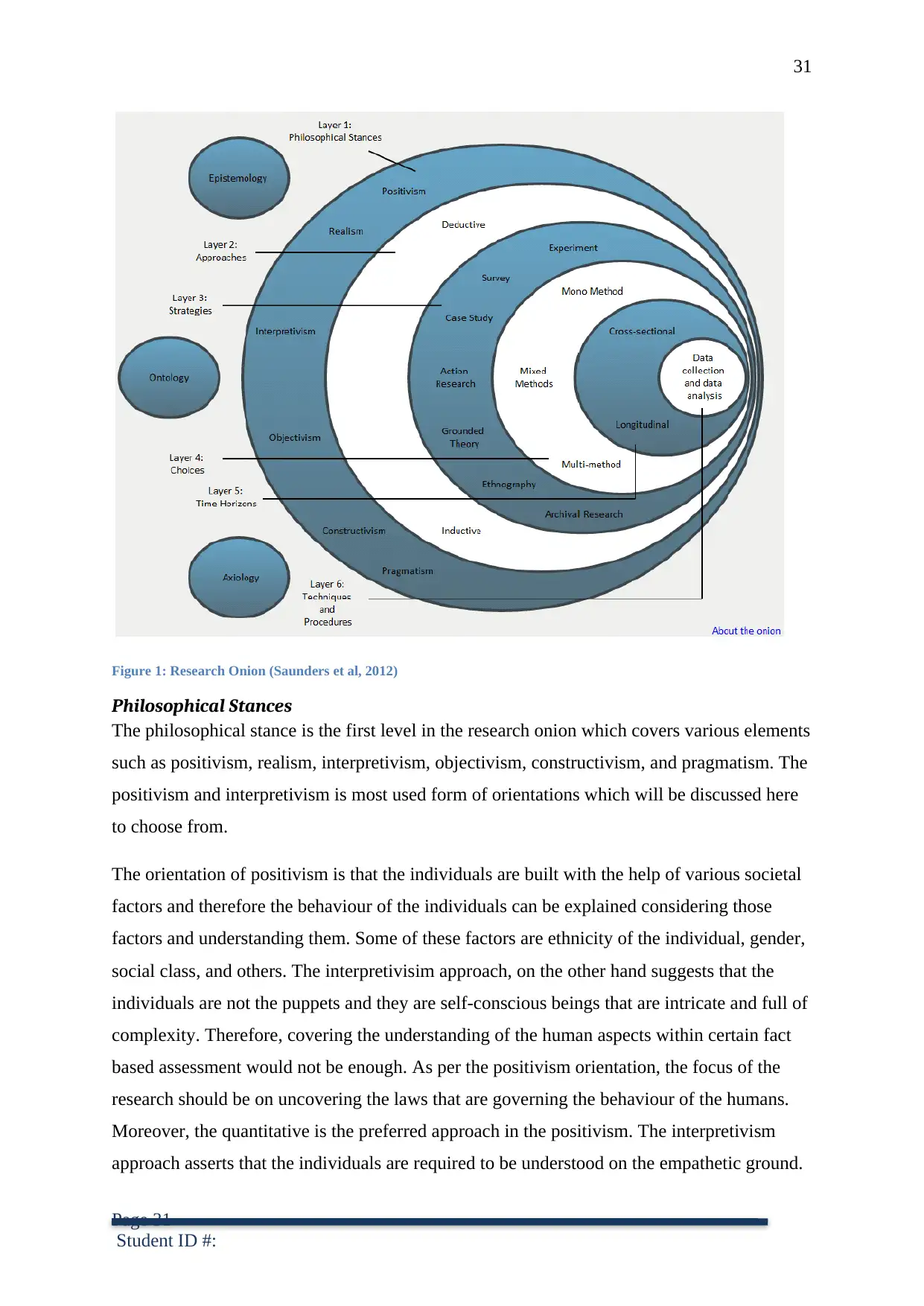
31
Figure 1: Research Onion (Saunders et al, 2012)
Philosophical Stances
The philosophical stance is the first level in the research onion which covers various elements
such as positivism, realism, interpretivism, objectivism, constructivism, and pragmatism. The
positivism and interpretivism is most used form of orientations which will be discussed here
to choose from.
The orientation of positivism is that the individuals are built with the help of various societal
factors and therefore the behaviour of the individuals can be explained considering those
factors and understanding them. Some of these factors are ethnicity of the individual, gender,
social class, and others. The interpretivisim approach, on the other hand suggests that the
individuals are not the puppets and they are self-conscious beings that are intricate and full of
complexity. Therefore, covering the understanding of the human aspects within certain fact
based assessment would not be enough. As per the positivism orientation, the focus of the
research should be on uncovering the laws that are governing the behaviour of the humans.
Moreover, the quantitative is the preferred approach in the positivism. The interpretivism
approach asserts that the individuals are required to be understood on the empathetic ground.
Page 31
Student ID #:
Figure 1: Research Onion (Saunders et al, 2012)
Philosophical Stances
The philosophical stance is the first level in the research onion which covers various elements
such as positivism, realism, interpretivism, objectivism, constructivism, and pragmatism. The
positivism and interpretivism is most used form of orientations which will be discussed here
to choose from.
The orientation of positivism is that the individuals are built with the help of various societal
factors and therefore the behaviour of the individuals can be explained considering those
factors and understanding them. Some of these factors are ethnicity of the individual, gender,
social class, and others. The interpretivisim approach, on the other hand suggests that the
individuals are not the puppets and they are self-conscious beings that are intricate and full of
complexity. Therefore, covering the understanding of the human aspects within certain fact
based assessment would not be enough. As per the positivism orientation, the focus of the
research should be on uncovering the laws that are governing the behaviour of the humans.
Moreover, the quantitative is the preferred approach in the positivism. The interpretivism
approach asserts that the individuals are required to be understood on the empathetic ground.
Page 31
Student ID #:
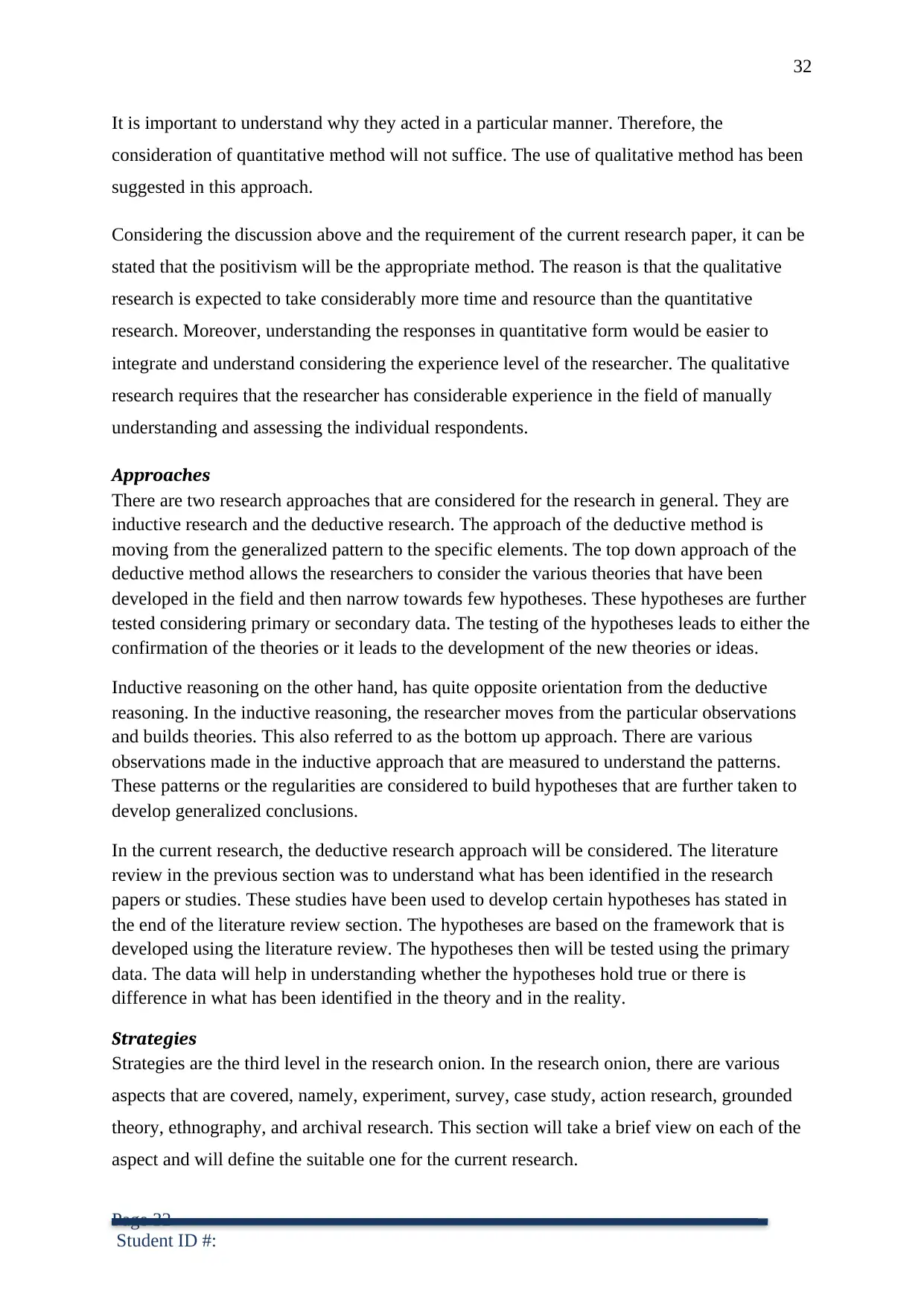
32
It is important to understand why they acted in a particular manner. Therefore, the
consideration of quantitative method will not suffice. The use of qualitative method has been
suggested in this approach.
Considering the discussion above and the requirement of the current research paper, it can be
stated that the positivism will be the appropriate method. The reason is that the qualitative
research is expected to take considerably more time and resource than the quantitative
research. Moreover, understanding the responses in quantitative form would be easier to
integrate and understand considering the experience level of the researcher. The qualitative
research requires that the researcher has considerable experience in the field of manually
understanding and assessing the individual respondents.
Approaches
There are two research approaches that are considered for the research in general. They are
inductive research and the deductive research. The approach of the deductive method is
moving from the generalized pattern to the specific elements. The top down approach of the
deductive method allows the researchers to consider the various theories that have been
developed in the field and then narrow towards few hypotheses. These hypotheses are further
tested considering primary or secondary data. The testing of the hypotheses leads to either the
confirmation of the theories or it leads to the development of the new theories or ideas.
Inductive reasoning on the other hand, has quite opposite orientation from the deductive
reasoning. In the inductive reasoning, the researcher moves from the particular observations
and builds theories. This also referred to as the bottom up approach. There are various
observations made in the inductive approach that are measured to understand the patterns.
These patterns or the regularities are considered to build hypotheses that are further taken to
develop generalized conclusions.
In the current research, the deductive research approach will be considered. The literature
review in the previous section was to understand what has been identified in the research
papers or studies. These studies have been used to develop certain hypotheses has stated in
the end of the literature review section. The hypotheses are based on the framework that is
developed using the literature review. The hypotheses then will be tested using the primary
data. The data will help in understanding whether the hypotheses hold true or there is
difference in what has been identified in the theory and in the reality.
Strategies
Strategies are the third level in the research onion. In the research onion, there are various
aspects that are covered, namely, experiment, survey, case study, action research, grounded
theory, ethnography, and archival research. This section will take a brief view on each of the
aspect and will define the suitable one for the current research.
Page 32
Student ID #:
It is important to understand why they acted in a particular manner. Therefore, the
consideration of quantitative method will not suffice. The use of qualitative method has been
suggested in this approach.
Considering the discussion above and the requirement of the current research paper, it can be
stated that the positivism will be the appropriate method. The reason is that the qualitative
research is expected to take considerably more time and resource than the quantitative
research. Moreover, understanding the responses in quantitative form would be easier to
integrate and understand considering the experience level of the researcher. The qualitative
research requires that the researcher has considerable experience in the field of manually
understanding and assessing the individual respondents.
Approaches
There are two research approaches that are considered for the research in general. They are
inductive research and the deductive research. The approach of the deductive method is
moving from the generalized pattern to the specific elements. The top down approach of the
deductive method allows the researchers to consider the various theories that have been
developed in the field and then narrow towards few hypotheses. These hypotheses are further
tested considering primary or secondary data. The testing of the hypotheses leads to either the
confirmation of the theories or it leads to the development of the new theories or ideas.
Inductive reasoning on the other hand, has quite opposite orientation from the deductive
reasoning. In the inductive reasoning, the researcher moves from the particular observations
and builds theories. This also referred to as the bottom up approach. There are various
observations made in the inductive approach that are measured to understand the patterns.
These patterns or the regularities are considered to build hypotheses that are further taken to
develop generalized conclusions.
In the current research, the deductive research approach will be considered. The literature
review in the previous section was to understand what has been identified in the research
papers or studies. These studies have been used to develop certain hypotheses has stated in
the end of the literature review section. The hypotheses are based on the framework that is
developed using the literature review. The hypotheses then will be tested using the primary
data. The data will help in understanding whether the hypotheses hold true or there is
difference in what has been identified in the theory and in the reality.
Strategies
Strategies are the third level in the research onion. In the research onion, there are various
aspects that are covered, namely, experiment, survey, case study, action research, grounded
theory, ethnography, and archival research. This section will take a brief view on each of the
aspect and will define the suitable one for the current research.
Page 32
Student ID #:
Secure Best Marks with AI Grader
Need help grading? Try our AI Grader for instant feedback on your assignments.
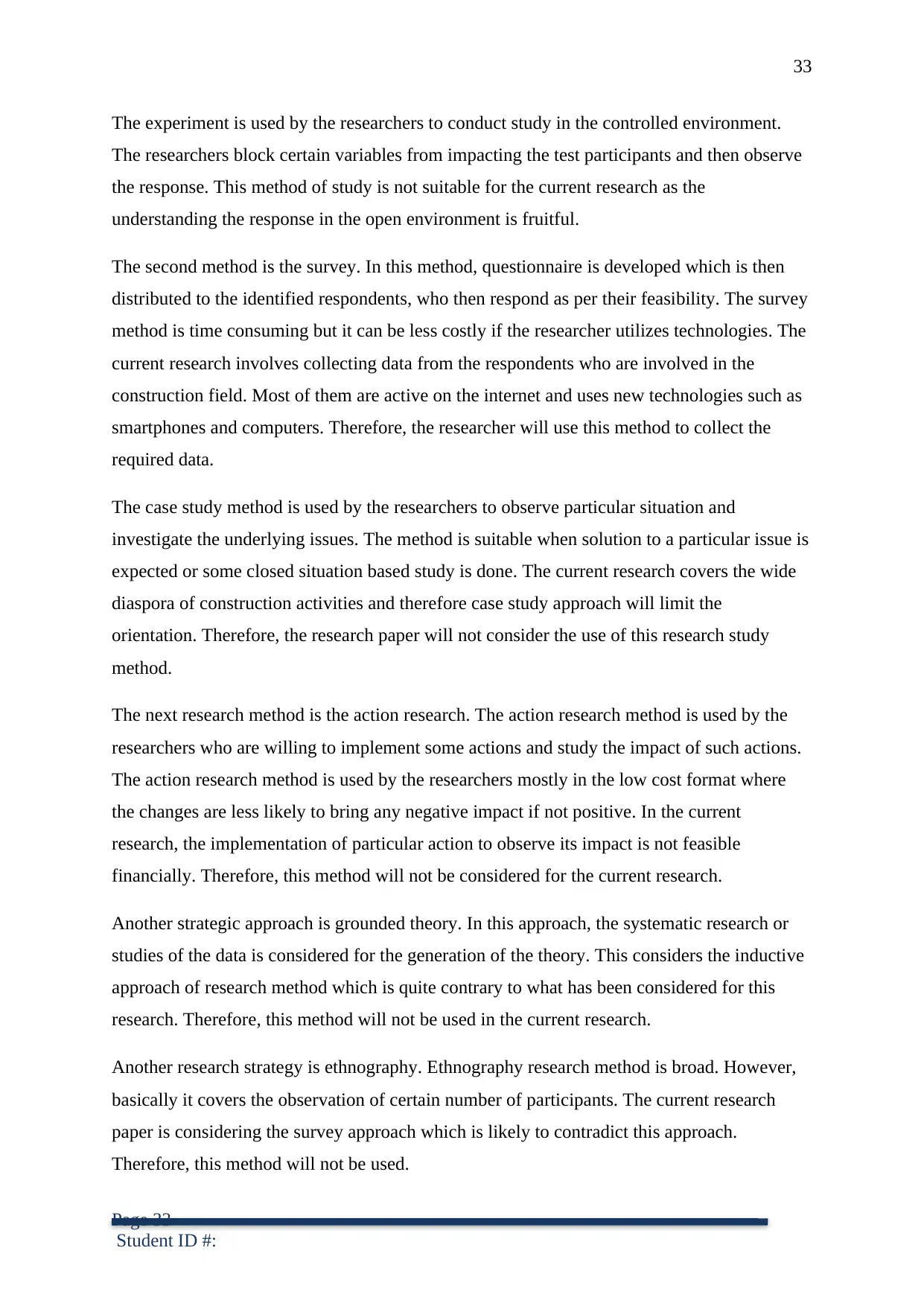
33
The experiment is used by the researchers to conduct study in the controlled environment.
The researchers block certain variables from impacting the test participants and then observe
the response. This method of study is not suitable for the current research as the
understanding the response in the open environment is fruitful.
The second method is the survey. In this method, questionnaire is developed which is then
distributed to the identified respondents, who then respond as per their feasibility. The survey
method is time consuming but it can be less costly if the researcher utilizes technologies. The
current research involves collecting data from the respondents who are involved in the
construction field. Most of them are active on the internet and uses new technologies such as
smartphones and computers. Therefore, the researcher will use this method to collect the
required data.
The case study method is used by the researchers to observe particular situation and
investigate the underlying issues. The method is suitable when solution to a particular issue is
expected or some closed situation based study is done. The current research covers the wide
diaspora of construction activities and therefore case study approach will limit the
orientation. Therefore, the research paper will not consider the use of this research study
method.
The next research method is the action research. The action research method is used by the
researchers who are willing to implement some actions and study the impact of such actions.
The action research method is used by the researchers mostly in the low cost format where
the changes are less likely to bring any negative impact if not positive. In the current
research, the implementation of particular action to observe its impact is not feasible
financially. Therefore, this method will not be considered for the current research.
Another strategic approach is grounded theory. In this approach, the systematic research or
studies of the data is considered for the generation of the theory. This considers the inductive
approach of research method which is quite contrary to what has been considered for this
research. Therefore, this method will not be used in the current research.
Another research strategy is ethnography. Ethnography research method is broad. However,
basically it covers the observation of certain number of participants. The current research
paper is considering the survey approach which is likely to contradict this approach.
Therefore, this method will not be used.
Page 33
Student ID #:
The experiment is used by the researchers to conduct study in the controlled environment.
The researchers block certain variables from impacting the test participants and then observe
the response. This method of study is not suitable for the current research as the
understanding the response in the open environment is fruitful.
The second method is the survey. In this method, questionnaire is developed which is then
distributed to the identified respondents, who then respond as per their feasibility. The survey
method is time consuming but it can be less costly if the researcher utilizes technologies. The
current research involves collecting data from the respondents who are involved in the
construction field. Most of them are active on the internet and uses new technologies such as
smartphones and computers. Therefore, the researcher will use this method to collect the
required data.
The case study method is used by the researchers to observe particular situation and
investigate the underlying issues. The method is suitable when solution to a particular issue is
expected or some closed situation based study is done. The current research covers the wide
diaspora of construction activities and therefore case study approach will limit the
orientation. Therefore, the research paper will not consider the use of this research study
method.
The next research method is the action research. The action research method is used by the
researchers who are willing to implement some actions and study the impact of such actions.
The action research method is used by the researchers mostly in the low cost format where
the changes are less likely to bring any negative impact if not positive. In the current
research, the implementation of particular action to observe its impact is not feasible
financially. Therefore, this method will not be considered for the current research.
Another strategic approach is grounded theory. In this approach, the systematic research or
studies of the data is considered for the generation of the theory. This considers the inductive
approach of research method which is quite contrary to what has been considered for this
research. Therefore, this method will not be used in the current research.
Another research strategy is ethnography. Ethnography research method is broad. However,
basically it covers the observation of certain number of participants. The current research
paper is considering the survey approach which is likely to contradict this approach.
Therefore, this method will not be used.
Page 33
Student ID #:
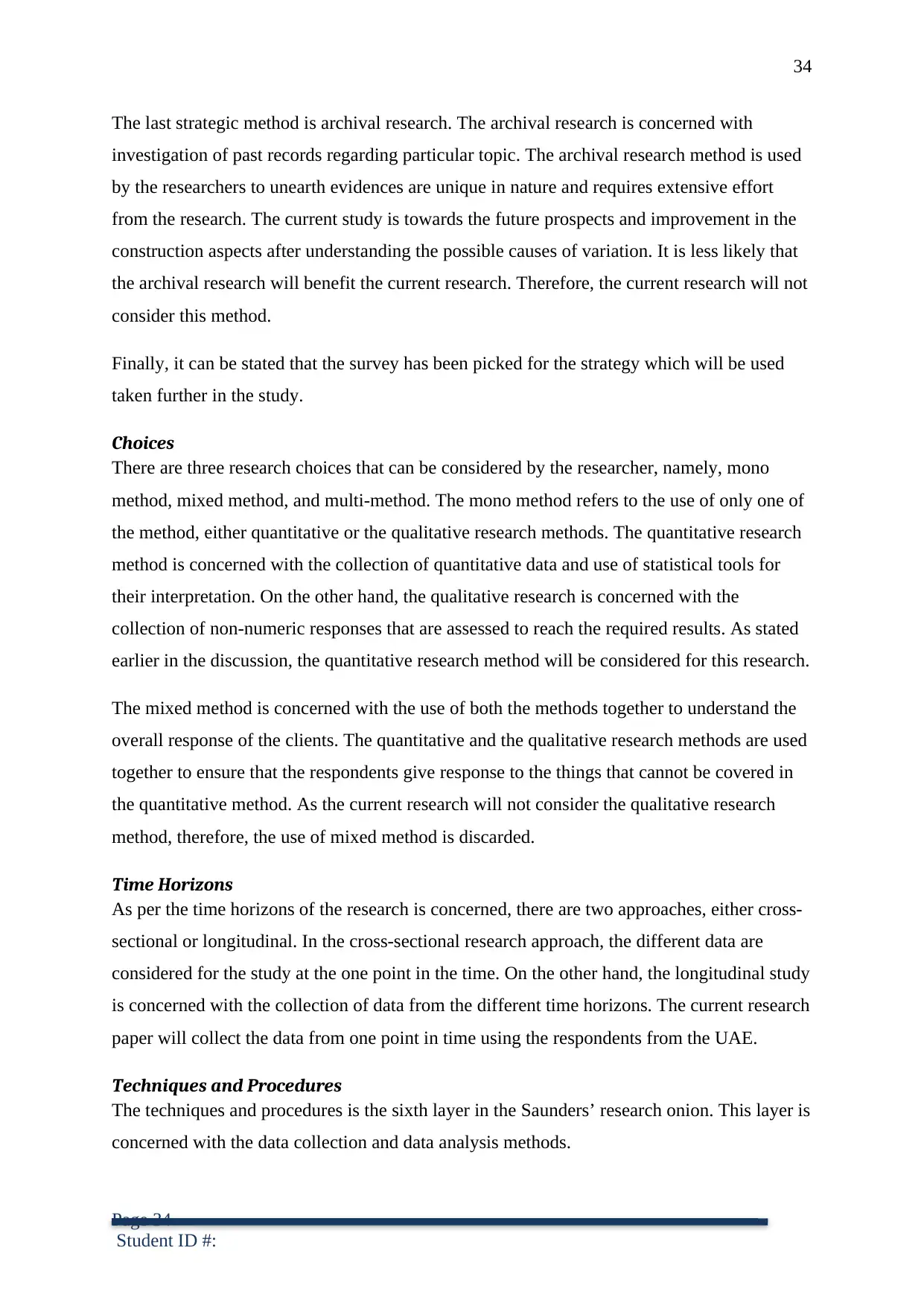
34
The last strategic method is archival research. The archival research is concerned with
investigation of past records regarding particular topic. The archival research method is used
by the researchers to unearth evidences are unique in nature and requires extensive effort
from the research. The current study is towards the future prospects and improvement in the
construction aspects after understanding the possible causes of variation. It is less likely that
the archival research will benefit the current research. Therefore, the current research will not
consider this method.
Finally, it can be stated that the survey has been picked for the strategy which will be used
taken further in the study.
Choices
There are three research choices that can be considered by the researcher, namely, mono
method, mixed method, and multi-method. The mono method refers to the use of only one of
the method, either quantitative or the qualitative research methods. The quantitative research
method is concerned with the collection of quantitative data and use of statistical tools for
their interpretation. On the other hand, the qualitative research is concerned with the
collection of non-numeric responses that are assessed to reach the required results. As stated
earlier in the discussion, the quantitative research method will be considered for this research.
The mixed method is concerned with the use of both the methods together to understand the
overall response of the clients. The quantitative and the qualitative research methods are used
together to ensure that the respondents give response to the things that cannot be covered in
the quantitative method. As the current research will not consider the qualitative research
method, therefore, the use of mixed method is discarded.
Time Horizons
As per the time horizons of the research is concerned, there are two approaches, either cross-
sectional or longitudinal. In the cross-sectional research approach, the different data are
considered for the study at the one point in the time. On the other hand, the longitudinal study
is concerned with the collection of data from the different time horizons. The current research
paper will collect the data from one point in time using the respondents from the UAE.
Techniques and Procedures
The techniques and procedures is the sixth layer in the Saunders’ research onion. This layer is
concerned with the data collection and data analysis methods.
Page 34
Student ID #:
The last strategic method is archival research. The archival research is concerned with
investigation of past records regarding particular topic. The archival research method is used
by the researchers to unearth evidences are unique in nature and requires extensive effort
from the research. The current study is towards the future prospects and improvement in the
construction aspects after understanding the possible causes of variation. It is less likely that
the archival research will benefit the current research. Therefore, the current research will not
consider this method.
Finally, it can be stated that the survey has been picked for the strategy which will be used
taken further in the study.
Choices
There are three research choices that can be considered by the researcher, namely, mono
method, mixed method, and multi-method. The mono method refers to the use of only one of
the method, either quantitative or the qualitative research methods. The quantitative research
method is concerned with the collection of quantitative data and use of statistical tools for
their interpretation. On the other hand, the qualitative research is concerned with the
collection of non-numeric responses that are assessed to reach the required results. As stated
earlier in the discussion, the quantitative research method will be considered for this research.
The mixed method is concerned with the use of both the methods together to understand the
overall response of the clients. The quantitative and the qualitative research methods are used
together to ensure that the respondents give response to the things that cannot be covered in
the quantitative method. As the current research will not consider the qualitative research
method, therefore, the use of mixed method is discarded.
Time Horizons
As per the time horizons of the research is concerned, there are two approaches, either cross-
sectional or longitudinal. In the cross-sectional research approach, the different data are
considered for the study at the one point in the time. On the other hand, the longitudinal study
is concerned with the collection of data from the different time horizons. The current research
paper will collect the data from one point in time using the respondents from the UAE.
Techniques and Procedures
The techniques and procedures is the sixth layer in the Saunders’ research onion. This layer is
concerned with the data collection and data analysis methods.
Page 34
Student ID #:
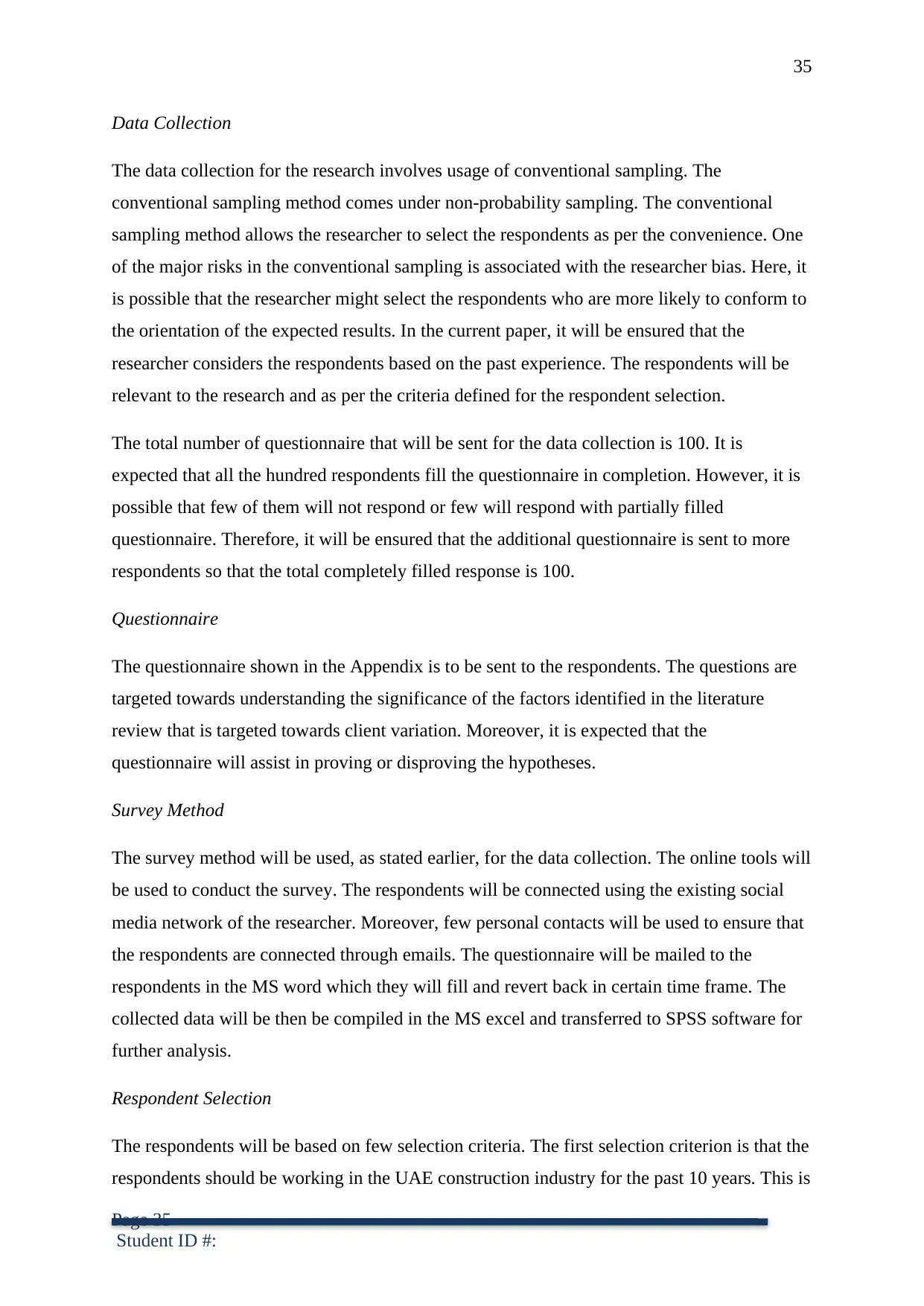
35
Data Collection
The data collection for the research involves usage of conventional sampling. The
conventional sampling method comes under non-probability sampling. The conventional
sampling method allows the researcher to select the respondents as per the convenience. One
of the major risks in the conventional sampling is associated with the researcher bias. Here, it
is possible that the researcher might select the respondents who are more likely to conform to
the orientation of the expected results. In the current paper, it will be ensured that the
researcher considers the respondents based on the past experience. The respondents will be
relevant to the research and as per the criteria defined for the respondent selection.
The total number of questionnaire that will be sent for the data collection is 100. It is
expected that all the hundred respondents fill the questionnaire in completion. However, it is
possible that few of them will not respond or few will respond with partially filled
questionnaire. Therefore, it will be ensured that the additional questionnaire is sent to more
respondents so that the total completely filled response is 100.
Questionnaire
The questionnaire shown in the Appendix is to be sent to the respondents. The questions are
targeted towards understanding the significance of the factors identified in the literature
review that is targeted towards client variation. Moreover, it is expected that the
questionnaire will assist in proving or disproving the hypotheses.
Survey Method
The survey method will be used, as stated earlier, for the data collection. The online tools will
be used to conduct the survey. The respondents will be connected using the existing social
media network of the researcher. Moreover, few personal contacts will be used to ensure that
the respondents are connected through emails. The questionnaire will be mailed to the
respondents in the MS word which they will fill and revert back in certain time frame. The
collected data will be then be compiled in the MS excel and transferred to SPSS software for
further analysis.
Respondent Selection
The respondents will be based on few selection criteria. The first selection criterion is that the
respondents should be working in the UAE construction industry for the past 10 years. This is
Page 35
Student ID #:
Data Collection
The data collection for the research involves usage of conventional sampling. The
conventional sampling method comes under non-probability sampling. The conventional
sampling method allows the researcher to select the respondents as per the convenience. One
of the major risks in the conventional sampling is associated with the researcher bias. Here, it
is possible that the researcher might select the respondents who are more likely to conform to
the orientation of the expected results. In the current paper, it will be ensured that the
researcher considers the respondents based on the past experience. The respondents will be
relevant to the research and as per the criteria defined for the respondent selection.
The total number of questionnaire that will be sent for the data collection is 100. It is
expected that all the hundred respondents fill the questionnaire in completion. However, it is
possible that few of them will not respond or few will respond with partially filled
questionnaire. Therefore, it will be ensured that the additional questionnaire is sent to more
respondents so that the total completely filled response is 100.
Questionnaire
The questionnaire shown in the Appendix is to be sent to the respondents. The questions are
targeted towards understanding the significance of the factors identified in the literature
review that is targeted towards client variation. Moreover, it is expected that the
questionnaire will assist in proving or disproving the hypotheses.
Survey Method
The survey method will be used, as stated earlier, for the data collection. The online tools will
be used to conduct the survey. The respondents will be connected using the existing social
media network of the researcher. Moreover, few personal contacts will be used to ensure that
the respondents are connected through emails. The questionnaire will be mailed to the
respondents in the MS word which they will fill and revert back in certain time frame. The
collected data will be then be compiled in the MS excel and transferred to SPSS software for
further analysis.
Respondent Selection
The respondents will be based on few selection criteria. The first selection criterion is that the
respondents should be working in the UAE construction industry for the past 10 years. This is
Page 35
Student ID #:
Paraphrase This Document
Need a fresh take? Get an instant paraphrase of this document with our AI Paraphraser
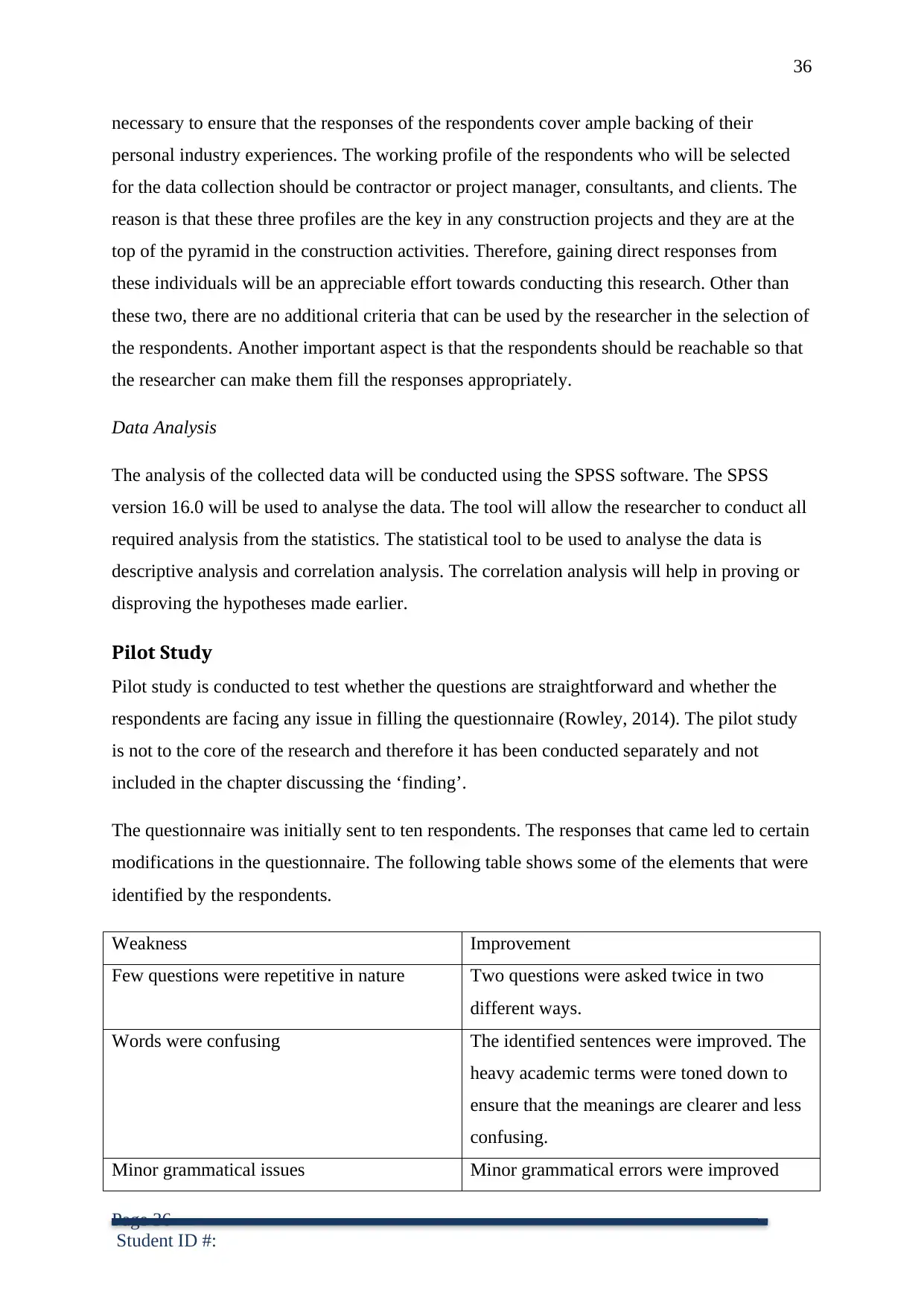
36
necessary to ensure that the responses of the respondents cover ample backing of their
personal industry experiences. The working profile of the respondents who will be selected
for the data collection should be contractor or project manager, consultants, and clients. The
reason is that these three profiles are the key in any construction projects and they are at the
top of the pyramid in the construction activities. Therefore, gaining direct responses from
these individuals will be an appreciable effort towards conducting this research. Other than
these two, there are no additional criteria that can be used by the researcher in the selection of
the respondents. Another important aspect is that the respondents should be reachable so that
the researcher can make them fill the responses appropriately.
Data Analysis
The analysis of the collected data will be conducted using the SPSS software. The SPSS
version 16.0 will be used to analyse the data. The tool will allow the researcher to conduct all
required analysis from the statistics. The statistical tool to be used to analyse the data is
descriptive analysis and correlation analysis. The correlation analysis will help in proving or
disproving the hypotheses made earlier.
Pilot Study
Pilot study is conducted to test whether the questions are straightforward and whether the
respondents are facing any issue in filling the questionnaire (Rowley, 2014). The pilot study
is not to the core of the research and therefore it has been conducted separately and not
included in the chapter discussing the ‘finding’.
The questionnaire was initially sent to ten respondents. The responses that came led to certain
modifications in the questionnaire. The following table shows some of the elements that were
identified by the respondents.
Weakness Improvement
Few questions were repetitive in nature Two questions were asked twice in two
different ways.
Words were confusing The identified sentences were improved. The
heavy academic terms were toned down to
ensure that the meanings are clearer and less
confusing.
Minor grammatical issues Minor grammatical errors were improved
Page 36
Student ID #:
necessary to ensure that the responses of the respondents cover ample backing of their
personal industry experiences. The working profile of the respondents who will be selected
for the data collection should be contractor or project manager, consultants, and clients. The
reason is that these three profiles are the key in any construction projects and they are at the
top of the pyramid in the construction activities. Therefore, gaining direct responses from
these individuals will be an appreciable effort towards conducting this research. Other than
these two, there are no additional criteria that can be used by the researcher in the selection of
the respondents. Another important aspect is that the respondents should be reachable so that
the researcher can make them fill the responses appropriately.
Data Analysis
The analysis of the collected data will be conducted using the SPSS software. The SPSS
version 16.0 will be used to analyse the data. The tool will allow the researcher to conduct all
required analysis from the statistics. The statistical tool to be used to analyse the data is
descriptive analysis and correlation analysis. The correlation analysis will help in proving or
disproving the hypotheses made earlier.
Pilot Study
Pilot study is conducted to test whether the questions are straightforward and whether the
respondents are facing any issue in filling the questionnaire (Rowley, 2014). The pilot study
is not to the core of the research and therefore it has been conducted separately and not
included in the chapter discussing the ‘finding’.
The questionnaire was initially sent to ten respondents. The responses that came led to certain
modifications in the questionnaire. The following table shows some of the elements that were
identified by the respondents.
Weakness Improvement
Few questions were repetitive in nature Two questions were asked twice in two
different ways.
Words were confusing The identified sentences were improved. The
heavy academic terms were toned down to
ensure that the meanings are clearer and less
confusing.
Minor grammatical issues Minor grammatical errors were improved
Page 36
Student ID #:
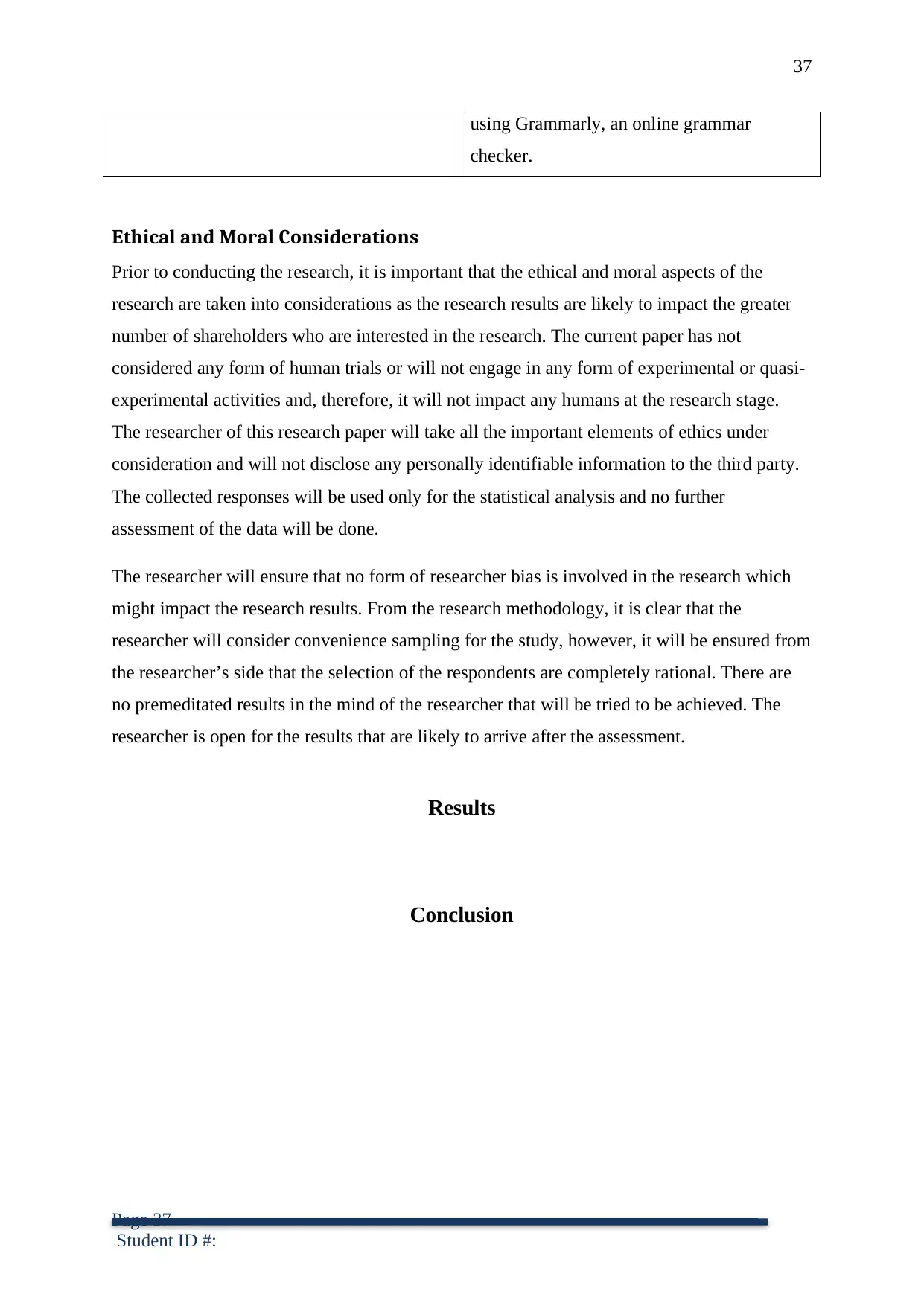
37
using Grammarly, an online grammar
checker.
Ethical and Moral Considerations
Prior to conducting the research, it is important that the ethical and moral aspects of the
research are taken into considerations as the research results are likely to impact the greater
number of shareholders who are interested in the research. The current paper has not
considered any form of human trials or will not engage in any form of experimental or quasi-
experimental activities and, therefore, it will not impact any humans at the research stage.
The researcher of this research paper will take all the important elements of ethics under
consideration and will not disclose any personally identifiable information to the third party.
The collected responses will be used only for the statistical analysis and no further
assessment of the data will be done.
The researcher will ensure that no form of researcher bias is involved in the research which
might impact the research results. From the research methodology, it is clear that the
researcher will consider convenience sampling for the study, however, it will be ensured from
the researcher’s side that the selection of the respondents are completely rational. There are
no premeditated results in the mind of the researcher that will be tried to be achieved. The
researcher is open for the results that are likely to arrive after the assessment.
Results
Conclusion
Page 37
Student ID #:
using Grammarly, an online grammar
checker.
Ethical and Moral Considerations
Prior to conducting the research, it is important that the ethical and moral aspects of the
research are taken into considerations as the research results are likely to impact the greater
number of shareholders who are interested in the research. The current paper has not
considered any form of human trials or will not engage in any form of experimental or quasi-
experimental activities and, therefore, it will not impact any humans at the research stage.
The researcher of this research paper will take all the important elements of ethics under
consideration and will not disclose any personally identifiable information to the third party.
The collected responses will be used only for the statistical analysis and no further
assessment of the data will be done.
The researcher will ensure that no form of researcher bias is involved in the research which
might impact the research results. From the research methodology, it is clear that the
researcher will consider convenience sampling for the study, however, it will be ensured from
the researcher’s side that the selection of the respondents are completely rational. There are
no premeditated results in the mind of the researcher that will be tried to be achieved. The
researcher is open for the results that are likely to arrive after the assessment.
Results
Conclusion
Page 37
Student ID #:
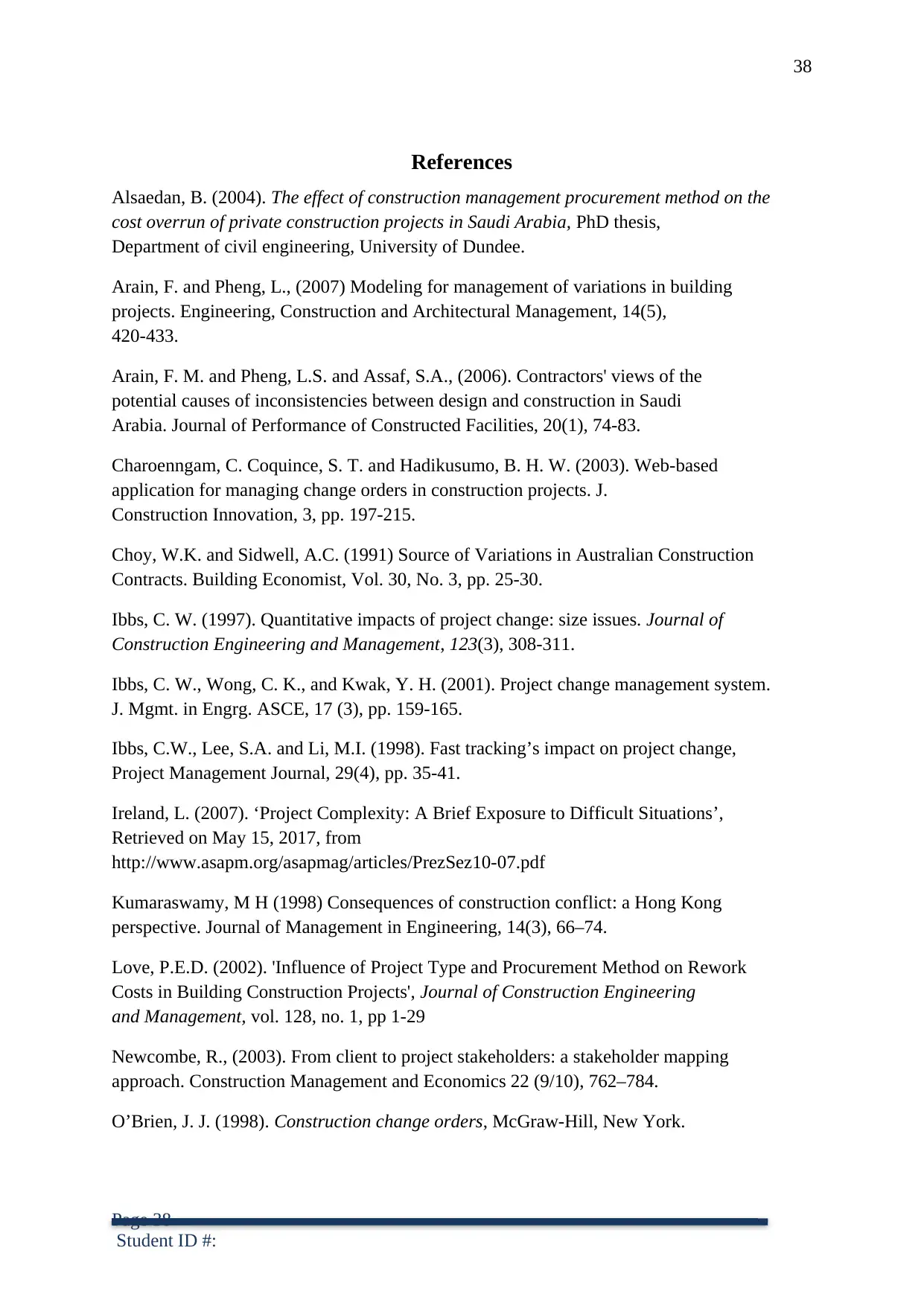
38
References
Alsaedan, B. (2004). The effect of construction management procurement method on the
cost overrun of private construction projects in Saudi Arabia, PhD thesis,
Department of civil engineering, University of Dundee.
Arain, F. and Pheng, L., (2007) Modeling for management of variations in building
projects. Engineering, Construction and Architectural Management, 14(5),
420-433.
Arain, F. M. and Pheng, L.S. and Assaf, S.A., (2006). Contractors' views of the
potential causes of inconsistencies between design and construction in Saudi
Arabia. Journal of Performance of Constructed Facilities, 20(1), 74-83.
Charoenngam, C. Coquince, S. T. and Hadikusumo, B. H. W. (2003). Web-based
application for managing change orders in construction projects. J.
Construction Innovation, 3, pp. 197-215.
Choy, W.K. and Sidwell, A.C. (1991) Source of Variations in Australian Construction
Contracts. Building Economist, Vol. 30, No. 3, pp. 25-30.
Ibbs, C. W. (1997). Quantitative impacts of project change: size issues. Journal of
Construction Engineering and Management, 123(3), 308-311.
Ibbs, C. W., Wong, C. K., and Kwak, Y. H. (2001). Project change management system.
J. Mgmt. in Engrg. ASCE, 17 (3), pp. 159-165.
Ibbs, C.W., Lee, S.A. and Li, M.I. (1998). Fast tracking’s impact on project change,
Project Management Journal, 29(4), pp. 35-41.
Ireland, L. (2007). ‘Project Complexity: A Brief Exposure to Difficult Situations’,
Retrieved on May 15, 2017, from
http://www.asapm.org/asapmag/articles/PrezSez10-07.pdf
Kumaraswamy, M H (1998) Consequences of construction conflict: a Hong Kong
perspective. Journal of Management in Engineering, 14(3), 66–74.
Love, P.E.D. (2002). 'Influence of Project Type and Procurement Method on Rework
Costs in Building Construction Projects', Journal of Construction Engineering
and Management, vol. 128, no. 1, pp 1-29
Newcombe, R., (2003). From client to project stakeholders: a stakeholder mapping
approach. Construction Management and Economics 22 (9/10), 762–784.
O’Brien, J. J. (1998). Construction change orders, McGraw-Hill, New York.
Page 38
Student ID #:
References
Alsaedan, B. (2004). The effect of construction management procurement method on the
cost overrun of private construction projects in Saudi Arabia, PhD thesis,
Department of civil engineering, University of Dundee.
Arain, F. and Pheng, L., (2007) Modeling for management of variations in building
projects. Engineering, Construction and Architectural Management, 14(5),
420-433.
Arain, F. M. and Pheng, L.S. and Assaf, S.A., (2006). Contractors' views of the
potential causes of inconsistencies between design and construction in Saudi
Arabia. Journal of Performance of Constructed Facilities, 20(1), 74-83.
Charoenngam, C. Coquince, S. T. and Hadikusumo, B. H. W. (2003). Web-based
application for managing change orders in construction projects. J.
Construction Innovation, 3, pp. 197-215.
Choy, W.K. and Sidwell, A.C. (1991) Source of Variations in Australian Construction
Contracts. Building Economist, Vol. 30, No. 3, pp. 25-30.
Ibbs, C. W. (1997). Quantitative impacts of project change: size issues. Journal of
Construction Engineering and Management, 123(3), 308-311.
Ibbs, C. W., Wong, C. K., and Kwak, Y. H. (2001). Project change management system.
J. Mgmt. in Engrg. ASCE, 17 (3), pp. 159-165.
Ibbs, C.W., Lee, S.A. and Li, M.I. (1998). Fast tracking’s impact on project change,
Project Management Journal, 29(4), pp. 35-41.
Ireland, L. (2007). ‘Project Complexity: A Brief Exposure to Difficult Situations’,
Retrieved on May 15, 2017, from
http://www.asapm.org/asapmag/articles/PrezSez10-07.pdf
Kumaraswamy, M H (1998) Consequences of construction conflict: a Hong Kong
perspective. Journal of Management in Engineering, 14(3), 66–74.
Love, P.E.D. (2002). 'Influence of Project Type and Procurement Method on Rework
Costs in Building Construction Projects', Journal of Construction Engineering
and Management, vol. 128, no. 1, pp 1-29
Newcombe, R., (2003). From client to project stakeholders: a stakeholder mapping
approach. Construction Management and Economics 22 (9/10), 762–784.
O’Brien, J. J. (1998). Construction change orders, McGraw-Hill, New York.
Page 38
Student ID #:
Secure Best Marks with AI Grader
Need help grading? Try our AI Grader for instant feedback on your assignments.
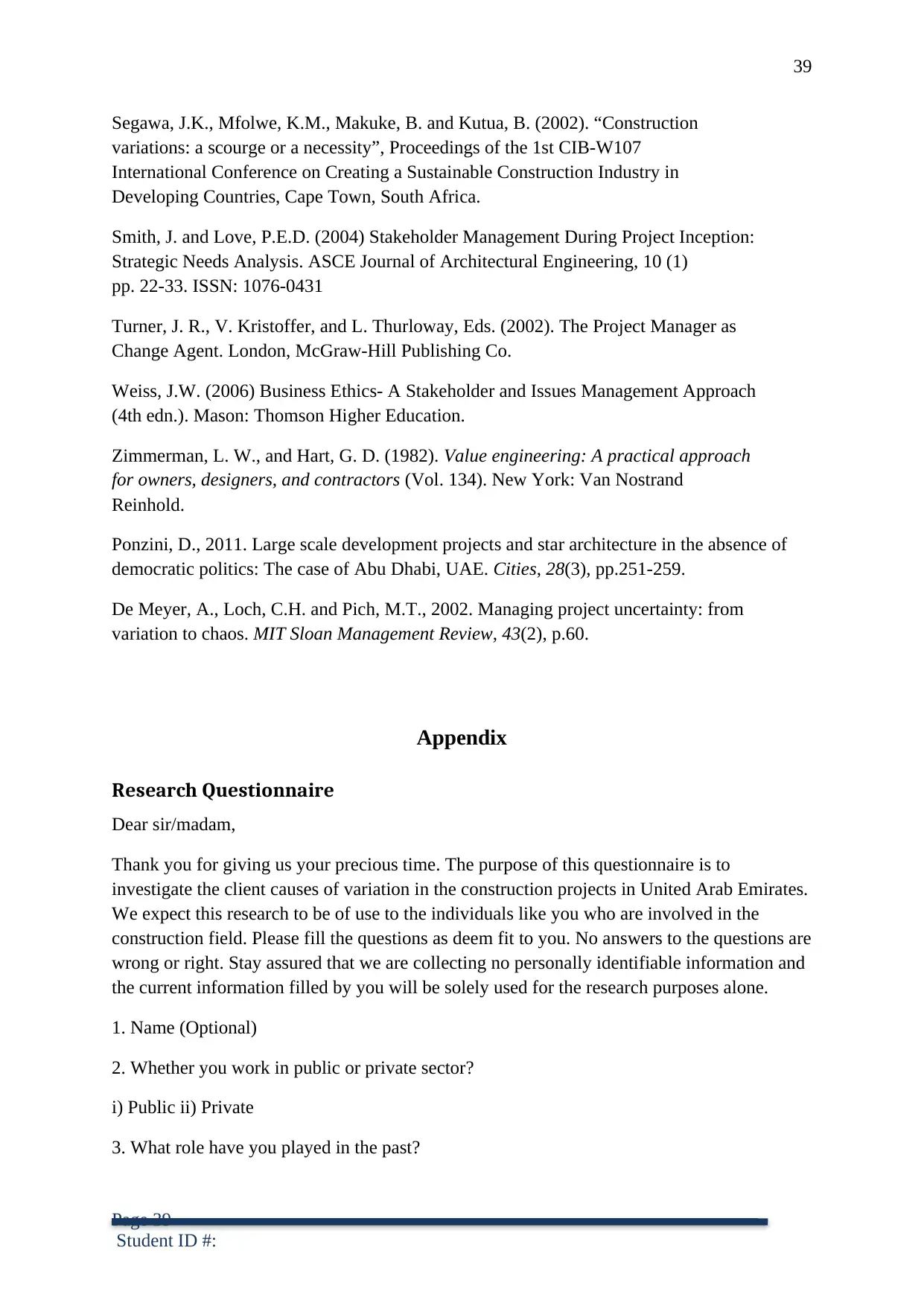
39
Segawa, J.K., Mfolwe, K.M., Makuke, B. and Kutua, B. (2002). “Construction
variations: a scourge or a necessity”, Proceedings of the 1st CIB-W107
International Conference on Creating a Sustainable Construction Industry in
Developing Countries, Cape Town, South Africa.
Smith, J. and Love, P.E.D. (2004) Stakeholder Management During Project Inception:
Strategic Needs Analysis. ASCE Journal of Architectural Engineering, 10 (1)
pp. 22-33. ISSN: 1076-0431
Turner, J. R., V. Kristoffer, and L. Thurloway, Eds. (2002). The Project Manager as
Change Agent. London, McGraw-Hill Publishing Co.
Weiss, J.W. (2006) Business Ethics- A Stakeholder and Issues Management Approach
(4th edn.). Mason: Thomson Higher Education.
Zimmerman, L. W., and Hart, G. D. (1982). Value engineering: A practical approach
for owners, designers, and contractors (Vol. 134). New York: Van Nostrand
Reinhold.
Ponzini, D., 2011. Large scale development projects and star architecture in the absence of
democratic politics: The case of Abu Dhabi, UAE. Cities, 28(3), pp.251-259.
De Meyer, A., Loch, C.H. and Pich, M.T., 2002. Managing project uncertainty: from
variation to chaos. MIT Sloan Management Review, 43(2), p.60.
Appendix
Research Questionnaire
Dear sir/madam,
Thank you for giving us your precious time. The purpose of this questionnaire is to
investigate the client causes of variation in the construction projects in United Arab Emirates.
We expect this research to be of use to the individuals like you who are involved in the
construction field. Please fill the questions as deem fit to you. No answers to the questions are
wrong or right. Stay assured that we are collecting no personally identifiable information and
the current information filled by you will be solely used for the research purposes alone.
1. Name (Optional)
2. Whether you work in public or private sector?
i) Public ii) Private
3. What role have you played in the past?
Page 39
Student ID #:
Segawa, J.K., Mfolwe, K.M., Makuke, B. and Kutua, B. (2002). “Construction
variations: a scourge or a necessity”, Proceedings of the 1st CIB-W107
International Conference on Creating a Sustainable Construction Industry in
Developing Countries, Cape Town, South Africa.
Smith, J. and Love, P.E.D. (2004) Stakeholder Management During Project Inception:
Strategic Needs Analysis. ASCE Journal of Architectural Engineering, 10 (1)
pp. 22-33. ISSN: 1076-0431
Turner, J. R., V. Kristoffer, and L. Thurloway, Eds. (2002). The Project Manager as
Change Agent. London, McGraw-Hill Publishing Co.
Weiss, J.W. (2006) Business Ethics- A Stakeholder and Issues Management Approach
(4th edn.). Mason: Thomson Higher Education.
Zimmerman, L. W., and Hart, G. D. (1982). Value engineering: A practical approach
for owners, designers, and contractors (Vol. 134). New York: Van Nostrand
Reinhold.
Ponzini, D., 2011. Large scale development projects and star architecture in the absence of
democratic politics: The case of Abu Dhabi, UAE. Cities, 28(3), pp.251-259.
De Meyer, A., Loch, C.H. and Pich, M.T., 2002. Managing project uncertainty: from
variation to chaos. MIT Sloan Management Review, 43(2), p.60.
Appendix
Research Questionnaire
Dear sir/madam,
Thank you for giving us your precious time. The purpose of this questionnaire is to
investigate the client causes of variation in the construction projects in United Arab Emirates.
We expect this research to be of use to the individuals like you who are involved in the
construction field. Please fill the questions as deem fit to you. No answers to the questions are
wrong or right. Stay assured that we are collecting no personally identifiable information and
the current information filled by you will be solely used for the research purposes alone.
1. Name (Optional)
2. Whether you work in public or private sector?
i) Public ii) Private
3. What role have you played in the past?
Page 39
Student ID #:
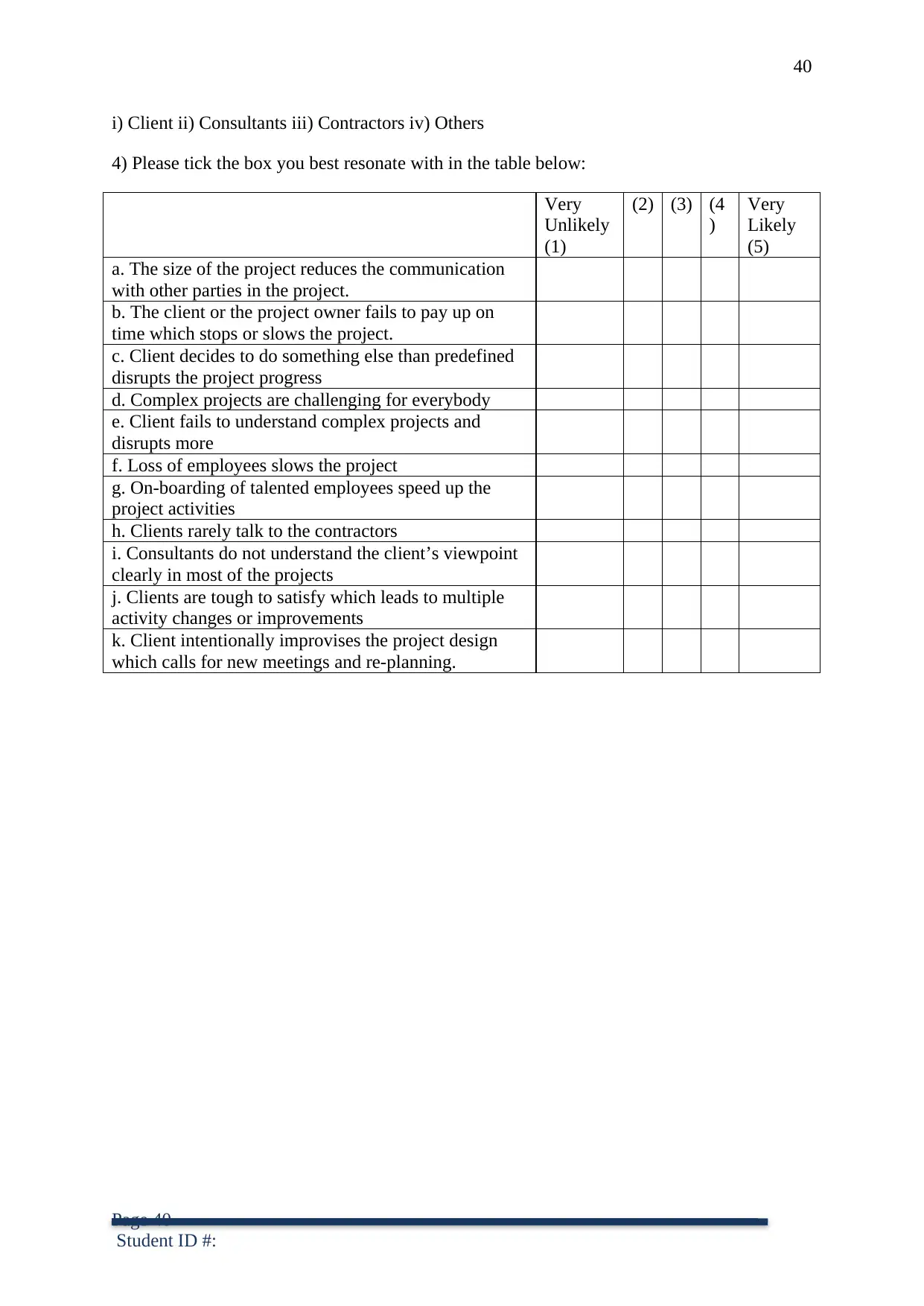
40
i) Client ii) Consultants iii) Contractors iv) Others
4) Please tick the box you best resonate with in the table below:
Very
Unlikely
(1)
(2) (3) (4
)
Very
Likely
(5)
a. The size of the project reduces the communication
with other parties in the project.
b. The client or the project owner fails to pay up on
time which stops or slows the project.
c. Client decides to do something else than predefined
disrupts the project progress
d. Complex projects are challenging for everybody
e. Client fails to understand complex projects and
disrupts more
f. Loss of employees slows the project
g. On-boarding of talented employees speed up the
project activities
h. Clients rarely talk to the contractors
i. Consultants do not understand the client’s viewpoint
clearly in most of the projects
j. Clients are tough to satisfy which leads to multiple
activity changes or improvements
k. Client intentionally improvises the project design
which calls for new meetings and re-planning.
Page 40
Student ID #:
i) Client ii) Consultants iii) Contractors iv) Others
4) Please tick the box you best resonate with in the table below:
Very
Unlikely
(1)
(2) (3) (4
)
Very
Likely
(5)
a. The size of the project reduces the communication
with other parties in the project.
b. The client or the project owner fails to pay up on
time which stops or slows the project.
c. Client decides to do something else than predefined
disrupts the project progress
d. Complex projects are challenging for everybody
e. Client fails to understand complex projects and
disrupts more
f. Loss of employees slows the project
g. On-boarding of talented employees speed up the
project activities
h. Clients rarely talk to the contractors
i. Consultants do not understand the client’s viewpoint
clearly in most of the projects
j. Clients are tough to satisfy which leads to multiple
activity changes or improvements
k. Client intentionally improvises the project design
which calls for new meetings and re-planning.
Page 40
Student ID #:
1 out of 42
Related Documents
Your All-in-One AI-Powered Toolkit for Academic Success.
+13062052269
info@desklib.com
Available 24*7 on WhatsApp / Email
![[object Object]](/_next/static/media/star-bottom.7253800d.svg)
Unlock your academic potential
© 2024 | Zucol Services PVT LTD | All rights reserved.





